GoGold Resources (GGD.TO, C$0.71) is a company with assets in Mexico, both a producing and an exploration-stage project. Led by a management team that has over 27 years of experience in the country. The team developed 4 projects/companies that eventually got sold with at a good to hefty premium. Examples are: Gammon Gold ($1.5B merge with Alamos), Mexgold (sold for $375M), Nayarit ($80M, bought for $40M) and recently, the Santa Gertrudis project they sold to AEM for $96M (bought for $11M).
CEO Brad Langille is the second largest shareholder and holds 9.5% of outstanding shares. Biggest shareholder is Fred George, who was founding member of Gammon Gold. He led the development of the Ocampo project from exploration stage to one of the biggest silver and gold projects in Mexico, currently operated by Minera Frisco. Fred George owns about 14% of outstanding shares. Management combined owns over 30%.
Financial position is strong as they had C$9M in liquidity (cash + Metalla shares) at the end of the second quarter. After finishing the sale of the Santa Gertrudis project, they decided to pay off their remaining debt which leaves them debt-free.
Parral
After the sale of Santa Gertrudis, GoGold has two projects left. One of them is the young producing heap leaching mine of Parral, which is right next to the Mexican city of Chihuahua. This mine started its fifth year and is currently on a record streak: For the second consecutive quarter a beat in production and well on its way to reach 1.8Moz of silver equivalent. AISC is declining and currently sits at US$13.61/oz. Their realized silver price for the quarter was US$14.55, which gave them a 6.9% margin in Q2. As silver is a lot higher now than in Q2, we can assume a conservative realized price of US$17/oz for Q3. If AISC remains the same, their margin would rise to 24.9% or an increase of 261% quarter over quarter.
In June of this year, the company announced the build of a SART installation at their Parral mine. This will help lower costs of heap leaching and provide a saleable copper concentrate. This plant will see its first full operational quarter in Q1 of 2020. This should give a substantial decrease in AISC and add some revenue through the copper concentrate.
Their Parral mine will allow them to internally finance their exploration. Shareholders are protected from dilution through capital raises. In coming quarters, production will continue to rise towards 550-600Koz AgEq. Q2 saw 440Koz so we can expect further “records” in coming headlines. During my contact with management I received the following words:
“The cashflow we produce form Parral will fund our operations, G&A, and our exploration at Los Ricos and this is why we say we are a self-funding junior and do not need to raise money for the foreseeable future.”
Parral has a remaining mine life of 8 years and the proportion silver/gold in dollar value is about 55% silver and 45% gold. So despite of what you might read in their name, GoGold is mostly a silver producer.
Los Ricos
The Los Ricos project is my main reason to hold GoGold in my portfolio. The project has seen commercial production between 1908-1929. Production has been terminated at the start of the Great Depression. At the time of production, they kept track of the production data. Through this data we learn that the project was mined to a depth of 500m on different levels. Average values of 800g/t silver and 4g/t gold.
The project has about 65 historic drill results, which GoGold is trying to confirm with their own drill program. Up until today, they are succeeding well in this. Best hit: 21m of 7.66g/t gold and 1,270g/t silver (or 21m of 24.6g/t AuEq). Below I added the results of the first 10 drill holes by GoGold. Note that these are all 10 of them and not one has been left out mysteriously. By now the project has expanded to 37 drill results. I looked at all of these: Not one miss and on average thick mineralization with high values of gold and silver.
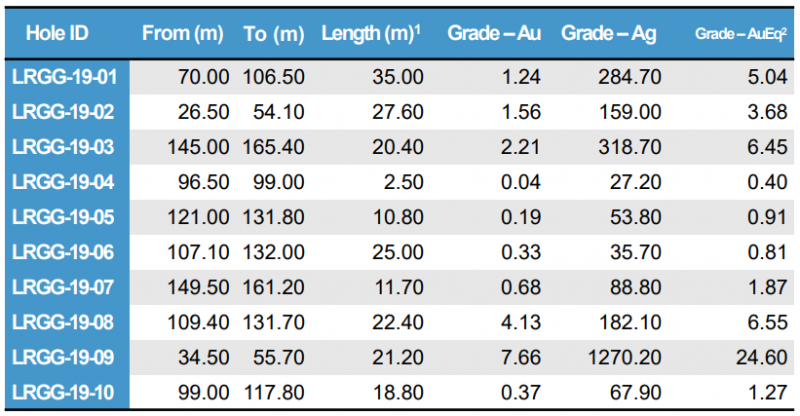
I recently felt an urgency to buy this company and this had nothing to do with silver taking off. In May, the company announced trenching results from a 3.2km strike. In this news release, GoGold told investors they would move a drill to the Cerro Colorado zone. This area has the ‘high priority drill area’ tag attached in the image below. Cerro Colorado is at the end of this strike and 1,500m away from the edge of the main zone.
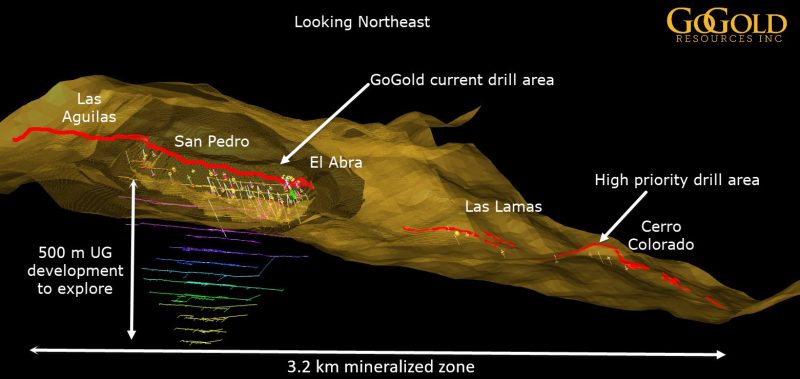
These first results of the Cerro Colorado zone seem to point to a big system. All 7 of these drill results show more high grade and thick gold and silver mineralization. As you can see in the image (above), there’s the ‘Las Lamas’ zone in between that 1,500m stepout. Below you find the results of the trenching GoGold did there. Management confirmed they would drill that target as well.
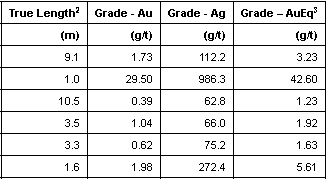
Since GoGold purchased the Los Ricos project, their share price has tripled. The silver price is largely a cause of this, but nonetheless an outperformance in the silver space. The Los Ricos project is a mere 6 months in their posession and the market is starting to notice. Should be, considering these drill results and potential. CEO Brad Langille recently noted that he’s been following this project for over 8 years and feels this is the most exciting project of his carreer. Talk is cheap of course, but seeing he upped his stake by 500,000 shares this year, is reason to take note.
The company is working on a maiden resource for Los Ricos, which they plan on delivering in the first quarter of 2020. Recently, they uploaded a VRIFY model on their website (link: https://gogoldresources.com/properties/los-ricos). CEO Langille wants to roll out this project on the Precious Metals Summit and Denver Gold Forum. Personally I believe this company will get some interest over the course of the next weeks. These presentations should be the start of this.
CEO Langille sees the Los Ricos project as an open pit mine with multi million ounces of high grade gold and silver. According to him this will be of similar, if not bigger size than the Ocampo mine which he helped build and eventually was valued at US$750M. Again, quotes like these are only to be given weight if supported by elevated insider ownership and preferably insider open market purchases. I see both here.
There’s only 1 analyst following this. HC Wainwright that has a current price target of C$0.80/share. Note that this is based on a realized silver price of US$15/oz, gold price of U$1,300 and doesn’t ascribe any value to the Los Ricos project.
Conclusion
- I upped my stake in this company after their Cerro Colorado drill results. I’m comfortable here because of the following reasons:
- Management with proven track record and a lot of their own money in the company
- A producing asset which is seeing rising production and margins
- No need for financing so no dilution
- Big players have to buy in the market, which was confirmed by management
- Los Ricos could be a world class deposit
- Lots of catalysts nearby:
exploration results - promotion of Los Ricos
- rising earnings at ParrJonas De Roose
September 18, 2019
- Is the gold price reaction over?
- Well, since the rally began in the $1170 area, corrections have not lasted very long.
- After rallying to the $1566 area, gold has pulled back to about $1500. Please click here now: https://gracelandupdates.com/wordpress/wp-content/uploads/2019/09/2019sep10gold1.png Double-click to enlarge. Strong trend line support is already in play.
- Investors need to keep an open mind; it’s possible that the $1500 area is now support rather than resistance, and gold is set to rally towards the $1600-$1700 area.
- Please click here now: https://gracelandupdates.com/wordpress/wp-content/uploads/2019/09/2019sep10gold2.png Double-click to enlarge. Note the lows in the $1526 area in the 2011-2012 timeframe.
- Those lows may now be functioning as support as gold reacts from the $1566 area highs. Also, $1500 is a key round number that may now be functioning as support rather than resistance for institutional money managers.
- Indian festival buying may be picking up as well. Indians have been waiting for a decent pullback for months, and now it is here.
- Please click here now: https://gracelandupdates.com/wordpress/wp-content/uploads/2019/09/2019sep10trustydusty.png Double-click to enlarge this GDX swing trade chart.
- I recommend that most gold investors should consider allocating some capital to a swing trade program.
- My guswinger.com system has been in DUST-NYSE as GDX been “spanked”, and it’s now time to book solid profit on at least a portion of the position.
- Note the key low on the GDX chart at $27.61. If it’s violated, GDX could decline to the $26.04 area. Having said that, proper tactics can reduce investor risk dramatically.
- My suggestion to core position enthusiasts is to buy some gold stock now, and more if there is a deeper reaction. A stop order can be placed just under the $27.61 low.
- Investors who don’t like stops can also buy the $27.61 area…with very small size.
- Please click here now: https://gracelandupdates.com/wordpress/wp-content/uploads/2019/09/2019sep10gdx1.png Double-click to enlarge. If the inverse H&S bottom on this weekly GDX chart is legitimate, the current reaction is likely to be very shallow and may already be ending.
- The target of the pattern is about $50. The biggest risk investors face now is not drawdowns, but rather missing out on a major run higher in most of the world’s quality miners!
- Please click here now: https://gracelandupdates.com/wordpress/wp-content/uploads/2019/09/2019sep10trade1.png The global economy continues to weaken, and politicians do nothing but spend, borrow, and beg for more QE and negative rates.
- That’s pouring gas on the fire. Negative rates and QE incentivize governments to go even deeper into debt.
- Please click here now: “In the next credit cycle downturn, then, the generally lower credit quality of today’s speculative-grade population means that the default count could exceed the Great Recession peak of 14% of all rated issuers….” – Christina Padgett, Moody’s VP, Sep 9, 2019.
- This is spectacular news for gold!
- Please click here now: https://gracelandupdates.com/wordpress/wp-content/uploads/2019/09/2019sep10gdxj1.png Double-click to enlarge this GDXJ chart.
- As expected, GDXJ looks a bit more vulnerable than GDX in the short-term. Having said that, it’s important for investors to be as open to a surge above $43 as to a pullback to $33-$35.
- An upside breakout would open the door to a massive run higher, and whether investors pay a “ticket price” of $33 or $43 for their GDXJ ride really doesn’t matter.
- The rise of China and India is not going away. The decline of the West is not going away. These forces are destabilizing the dollar and ushering in a bull era for gold, silver, and associated miners.
- It’s no longer as important to avoid price reactions as it is to stay invested and buy breakouts. As stagflation grows, this gold market will become very similar to the 1970s market… on a much bigger scale!
Special Offer For Website Readers: Please send me an Email to freereports4@gracelandupdates.com and I’ll send you my free “Super Seniors On The Move” report. I highlight key senior miners that are trading under $20 that are showcasing fabulous relative strength versus the gold ETFs. I include important wealth building tactics for investors!
Stewart Thomson
September 11, 2019
Email:
Stewart Thomson is a retired Merrill Lynch broker. Stewart writes the Graceland Updates daily between 4am-7am. They are sent out around 8am-9am. The newsletter is attractively priced and the format is a unique numbered point form. Giving clarity of each point and saving valuable reading time.
Risks, Disclaimers, Legal
Stewart Thomson is no longer an investment advisor. The information provided by Stewart and Graceland Updates is for general information purposes only. Before taking any action on any investment, it is imperative that you consult with multiple properly licensed, experienced and qualified investment advisors and get numerous opinions before taking any action. Your minimum risk on any investment in the world is: 100% loss of all your money. You may be taking or preparing to take leveraged positions in investments and not know it, exposing yourself to unlimited risks. This is highly concerning if you are an investor in any derivatives products. There is an approx $700 trillion OTC Derivatives Iceberg with a tiny portion written off officially. The bottom line:
Are You Prepared?
The gold miners’ stocks have grown very overbought after soaring dramatically higher in recent months. Blasting really far really fast has left this sector really stretched technically and sentimentally. Excessive gains and greed always soon lead to major corrective selloffs, which are necessary to restore balance. All bull markets, even the most powerful, flow and ebb. Big uplegs are inevitably followed by corrections.
With gold and gold stocks plunging hard Thursday morning, the timing of this research thread is certainly lucky. My weekly-web-essay workflow is well-defined, this happens to be the 877th I’ve written. I have to decide on each week’s topic by early Wednesdays, to do the research and build necessary spreadsheets and charts that day.
Even before this latest bout of selling erupted, the serious downside risks facing overbought gold stocks were readily apparent. According to virtually every technical indicator out there, this sector was looking ever-more extreme in recent weeks. The longer and farther gold stocks surged, the greater the odds for a selloff. I warned about this Saturday morning in the conclusion to our latest monthly newsletter for subscribers.
Before the selling hit I wrote, “Gold is overextended, due for a healthy bull-market correction over the near-term. Its technicals are way too overbought, and its sentiment way too greedy. Too many buyers have flooded in too quickly, exhausting gold’s near-term upside potential. My best guess is a 6%-to-12% gold selloff, which the major gold stocks will leverage like usual by 2x to 3x.” That works out to 12% to 36%!
Stock prices can’t soar higher without material interruptions indefinitely. Even strong uplegs eventually burn themselves out, attracting in all interested buyers over the near-term. They rush to buy to ride the upside momentum, basking in the warm greed. But once their capital firepower is exhausted, price gains stall and peak. That leaves nothing but sellers, and their resulting downside momentum feeds on itself.
The massive gains gold miners’ stocks enjoyed in recent months have truly been extraordinary, stoking widespread greed. This first chart is a seasonal one, rendering this sector’s price action in like indexed terms during every summer in modern bull-market years. Normally gold and gold stocks face seasonal drifts to slumps in market summers, the dreaded summer doldrums. This summer’s monster rally defied that.
Traders use two major benchmarks to measure gold-stock prices, the popular GDX VanEck Vectors Gold Miners ETF and the venerable HUI NYSE Arca Gold BUGS Index. Both of these track the major gold miners’ stocks. While GDX has gradually usurped the HUI in prominence, it remains too young for long-term studies. GDX was born in May 2006, roughly halfway through the last secular gold and gold-stock bull.
So the HUI has to be used to distill all gold-stock summer action from 2001 to 2012 and 2016 to 2019, the modern gold-bull-market years excluding intervening bear years. Every summer is individually indexed to its final May close, which is set at 100. Then its June, July, and August price action is recast from that common baseline. All these individual-summer indexes averaged together show the summer-doldrums drift.
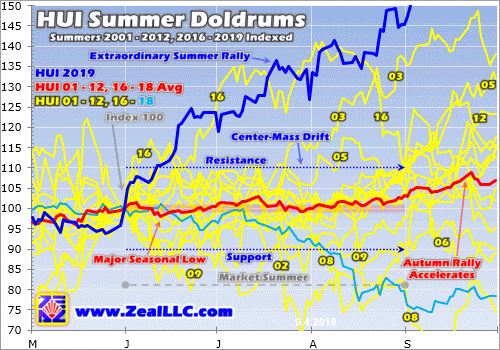
The center-mass trend of this spilled-spaghetti chart is a sideways grind, within 10% either direction of the final May close. This summer’s breakout gold-stock rally is rendered in dark blue, and it proved an utter monster. By the end of August, the HUI had skyrocketed 45.3% higher during the three calendar months of the market summer! The seasonal average in modern gold-bull-market years before 2019 was a 3.2% gain.
The gold miners just soared to their best summer performance in recent decades! The only comparable year was 2016, making its example important for gaming today’s overboughtness. The gold stocks spent the last few months racing higher neck-and-neck with the summer of 2016, trading the lead back and forth multiple times. It wasn’t until the last couple weeks that 2019 injected the nitrous and screamed past.
By the end of July 2016, the HUI had soared 36.3% summer-to-date compared to 2019’s considerably-smaller 26.9% gains in that same span. But by the end of August 2016, those had collapsed back down to +10.1% over that entire summer. This summer’s strong finish after a powerful multi-month rally is truly in a league of its own. Only 2003 rivaled it with 36.9% summer gains, but those started well later mid-summer.
Overboughtness is a relative thing, it can’t be defined absolutely since prevailing price levels gradually change over time. But the biggest summer gold-stock rally in modern history certainly raises concerns of running too far too fast. Gold stocks soaring by about half in several months is a huge move even by their wild standards! This mighty gold-stock surge looks even more extreme considered in longer-term context.
This next chart encompasses the current gold-stock bull since early 2016, which was driven by gold’s own parallel secular bull. Professional institutional investors have often gamed this bull with that leading and dominant GDX ETF, so it is used here rather than the older HUI. While the gold miners’ stocks achieved much technically this summer, there’s no doubt they soared to super-overextended levels which is ominous.
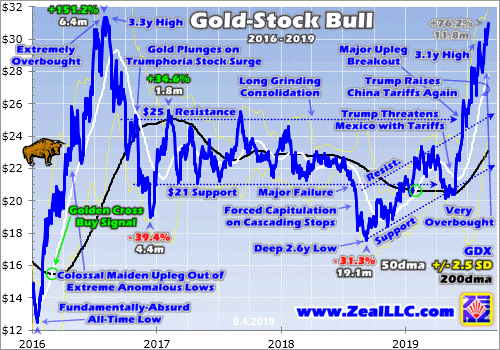
As of this past Wednesday’s close, the data cutoff for this essay, GDX had powered up 76.2% in 11.8 months. Interestingly that’s right in line with the last secular gold-stock bull’s average upleg gain. From November 2000 to September 2011, the HUI skyrocketed 1664.4% higher over 10.8 years! Those gains accrued in 12 separate uplegs. Excluding an anomalous post-stock-panic-recovery one, they averaged 80.7% gains.
It’s hard to believe now, but back in early May GDX languished at $20.17 and you could hardly give away gold stocks! Traders didn’t want anything to do with them when they were universally despised and easy to buy incredibly low. I was pounding the table on buying the dirt-cheap gold stocks last spring, when this sector still had massive near-term upside potential. Near-record gold-futures shorting portended a major upleg.
Near the end of April in an essay on gold futures, I explained why. “Speculators’ big bearish shift in gold-futures positioning will have to be normalized, resulting in big buying that will push gold higher. That upside momentum could really grow… The biggest gains as gold mean reverts back higher will come in the stocks of its miners. They’ve proven resilient as gold swooned, and are poised to surge again.”
The out-of-favor gold stocks ground along near demoralizing lows for most of May, giving traders plenty of opportunities to buy relatively low before they ran again. We took advantage of that then to aggressively load up on fundamentally-superior gold miners and silver miners in our subscription newsletters. Trump of all things proved the catalyst to awaken gold and thus its miners’ stocks. That happened at the end of May.
Gold and gold stocks started surging after Trump threatened Mexico with tariffs, in an attempt to force it to stem the flood of illegal immigration into the U.S. Tying trade tariffs to other issues stunned traders, which unleashed safe-haven buying in gold. That helped the gold stocks rally strongly though much of June, with bullish momentum. But they really didn’t start soaring until late that month on a momentous gold milestone.
While gold technically remained in a bull market, it hadn’t made a new bull-market high since right after this bull’s maiden upleg way back in early July 2016. After 2.9 years with zero new highs, traders had long since lost interest in this sector. But in late June after the Fed shifted its future-rate-hike outlook from hiking to cutting, gold finally staged a decisive bull-market breakout. That changed everything psychologically.
The best gold levels seen in 5.8 years lit a fire under gold stocks, which kept rallying sharply in July when they are usually forgotten. They were getting overbought by mid-July, so momentum flagged heading into month-end. They were starting to roll over into what would’ve likely been a pullback until Trump surprised again, hiking tariffs on China as August dawned. That ignited gold stocks’ latest surge earlier last month.
That too soon started to fade since the gold stocks were so overbought. Smart traders who’ve dedicated many years to studying and understanding market cycles realized a corrective selloff was increasingly likely after such a big and fast surge. But yet again in late August Trump surprised with still another hike on Chinese tariffs! That sparked and fueled another gold and gold-stock rally that persisted into this week.
The result of these three catalyzing Trump-tariff-hike announcements in recent months is the near-vertical gold-stock surge seen in these charts. GDX blasted to its best levels in 3.1 years. That’s not necessarily high absolutely, but it is certainly high relatively. When prices surge really far really fast on major buying as sentiment turns greedy, overboughtness always results. Such blistering rallies inevitably lead to selloffs.
While traders chasing the herd to buy in high later in uplegs practically panic when major selloffs hit, they are actually very healthy. They are essential and necessary to rebalance sentiment, eradicating the out-of-control greed after excessive gains. They force prices lower until technicals grow oversold as popular psychology waxes bearish. That leaves gold stocks relatively low again, a great opportunity to buy back in.
These inexorable upleg-correction cycles are what enable shrewd traders to multiply their wealth in bull markets. The goal is to buy relatively low after the corrections, then sell relatively high after the uplegs. This can only be achieved by doing what’s unpopular, fighting the crowd to do the opposite. When other traders are scared and selling is when to buy low, then when they are excited and buying is when to sell high.
The challenge is defining relatively low and relatively high, seeing oversold and overbought conditions in real-time when they can be capitalized upon. While there are many technical indicators, one of the best is among the simplest. It just looks at prevailing price levels relative to their 200-day moving averages. I call this Relatively Trading, and started developing this system over 15 years ago. It has proven really profitable.
There’s no gold-stock level that can be considered high absolutely across different years and toppings. In early August 2016, GDX peaked at $31.32. From there it would plummet 39.4% over the next 4.4 months in a colossal selloff! That was considered a correction instead of a bear market since gold-stock bull-and-bear cycles are defined by gold’s own. But GDX peaked at $66.63 in September 2011 with gold’s last bull.
Is GDX high at $31, which it again challenged this week, or does it have to get to $67 to be high? Gold stocks’ absolute price levels are irrelevant, as what is exceptionally high or low gradually changes over time. So some kind of reference point is needed to identify overboughtness and oversoldness right as they happen, but that too needs to slowly evolve. I’ve found gold stocks’ 200dma acts as an ideal metric for this.
200dmas aren’t static, they gradually adjust to different prevailing gold-stock price levels. At the same time, they have enough inertia to lag extreme short-term price moves. Calendar months average about 21 trading days, so a 200dma digests the past 9.5 months of price action. Exceptional gold-stock moves stretch current prices far away from their trailing 200dmas. That distance is easily quantifiable to trade upon.
Relativity Trading simply divides daily price closes by their 200dmas and charts the resulting multiples over time. With a sufficiently-long span, especially in trending markets, horizontal trading ranges of these multiples form. After much study and trial and error, I settled with the last 5 calendar years to define Relativity trading bands. Seeing where 200dma multiples trade comparatively offers good buy and sell signals.
Again GDX is much newer than the HUI with a far-shorter price history. And all my years of work applying Relativity to trading gold stocks has used the HUI as their benchmark index. So I’m going to shift back to the HUI for this final chart on gold-stock overboughtness. The Relative HUI indicator, or rHUI, currently has a trading range of 0.80x to 1.50x. This is rendered in this chart with the green and red shaded zones.
Visually a Relativity chart effectively flattens a 200dma, straightening it to 1.00x. Then a price’s multiple to that 200dma oscillates around it over time, in perfectly-comparable percentage terms regardless of the prevailing price levels. No matter where gold stocks are trading, when the rHUI hits 0.80x or 1.50x the actual HUI is trading at 80% or 150% of its current 200-day moving average. Here is this gold-stock bull’s chart.
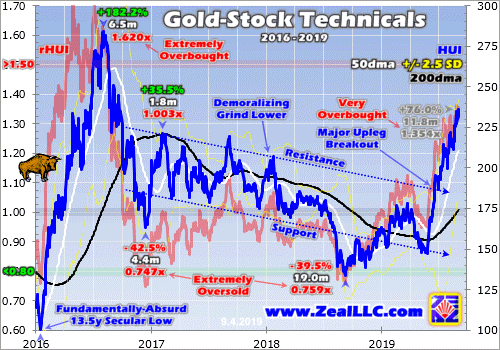
Thanks to the gold stocks’ blistering rally this summer, the rHUI shot up as high as 1.362x last week. On Wednesday as this upleg’s latest high was hit, the rHUI still ran 1.354x. In other words, the major gold stocks as a sector are stretched 35% to 36% above their 200dma! That is very overbought, and doesn’t happen very often. Gold-stock uplegs usually only deviate from their 200dmas so greatly when they go terminal.
Bull-market uplegs usually start gradually, with not many traders interested in buying relatively low after major corrections. But as uplegs gather steam and gains mount, traders get excited about the upside momentum and want to buy in. The higher prices climb, the more greed grows and the greater the allure of chasing the herd. Thus upleg gains tend to be back-loaded, the majority accruing quickly as uplegs mature.
So really-overbought readings generally only happen late in uplegs. Actual gold-stock topping levels in rHUI terms still vary greatly though. Back in this bull market’s mighty maiden upleg peaking in summer 2016, the rHUI soared as high as 1.70x before drifting back to 1.62x when gold stocks actually crested in early August. But anytime the major gold stocks stretch 25%+ above their 200dmas, traders need to be wary.
Since there’s so much variability in upleg toppings, I generally haven’t sold trading positions outright. My strategy is usually to ratchet up trailing stop losses as prices get more overbought. That effectively locks in more of our upleg gains, while preserving upside potential if the upleg persists even longer. Although stop losses have their own challenges as they can be whipsawed into tripping early, they help manage risk.
I also consider gold-stock overboughtness in rHUI-multiple terms against the backdrop of how speculators are currently positioned in gold futures. Gold stocks are effectively leveraged plays on gold, and the gold-futures traders dominate gold’s short-term price action. I last explained this in depth in a mid-July essay. For our purposes today, realize gold’s own selloffs driving gold stocks’ are almost always governed by futures.
In the latest weekly data, speculators held their second-highest levels of gold-futures long contracts on record! That left their total longs running 97% up into their gold-bull-market trading range since mid-December 2015, which was topped by July 2016’s all-time-record high. When specs are effectively all-in gold-futures longs, all they can do is sell. Excessive long positions precede major corrections in gold.
After that only time spec longs were slightly higher in mid-2016, gold plunged 17.3% over the next 5.3 months which hammered the gold stocks 39.4% lower per GDX! And on the short side of gold futures, in the latest weekly read specs’ total contracts were running just 11% up into their own gold-bull-market trading range. That means they also have little room to buy gold futures to cover shorts, but lots of room to sell.
The most-bearish-possible near-term outlook for gold happens when total spec longs and shorts swing to 100% and 0% up into their bull-market trading ranges. The latest 97% and 11% as of last Tuesday’s close is getting pretty darned close! Since gold stocks will tank with gold regardless of how overbought they get, their downside risks are high. A major correction is far more likely than additional material rallying.
Rather amusingly, warning of overboughtness and impending selloffs after powerful uplegs always gets people riled up. After these 877 weekly essays, I know my e-mail inbox will be full of people telling me what a fool I am Monday morning. How could gold stocks not soar to the moon? This time is different because… The irony is traders should welcome corrective selloffs as they create new buy-low opportunities.
I opened with the first third of my conclusion from our brand-new monthly newsletter, and here’s the rest. “That will rebalance sentiment, paving the way for far-bigger future gains. There’s no sense redeploying capital high before that inevitable selloff arrives. Don’t let that short-term bearishness cloud the big picture. Gold’s powerful surge higher in the last several months changes everything going forward.”
“It confirms gold is indeed in a secular bull market! That was ignored and disputed for years since gold failed to break out to new bull highs. Gold’s decisive breakout and rallying since ballooned interest in it. So future gold and gold-stock uplegs are going to attract way more capital from way more traders around the world, growing them to much-larger sizes.” This latest upleg was fun, but bigger and better are coming.
To multiply your capital in the markets, you have to trade like a contrarian. That means buying low when few others are willing, so you can later sell high when few others can. In the first half of 2019 well before gold’s breakout, we recommended buying many fundamentally-superior gold and silver miners in our popular weekly and monthly newsletters. We’ve recently realized big gains including 109.7%, 105.8%, and 103.0%!
To profitably trade high-potential gold stocks, you need to stay informed about the broader market cycles that drive gold. Our newsletters are a great way, easy to read and affordable. They draw on my vast experience, knowledge, wisdom, and ongoing research to explain what’s going on in the markets, why, and how to trade them with specific stocks. Subscribe today and take advantage of our 20%-off sale! Get onboard now so you can mirror our coming trades for the next upleg as they are deployed in real-time.
The bottom line is gold stocks are very overbought. The powerful counter-seasonal rally in recent months catapulted gold-stock benchmarks far beyond their 200-day moving averages. Such stretched technicals coupled with very-bullish popular sentiment are a warning this recent upleg is maturing. It is likely to roll over into a healthy correction soon to restore balance, driven by gold-futures selling from spec extremes.
All bull markets flow and ebb, with big uplegs followed by major corrections. Fighting the latter is utterly pointless. Ride the bull-market waves rather than drowning in them. Buy relatively low near the troughs, then sell relatively high near the crests. That means buying when everyone else is scared, before selling when everyone else is greedy. After enjoying a great and very-profitable upleg, we can cash out for the next one.
Adam Hamilton, CPA
September 9, 2019
Copyright 2000 – 2019 Zeal LLC (www.ZealLLC.com)
A few weeks ago we wrote that precious metals were at risk of a correction.
First, they powered higher. But last week they ran into technical resistance levels that date back well beyond only a few years.
This is true for Gold, Silver as well as the miner ETFs: GDX and GDXJ.
Starting with Gold, we can see that it has struggled to get through $1550/oz. That’s not a surprise as we pointed out this level as resistance since Gold surpassed $1370/oz.
The combination of multi-year resistance at $1550/oz and the current high net speculative position could force Gold down to a retest of $1400/oz.
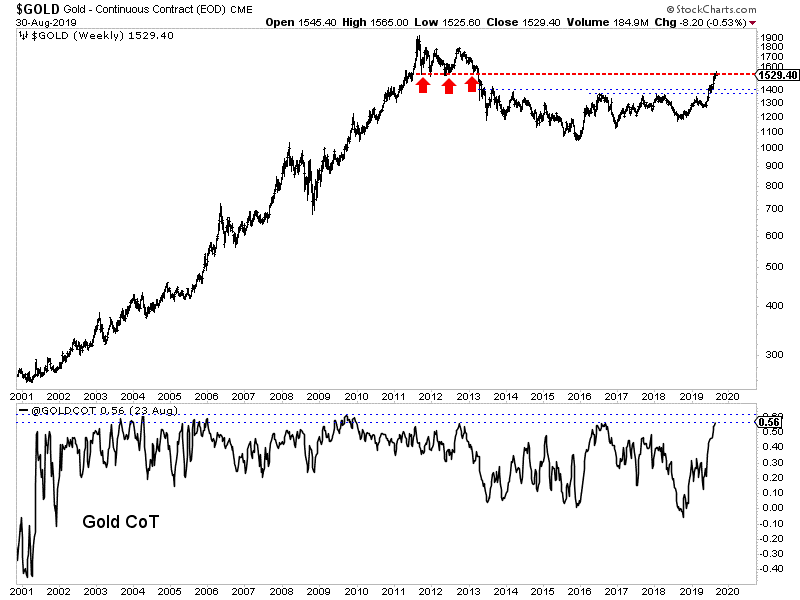
Meanwhile, Silver has been the strongest component of the sector in the short-term.
It closed the month of August right at major resistance in the mid $18s, which as you can see, has been a key level for the last 11 years. A monthly close above $18.50 would be significant but it may not happen until October or November.
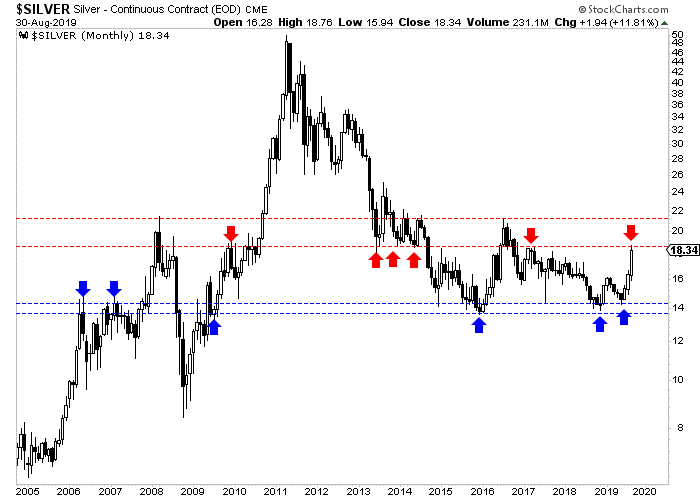
Turning to the stocks, we see that GDX has reached its 2016 high and 6-year resistance. A correction or consolidation for weeks or even a few months would be perfectly normal.
GDXJ has lagged much like Silver as it has yet to reach its 2016 high near $50. However, it is dealing with important resistance at $42 which dates back to 2014.
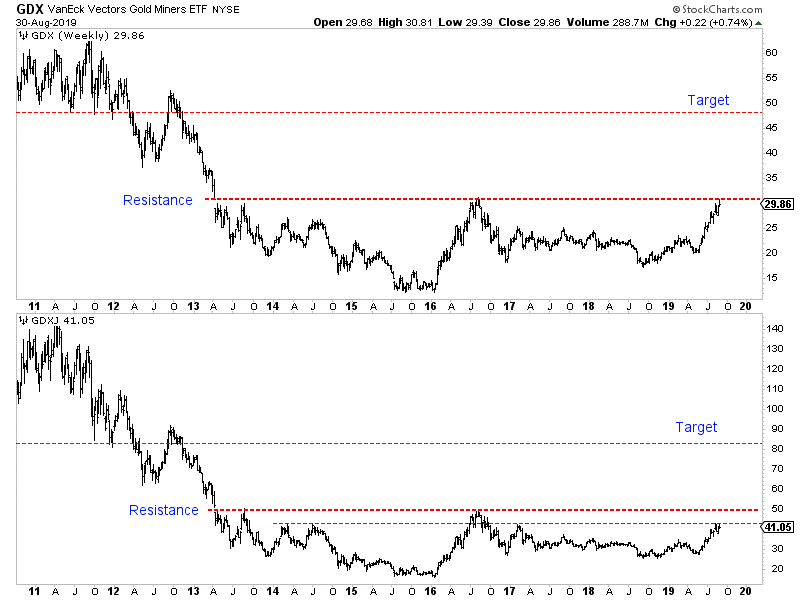
As summer winds down, the excitement in precious metals is building.
The retail crowd is looking to jump back in for the first time in years and the same can be said for many institutions.
In the big picture, this is the time to jump back in. You do want to get in before the sector makes its next break higher and before GDX and GDXJ surpass multi-year resistance.
However, the immediate risk appears to be to the downside.
Gold, Silver and gold stock ETFs all are at multi-year resistance levels. A correction and consolidation is perfectly normal and should be expected here.
If you missed the recent run then don’t panic. It’s best to exercise patience and wait for weakness. Better value and new opportunities will emerge. To learn the stocks we own and intend to buy that have 3x to 5x potential, consider learning more about our premium service.
By Jordan Roy-Byrne CMT, MFTA
September 5, 2019
Royal Road Minerals has released results from its recently completed diamond drilling program at the Luna Roja gold project in Nicaragua.
The Luna Roja project is part of a strategic alliance agreement with Hemco Mineros Nicaragua and is located in the highly prospective Golden Triangle region of northeastern Nicaragua. Mines in the region have been operating since the early 1900s.
The first drilling program to be completed on the project returned significant intersections including, 40.65 meters at 2.5 grams per tonne, 23.5 meters at 5.1 grams per tonne, 12.0 meters at 7.1 grams per tonne and 5.5 meters at 12.2 grams per tonne gold.
The drilling results indicate that gold mineralization remains open at depth (down to 150m vertical depth) and management believe that potential exists for further gold mineralization in a downthrown block concealed structurally below mapped marbles and skarnoids to the southeast.
Samples of the drill core have been shipped to Bureau Veritas Vancouver for preliminary metallurgical testing.
“These drilling results are a great start at Luna Roja,” said Royal Road president and CEO Dr. Tim Coughlin. “This discovery is a product of great teamwork and of an exemplary collaboration with our partners, Hemco Mineros Nicaragua. The possibility of extensions to gold mineralization at depth and under faulted cover to the southeast at Luna Roja is enticing. We are also excited to have established our first Designated Project Area and look forward to advancing the Luna Roja project with our partners Hemco Mineros Nicaragua and with the local community, local authorities and other valuable regional stakeholders.”
In 2019, the age-old aphorism, ‘All that glitters’ certainly holds true for gold. For the year-to-date, the world’s most treasured safe-haven asset has appreciated from a steady level of $1300 per troy ounce in January to its current trading levels of over $1500. In percentage terms, this translates into a 15% appreciation, at a time where tremendous uncertainty has engulfed global equities markets.
Extrapolating further out, the move to gold is abundantly clear. Over the past 1 year, gold has gained approximately $300 per ounce, and over the past 3 years it reached a nadir of $1127 per ounce. Clearly, this precious metal is on the ascendancy thanks in no small part to the volatility in equities and currencies markets. Equally notable are futures markets prospects for this precious metal. The gold futures markets are bullish over the next 12 to 21 months, with pricing between $1560 per ounce through $1600 per ounce.
The long-term trends for gold bullion have clearly priced in the possibility of increased political tensions between global powers such as the U.S., Russia, North Korea and China, notwithstanding the trade relations between the US and China, the new trade pact between the US and Japan, and a possible new trade treaty between the US and the UK.
Both Russia and the US are engaging in sabre rattling, with Russia conducting ballistic missile testing (possibly nuclear missile testing) since the US withdrew from an accord with Russia that would limit nuclear proliferation. Gold takes its cues from investors, traders, and speculators. The geopolitical tensions are one component driving the overall demand for gold.
What Impacts Demand for Gold?
Commodity price trading focuses on the commodity price against a currency. By trading lots with buy or sell orders, clients can participate in trading deals with gold contracts. Derivatives markets allow profits to be generated regardless of the price movement of the commodity. Conventional wisdom states that gold profits are earned through appreciation of the underlying commodity’s price, but this is simply not true.
A myriad of factors comes into play when investors consider the prospects of gold. Foremost among them are monetary policy matters vis-a-vis the Fed. The Federal Reserve Bank has a big part to play in the drive to gold. The higher the interest rate the greater the opportunity cost of holding gold. In other words, there is more to be gained by investing your money in high interest-yielding investments than in gold which has a 0% return.
Truth be told, gold is largely considered a store of value with long-term growth prospects. When the Fed decides to cut interest rates, this helps traders and investors to shift their resources to appreciating investments (this is at least the perception) which often takes the form of gold, the Japanese yen, the Swiss franc, and other hedge-style commodities.
From a purely economic perspective, the general performance of the world’s biggest economies plays a big part in gold demand. For example, poor manufacturing data, slow GDP growth rates, and weak jobs reports can drive traders and investors away from stock markets to gold. When bearish reports are released, there is a tendency to pull money out of the Dow Jones Industrial Average, the New York Stock Exchange, the S&P 500 index, and other global markets and protect investment portfolios by investing in gold stocks, gold funds, and possibly even in physical stores of gold bullion. Gold does not generate any interest for those who hold it; it appreciates when economic sentiment sounds.
Gold prices tend to rise when weak economic data is released, and gold prices tend to fall when strong economic data drives investment in financial markets. Another important determinant of demand and pricing is gold usage. Whether it’s jewelry, electronics, or simple demand by reserve banks around the world, the demand for gold has a direct correlation on the price of gold. With falling supply and the increasing costs of extracting gold from mines, even a steady demand for gold will lead to a substantial rise in the price of this precious metal. For example, South Africa was once the world’s biggest gold producing nation. It now struggles to extract gold ore from its mines given rising costs, and problems with union workers, et al.
It is simply unproductive at current levels to extract gold from mines given the current gold price, but with enough momentum that could change. This takes the discussion to another important determinant of gold prices: the strength of the USD. Gold is a dollar-denominated commodity. In other words, it is priced in USD. When the USD strengthens relative to other currencies (evident through the DXY), it takes more per-unit foreign currency to buy the equivalent ounce of gold. This tends to dampen demand for gold. When the USD depreciates relative to other currencies, those currencies can buy more gold per unit currency than before. This increases the price of gold through its impact on gold demand.
Viewed in perspective the demand for gold and other precious metals is impacted by multiple interrelated and unrelated market forces. The notion that only appreciating assets are profitable has long since been debunked through CFD trading and Futures markets, with much to be gained from correctly anticipating price movements.
Brett Chatz
September 2, 2019
Read more at https://www.business2community.com/author/brett-chatz
Back during the bear market years (it’s nice to be able to write that now), I regularly would compare the declines in Gold, Silver and gold stocks to their past history. It gave us a visual representation of just how bad the forever bear market was and helped us decipher when it might end.
Thankfully that is all behind us.
Now it’s time to compare recent bullish moves to past iterations.
First is Silver.
The recent low in Silver has several good comparisons, which include the lows in 1986, 1993 and 2003. We also included the 2008 low.
If Silver’s rebound were simply an average of the four rebounds shown then it would reach nearly $24 by the end of March 2020.
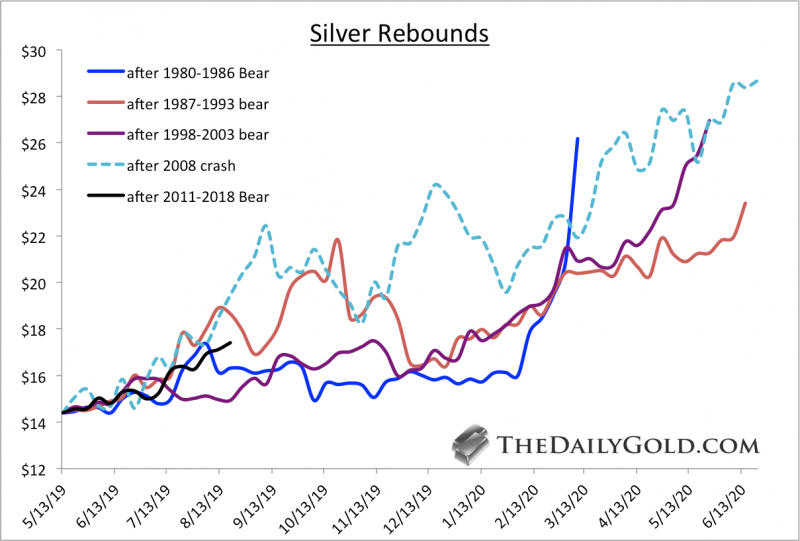
Gold is tricky because there is not an obvious bull comparison. Its major lows were essentially in 1970, 1985 and 1999 to 2001.
However, when we consider the preceding bear market, the best comparison to the recent bear and current bull is the late 1990s and early 2000s.
Mind you, we aren’t forecasting or predicting that 2003 to 2006 will be duplicated over the next three years. It’s possible, but we are simply arguing that the 2012 to 2019 period most resembles 1996 to 2003.
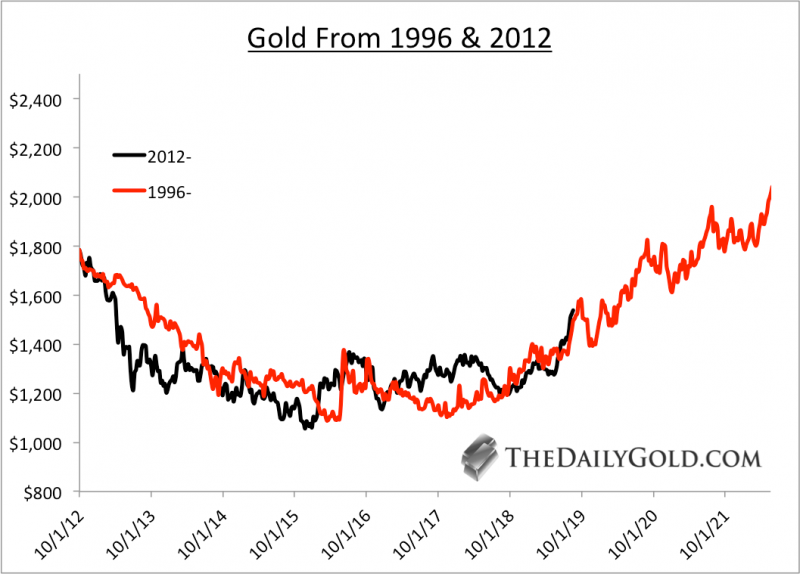
Turning to the gold stocks and specifically the junior gold stocks, here is how the 2016 bottom compares to the bottoms in 2001 and 2008.
Note that the basket of 20 stocks we used is quite strong compared to GDXJ. In other words, we erred on the side of positive performance.
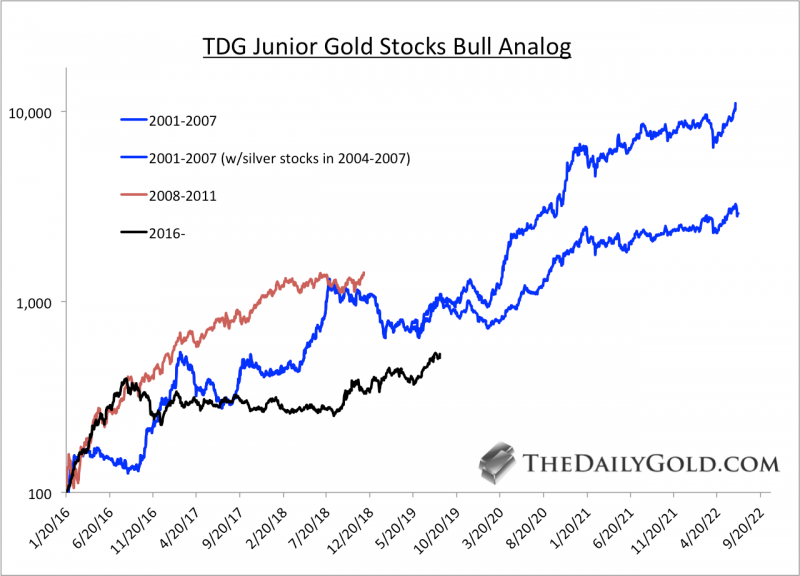
In our new book (available at TheDailyGold.com), we argue that the 2016 low in gold stocks was very similar to the 1957 low.
There are numerous similarities between today and the early to mid 1960s. That includes the gold stocks and their incredible long-term value at the start of a major inflationary cycle.
Below we compare the 1957 and 2016 lows with data from the Barron’s Gold Mining Index, which appreciated over 40-fold from its 1957 low to the peak in 1980.
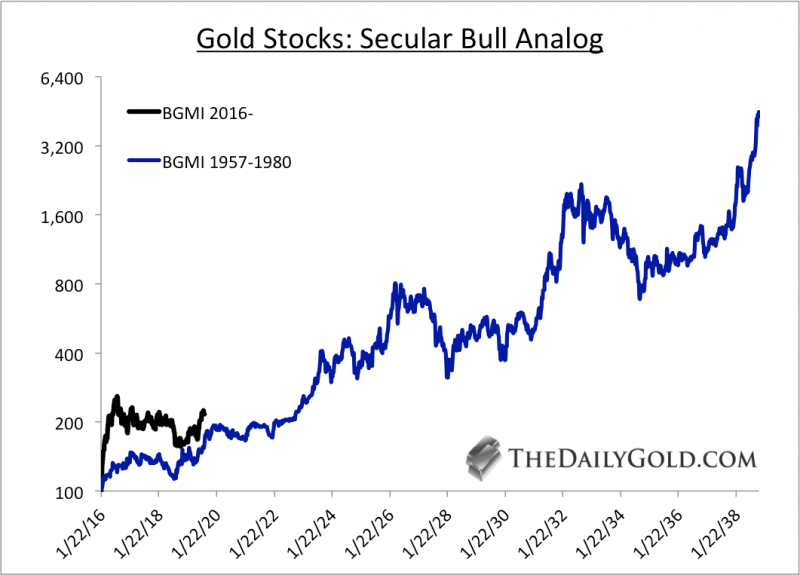
As you can see, if Gold remains in a real bull market then significant upside potential remains in place across the precious metals complex.
Fundamentally, Gold could remain in a bullish trend until the next economic recovery gains traction. That could be anywhere from a few to four years away.
If gold continues to follow the pattern of the early 2000s then it could reach $3000/oz by the start of 2023.
Jordan Roy-Byrne CMT, MFTA
August 28, 2019
- A year ago, I predicted that any U.S. stock market sell-off would be accompanied by a dramatic surge in the price of GDX an GDXJ.
- That’s exactly what happened; the stock market tanked and key gold stocks soared.
- This year, I’m predicting that any major U.S. stock market crash will again be accompanied by the soaring price of the gold producers…
- But I’m also predicting that most CDNX-listed junior explorers are set to soar too!
- Please click here now. America’s top money printing cheerleader (President Trump) brags that his government essentially has the Chinese government cowering in a corner. He claims they are ready to throw in the white towel in the trade war. Reality check:
- It’s obvious that major money managers are becoming very concerned about these tariff taxes.
- Please click here now. Double-click to enlarge this horrifying U.S. stock market chart.
- On the one hand, private enterprise must be respected. Great companies exist and prosper in the socialist nations of Europe and in China. They will continue to prosper.
- The drive of entrepreneurs must never be underestimated, even in the harshest conditions.
- On the other hand, when governments unveil growth-negative policies like tariff taxes and money printing, stock markets can experience dramatic declines. These declines are usually temporary, but they are very painful.
- Please click here now. Double-click to enlarge this important gold stocks versus gold chart.
- I call it the “Just buy” chart, because there really isn’t much else to do here except buy, buy, and buy!
- That’s especially true for core position enthusiasts. Gold stocks are incredibly cheap compared to gold bullion.
- Also, I believe investors can make the most money in the market buying when their analysis has gone awry. On that note, please click here now. Double-click to enlarge my “Golden Beeline” chart.
- Many gold analysts have tried to “top call” gold since the rally from about $1167 began. This has been a mistake and I believe it will continue to be a mistake in the months ahead.
- A gargantuan bull continuation pattern is forming on the weekly gold chart. It’s an inverse H&S pattern with a potential neckline in the $2000 area.
- This is not a time to sell gold or top call it. It’s a time to buy, sit back, and watch those positions fly! Here’s why:
- Institutional money managers are adding gold to their portfolios. These are not highly leveraged hedge funds gambling on the COMEX.
- They are unleveraged institutions. They are serious players who understand the destructive nature of the Trump tariff taxes. These taxes are being implemented as the business cycle peaks and with relentless ramp-up of U.S. government spending and debt.
- This horrifying scenario has superstar managers like Ray Dalio predicting serious inflation and potential rioting in the streets.
- Please click here now: Top money managers are concerned that stagflation is emerging as the Fed is forced to print money and cut rates to offset the taxes. They are not buying gold, silver, and the miners for a “quick flip”. This is long-term allocation.
- Please click here now. Double-click to enlarge this fabulous GDX chart.
- Profit-lock enthusiasts can buy a breakout over $30 and place a stoploss at $27.50. A move above $30 opens the door for a violent surge to $37-$39.
- From there, core positions can be added on a pullback to about $30. Nervous investors can buy put options to manage their emotions, but everyone else should be in “Buy & Fly!” mode alongside the institutional money managers. Today’s Superman is a man of gold and looking at GDX today, I believe he would say… Up, up, and away!
Special Offer For Website Readers: Please send me an Email to freereports4@gracelandupdates.com and I’ll send you my free “Golden Junior Rockets!” report. I highlight junior miners trading under $2/share that are beginning to soar, with key buy and sell prices for each stock.
Thanks,
Stewart Thomson
Graceland Updates
Email:
Stewart Thomson is a retired Merrill Lynch broker. Stewart writes the Graceland Updates daily between 4am-7am. They are sent out around 8am-9am. The newsletter is attractively priced and the format is a unique numbered point form. Giving clarity of each point and saving valuable reading time.
Risks, Disclaimers, Legal
Stewart Thomson is no longer an investment advisor. The information provided by Stewart and Graceland Updates is for general information purposes only. Before taking any action on any investment, it is imperative that you consult with multiple properly licensed, experienced and qualified investment advisors and get numerous opinions before taking any action. Your minimum risk on any investment in the world is: 100% loss of all your money. You may be taking or preparing to take leveraged positions in investments and not know it, exposing yourself to unlimited risks. This is highly concerning if you are an investor in any derivatives products. There is an approx $700 trillion OTC Derivatives Iceberg with a tiny portion written off officially. The bottom line:
Are You Prepared?
The mid-tier gold miners’ stocks have soared in recent months on gold’s decisive bull-market breakout. They are this sector’s sweet spot for stock-price upside potential, with room for strong production growth which investors love. That’s an attractive contrast to the stagnating major gold miners. The mid-tiers’ recently-reported Q2’19 results reveal whether their fundamentals justify their strong surge this summer.
Four times a year publicly-traded companies release treasure troves of valuable information in the form of quarterly reports. Required by the U.S. Securities and Exchange Commission, these 10-Qs and 10-Ks contain the best fundamental data available to traders. They dispel all the sentiment distortions inevitably surrounding prevailing stock-price levels, revealing corporations’ underlying hard fundamental realities.
The global nature of the gold-mining industry complicates efforts to gather this important data. Many mid-tier gold miners trade in Australia, Canada, South Africa, the United Kingdom, and other countries with quite-different reporting requirements. These include half-year reporting rather than quarterly, long 90-day filing deadlines after year-ends, and very-dissimilar presentations of operating and financial results.
The definitive list of mid-tier gold miners to analyze comes from the GDXJ VanEck Vectors Junior Gold Miners ETF. Despite its misleading name, GDXJ is totally dominated by mid-tier gold miners and not juniors. GDXJ is the world’s second-largest gold-stock ETF, with $4.5b of net assets this week. That is only behind its big-brother GDX VanEck Vectors Gold Miners ETF that includes the major gold miners.
Major gold miners are those that produce over 1m ounces of gold annually. The mid-tier gold miners are smaller, producing between 300k to 1m ounces each year. Below 300k is the junior realm. Translated into quarterly terms, majors mine 250k+ ounces, mid-tiers 75k to 250k, and juniors less than 75k. GDXJ was originally launched as a real junior-gold-stock ETF as its name implies, but it was forced to change its mission.
Gold stocks soared in price and popularity in the first half of 2016, ignited by a new bull market in gold. The metal itself awoke from deep secular lows and surged 29.9% higher in just 6.7 months. GDXJ and GDX skyrocketed 202.5% and 151.2% higher in roughly that same span, greatly leveraging gold’s gains! As capital flooded into GDXJ to own junior miners, this ETF risked running afoul of Canadian securities laws.
Canada is the center of the junior-gold universe, where most juniors trade. Once any investor including an ETF buys up a 20%+ stake in a Canadian stock, it is legally deemed a takeover offer. This may have been relevant to a single corporate buyer amassing 20%+, but GDXJ’s legions of investors certainly weren’t trying to take over small gold miners. GDXJ diversified away from juniors to comply with that archaic rule.
Smaller juniors by market capitalization were abandoned entirely, cutting them off from the sizable flows of ETF capital. Larger juniors were kept, but with their weightings within GDXJ greatly demoted. Most of its ranks were filled with mid-tier gold miners, as well as a handful of smaller majors. That was frustrating, but ultimately beneficial. Mid-tier gold miners are in the sweet spot for stock-price-appreciation potential!
For years major gold miners have struggled with declining production, they can’t find or buy enough new gold to offset their depletion. And the stock-price inertia from their large market capitalizations is hard to overcome. The mid-tiers can and are boosting their gold output, which fuels growth in operating cash flows and profitability. With much-lower market caps, capital inflows drive their stock prices higher much faster.
Every quarter I dive into the latest results from the top 34 GDXJ components. That’s simply an arbitrary number that fits neatly into the tables below, but a commanding sample. These companies represented 83.2% of GDXJ’s total weighting this week, even though it contained a whopping 70 stocks! 3 of the top 34 were majors mining 250k+ ounces, 24 mid-tiers at 75k to 250k, 5 “juniors” under 75k, and 2 explorers with zero.
These majors accounted for 12.8% of GDXJ’s total weighting, and really have no place in a “Junior Gold Miners ETF” when they could instead be exclusively in GDX. These mid-tiers weighed in at 60.9% of GDXJ. The “juniors” among the top 34 represented just 6.6% of GDXJ’s total. But only 1 of them at a mere 0.9% of GDXJ is a true junior, meaning it derives over half its revenues from actually mining gold.
The rest include 2 primary silver miners, a gold-royalty company, and a gold streamer. GDXJ is actually a full-on mid-tier gold miners ETF, with modest major and tiny junior exposure. Traders need to realize it is not a junior-gold investment vehicle as advertised. GDXJ also has major overlap with GDX. Fully 29 of these top 34 GDXJ gold miners are included in GDX too, with 23 of them also among GDX’s top 34 stocks.
The GDXJ top 34 accounting for 83.2% of its total weighting also represent 39.8% of GDX’s own total weighting! The GDXJ top 34 mostly clustered between the 10th- to 40th-highest weightings in GDX. Thus nearly 5/6ths of GDXJ is made up by almost 4/10ths of GDX. But GDXJ is far superior, excluding the large gold majors struggling with production growth. GDXJ gives much-higher weightings to better mid-tier miners.
The average Q2’19 gold production among GDXJ’s top 34 was 157k ounces, a bit over half as big as the GDX top 34’s 299k average. Despite these two ETFs’ extensive common holdings, GDXJ is increasingly outperforming GDX. GDXJ holds many of the world’s best mid-tier gold miners with big upside potential as gold’s own bull continues powering higher. Thus it is important to analyze GDXJ miners’ latest results.
So after each quarterly earnings season I wade through all available operational and financial reports and dump key data into a big spreadsheet for analysis. Some highlights make it into these tables. Any blank fields mean a company hadn’t reported that data as of this Wednesday. The first couple columns show each GDXJ component’s symbol and weighting within this ETF as of this week. Not all are U.S. symbols.
19 of the GDXJ top 34 primarily trade in the U.S., 5 in Australia, 8 in Canada, and 2 in the U.K. So some symbols are listings from companies’ main foreign stock exchanges. That’s followed by each gold miner’s Q2’19 production in ounces, which is mostly in pure-gold terms excluding byproducts often found in gold ore like silver and base metals. Then production’s absolute year-over-year change from Q2’18 is shown.
Next comes gold miners’ most-important fundamental data for investors, cash costs and all-in sustaining costs per ounce mined. The latter directly drive profitability which ultimately determines stock prices. These key costs are also followed by YoY changes. Last but not least the annual changes are shown in operating cash flows generated, hard GAAP earnings, revenues, and cash on hand with a couple exceptions.
Percentage changes aren’t relevant or meaningful if data shifted from positive to negative or vice versa, or if derived from two negative numbers. So in those cases I included raw underlying data rather than weird or misleading percentage changes. In cases where foreign GDXJ components only released half-year data, I used that and split it in half where appropriate. That offers a decent approximation of Q2 results.
Symbols highlighted in light blue newly climbed into the ranks of GDXJ’s top 34 over this past year. And symbols highlighted in yellow show the rare GDXJ-top-34 components that aren’t also in GDX. If both conditions are true, blue-yellow checkerboarding is used. Production bold-faced in blue shows any rare junior gold miners in GDXJ’s higher ranks, under 75k ounces quarterly with over half of sales from gold.
This whole valuable dataset compared with past quarters offers a fantastic high-level read on how mid-tier gold miners are faring fundamentally as an industry. This last quarter was interesting, as gold’s awesome breakout surge to major new secular highs didn’t get underway until just before quarter-end. So the mid-tier gold miners had to contend with flat gold prices, with Q2’19’s average of $1309 merely 0.2% higher YoY.
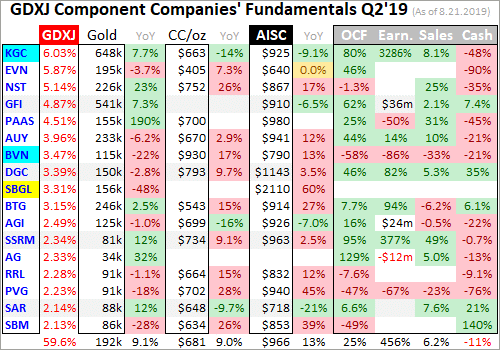
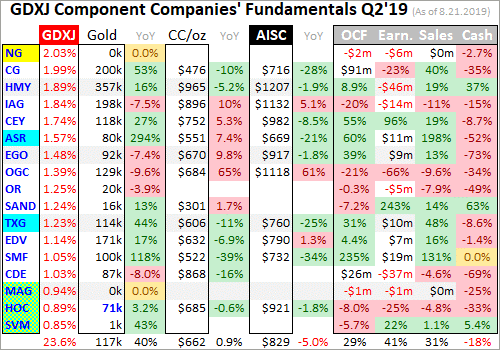
The shuffling in the ranks of GDXJ’s top 34 components continued over this past year, with major gold miner Kinross Gold added. It, Gold Fields, and Harmony Gold really should be shifted exclusively into GDX since their production is way into major-dom. Gold miners of that scale just defeat the purpose of a “Junior Gold Miners ETF”, retarding its upside potential and eroding traders’ confidence in its managers’ competence.
Most of the other new additions are good though, including mid-tiers Buenaventura, Alacer Gold, and Torex Gold. While Hochschild Mining was technically a junior last quarter, it will likely soon grow into a mid-tier mining 75k+ ounces of gold quarterly. But there’s one GDXJ component that reported such an extreme quarter that it skews most of the year-over-year comparisons. That is South Africa’s Sibanye-Stillwater.
SBGL is actually a primary platinum-group-metals miner, which drove nearly two-thirds of its implied revenue based on average metals prices in Q2! Its shrinking South African gold operations are a total mess, just emerging from a 5-month-long strike organized by a violent Marxist union. That crippled its gold mines, and left at least 9 people dead! Sibanye-Stillwater also has to fight South Africa’s absurdly-corrupt government.
Even though that hellish strike ended in mid-April, very early in Q2, SBGL’s gold production plummeted a catastrophic 47.9% YoY last quarter! That catapulted its all-in sustaining costs to a ridiculous $2110 per ounce, up an extreme 60.5% YoY from already-high levels. This shocking anomaly needs to be excluded in GDXJ comparisons. I wouldn’t invest in this company if it was the last miner on earth, it is a nightmare.
Production has always been the lifeblood of the gold-mining industry. Gold miners have no control over prevailing gold prices, their product sells for whatever the markets offer. Thus growing production is the only manageable way to boost revenues, leading to amplified gains in operating cash flows and profits. Higher production generates more capital to invest in expanding existing mines and building or buying new ones.
Thus gold-stock investors have long prized production growth above everything else, as it is inexorably linked to company growth and thus stock-price-appreciation potential. In Q2’19 these GDXJ-top-34 gold miners collectively produced 5.0m ounces of gold. That was actually down 1.2% YoY, which is worse than the 0.7% shrinkage the top 34 GDX majors reported last quarter after being adjusted for mega-mergers.
But excluding SBGL’s mayhem, the rest of the GDXJ top 34 actually managed to grow their total output by an impressive 1.7% YoY to 4.9m ounces! That not only trounced the majors, but narrowly bested the world’s aggregate production growth in Q2. According to gold’s leading fundamental authority, the World Gold Council, total world output grew 1.6% YoY last quarter to 28.4m ounces. The mid-tiers are thriving.
The GDXJ mid-tiers were able to enjoy strong production growth because this ETF isn’t burdened with many struggling major gold miners that dominate GDX. Again GDXJ’s components start at the 10th-highest weighting in GDX. The 9 above it averaged colossal Q2 production of 585k ounces, which is 3.7x bigger than the GDXJ top 34’s average! Gold mining’s inherent geological limitations make it very difficult to scale.
The more gold miners produce, the harder it is to even keep up with relentless depletion let alone grow their output consistently. Large economically-viable gold deposits are getting increasingly difficult to find and ever-more-expensive to develop, with low-hanging fruit long since exploited. But with much-smaller production bases, mine expansions and new mine builds generate big output growth for mid-tier golds.
The majors don’t only face that large-base growth problem with their production scales, but also with their stocks’ market capitalizations. The GDXJ top 34 companies averaged $2.5b in the middle of this week, compared to $6.9b in the GDX top 34 when I analyzed their Q2 results last week. With the mid-tiers generally around a third as big as the majors, their stock prices have much less inertia restraining them.
With gold returning to favor since late June’s awesome decisive bull-market breakout, the mid-tier-filled GDXJ is already outperforming the major-dominated GDX. Since its year-to-date low in late May, GDXJ surged as much as 52.1% higher by early August! That was considerably better than GDX’s 46.2% rally in the same timeframe. The longer gold-bull uplegs persist, the bigger the mid-tier outperformance grows.
The mid-tier gold miners continue to prove all-important production growth is achievable off smaller bases. With a handful of mines or less to operate, mid-tiers can focus on expanding them or building a new mine to boost their output beyond depletion. But the majors are increasingly failing to do this from the super-high production bases they operate at. As long as majors are struggling, it is prudent to avoid them.
Also interesting on the mid-tier production front was silver. Last quarter the GDXJ-top-34 miners’ silver output blasted 42.8% higher YoY to 28.2m ounces! Some of these companies indeed saw exploding silver production, led by Yamana Gold’s rocketing up 65.8% YoY to 2.2m ounces and SSR Mining’s soaring a similar 55.8% YoY to 1.5m ounces. But new GDXJ-top-34 components drove most of the silver growth.
Buenaventura and Hochschild Mining produced 5.5m and 4.3m ounces of silver last quarter, and they weren’t in GDXJ’s top 34 in Q2’18. Excluding them, the rest of these mid-tier gold miners actually saw their total silver output slump 5.1% YoY. I’ll discuss the serious challenges silver mining faces in next week’s essay, which will wade through the results of the top silver miners of the leading silver miners’ ETF.
In gold mining, production and costs are generally inversely related. Gold-mining costs are largely fixed quarter after quarter, with actual mining requiring about the same levels of infrastructure, equipment, and employees. So the higher production, the more ounces to spread mining’s big fixed costs across. Thus Q2’19’s solid production growth among the GDXJ top 34 ex-SBGL should’ve yielded proportionally-lower costs.
There are two major ways to measure gold-mining costs, classic cash costs per ounce and the superior all-in sustaining costs per ounce. Both are useful metrics. Cash costs are the acid test of gold-miner survivability in lower-gold-price environments, revealing the worst-case gold levels necessary to keep the mines running. All-in sustaining costs show where gold needs to trade to maintain current mining tempos indefinitely.
Cash costs naturally encompass all cash expenses necessary to produce each ounce of gold, including all direct production costs, mine-level administration, smelting, refining, transport, regulatory, royalty, and tax expenses. In Q2’19 these top-34-GDXJ-component gold miners that reported cash costs averaged $672 per ounce. That actually rose a sharp 6.6% YoY, and was worse than the GDX-top-34 majors’ $641 mean.
Sibanye-Stillwater didn’t report Q2 cash costs, so that wasn’t a factor. But a couple of other anomalous situations dragged up this average. Buenaventura has been struggling with weaker production, resulting in extreme $930 cash costs last quarter. And Harmony Gold, a South African miner facing that country’s miserable operating environment, had even-worse $965 cash costs in Q2’19! Those are crazy-high.
Excluding them, the rest of the GDXJ top 34 averaged $650. That’s towards the lower end of the GDXJ-top-34 average range of $612 to $730 in the 13 quarters I’ve been advancing this deep-quarterly-results research thread. As long as cash costs remain far below prevailing gold prices, which was certainly true in Q2, the gold miners face no existential threat. Gold returning to favor is really widening that key survival gap.
Way more important than cash costs are the far-superior all-in sustaining costs. They were introduced by the World Gold Council in June 2013 to give investors a much-better understanding of what it really costs to maintain gold mines as ongoing concerns. AISCs include all direct cash costs, but then add on everything else that is necessary to maintain and replenish operations at current gold-production levels.
These additional expenses include exploration for new gold to mine to replace depleting deposits, mine-development and construction expenses, remediation, and mine reclamation. They also include the corporate-level administration expenses necessary to oversee gold mines. All-in sustaining costs are the most-important gold-mining cost metric by far for investors, revealing companies’ true operating profitability.
The GDXJ-top-34 AISC picture in Q2’19 looked much like the cash-cost one, with average AISCs surging 6.1% YoY to $941 per ounce. That was on the higher side of the past 13 quarters’ range from $855 to $1002, but way below Q2’s average gold price of $1309. That implies GDXJ’s mid-tier gold miners were already earning sizable $368 profits last quarter. But this AISC read was heavily skewed by SBGL’s mess.
Again that cursed gold miner’s AISCs skyrocketed 60.5% YoY to an unbelievable $2110! That was as high as I’ve ever seen, and SBGL tried to bury this deep in its Q2 reporting. The strike was blamed, even though it ended in early Q2. But remove that wild outlier from the pool, and the rest of the GDXJ-top-34 gold miners averaged AISCs of $896 per ounce. That’s actually right in line with the GDX top 34’s $895.
With gold rocketing back over $1500 earlier this month to hit 6.3-year secular highs, it is easy to assume the gold miners must be thriving fundamentally. And they likely are. But realize the lion’s share of the recent huge gold gains didn’t start until late June when gold decisively broke out to new bull-market highs. So these Q2 results don’t yet reflect these new higher gold prices. But Q3’s are on track to look spectacular.
Gold’s lofty $1446 average price so far this quarter is a whopping 10.5% higher quarter-on-quarter than Q2’s! So the current likely profitability of the gold miners post-gold-breakout is far higher than seen last quarter. Assuming the GDXJ top 34’s average all-in sustaining costs hold flat near $941 this quarter, that implies Q3 profits running $505 per ounce. That’s up a massive 37.2% QoQ from what was seen in Q2!
This incredible profits leverage to gold is what makes gold stocks so alluring during major gold uplegs. Their earnings grow so darned fast, 3.5x gold’s advance in this example, that big stock-price gains are usually fundamentally-justified. In Q2’19, GDXJ averaged $30.46 per share. That’s when you should’ve been buying gold stocks, when they were low and out of favor. I explained their bullish outlook in early April.
So far in Q3 which is more than half over, GDX has averaged $38.43 which is 26.2% higher QoQ. That is still lagging big expected profits growth among mid-tier gold miners this quarter given the much-higher prevailing gold prices. So gold stocks’ strong gains in recent months are fundamentally-righteous, supported by underlying earnings growth and sustainable as long as gold holds over $1446 into quarter-end.
The mid-tier gold miners reported good accounting results last quarter even before gold reignited. The GDXJ top 34’s total revenues soared 23.0% YoY to $6.6b! While that is certainly overstated given the new inclusion of major gold miner Kinross Gold, without it the rest of these companies still saw strong 7.3% YoY growth. That’s impressive given Q2’19’s dead-flat average gold price, up a trivial 0.2% YoY.
These strong operations drove exploding operating-cashflow generation, with the GDXJ top 34’s total blasting 44.2% higher YoY to $2.3b! Even without KGC they still rose 23.6% YoY. And these elite mid-tier gold miners were investing some of this new capital in expanding their mines, which investors always like to see. Their collective cash hoards sunk 12.6% YoY to $6.0b, which remains healthy given mid-tiers’ sizes.
The GDXJ top 34’s profits under Generally Accepted Accounting Principles radically improved as well. Together they earned $291m last quarter, which was a colossal improvement from Q2’18’s $410m loss. Even though $384m of that resulted from an impairment charge by a single component miner that quarter, the mid-tiers’ profits picture still greatly improved. And that was even with last quarter’s still-anemic $1309 gold.
Imagine how awesome these numbers will look in this current quarter given all the gold fireworks since the end of Q2! The mid-tier gold miners generally report their results 4 to 6 weeks after quarter-ends, so Q3’19 fundamental performance will be revealed in the first half of November. As long as gold sentiment remains decent, these Q3 results should really impress and attract in legions of new investors to this sector.
That being said, gold and gold stocks have soared really far really fast this quarter. Sentiment quickly grew greedy as really-overbought levels were reached. Couple that with today’s menacing overhang of huge potential gold-futures selling, and a healthy bull-market correction is likely. But now is the time to do your homework before buying lower later, to ferret out the high-potential gold miners with superior fundamentals.
All portfolios need a 10% allocation in gold and its miners’ stocks! This is more important than ever with gold finally waking up from its long slumber while lofty central-bank-goosed stock markets are looking increasingly precarious. The better mid-tier gold miners are the place to be. Unlike the majors, they are actually growing their production and have far-higher upside coming from lower-market-capitalization bases.
To multiply your capital in the markets, you have to trade like a contrarian. That means buying low when few others are willing, so you can later sell high when few others can. In the first half of 2019 well before gold’s breakout, we recommended buying many fundamentally-superior gold and silver miners in our popular weekly and monthly newsletters. We’ve recently realized big gains including 109.7%, 105.8%, and 103.0%!
To profitably trade high-potential gold stocks, you need to stay informed about the broader market cycles that drive gold. Our newsletters are a great way, easy to read and affordable. They draw on my vast experience, knowledge, wisdom, and ongoing research to explain what’s going on in the markets, why, and how to trade them with specific stocks. Subscribe today and take advantage of our 20%-off summer-doldrums sale! The biggest gains are won by traders diligently staying abreast so they can ride entire uplegs.
The bottom line is the mid-tier gold miners are thriving fundamentally. Their Q2 results were good, even before gold’s powerful bull-market breakout. They are growing production while holding the line on costs. That means their earnings will soar as gold powers higher on balance in its resurgent bull market. That will support much-higher gold-stock prices in the future, and attract traders back to this long-neglected sector.
Gold’s bull market will flow and ebb as always, so gold-stock positions should be accumulated relatively low in post-selloff troughs. There’s no need to buy high at crests when everyone is excited. But you have to prepare in advance, monitoring the markets and researching the gold miners to be ready to pounce at opportune times. Capital allocations should be focused on mid-tier gold miners with superior fundamentals.
Adam Hamilton, CPA
August 26, 2019
Copyright 2000 – 2019 Zeal LLC (www.ZealLLC.com)
Last week we wrote that near-term risk in precious metals (Gold and GDX especially) was rising and a correction could begin soon.
As Gold nearly reached major resistance at $1550/oz, the miners already began to correct. That negative divergence is an ominous signal for the sector in the short term.
However, the good news is, at least at present, Gold remains very strong in real and intermarket terms.
The first example of that is Gold’s strength against foreign currencies (Gold/FC). Gold/FC made a new all time high a few weeks ago and is now 4% above the previous all time high.
In the chart below we mark the points when Gold/FC made a new high first in blue and Gold’s new highs in black. Note that when Gold/FC makes a new high first, Gold tends to follow.
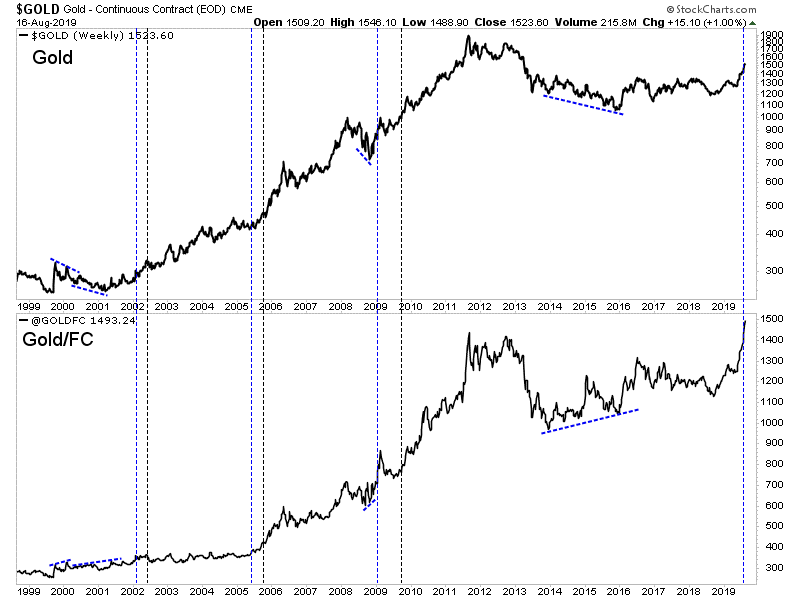
Also, we should note that Gold’s false new high in 1996 and cyclical bull market from 1985 to 1987 were never confirmed by Gold/FC, which showed a negative divergence both instances.
Elsewhere, Gold is very strong against global equity markets and has reached important resistance relative to the S&P 500.
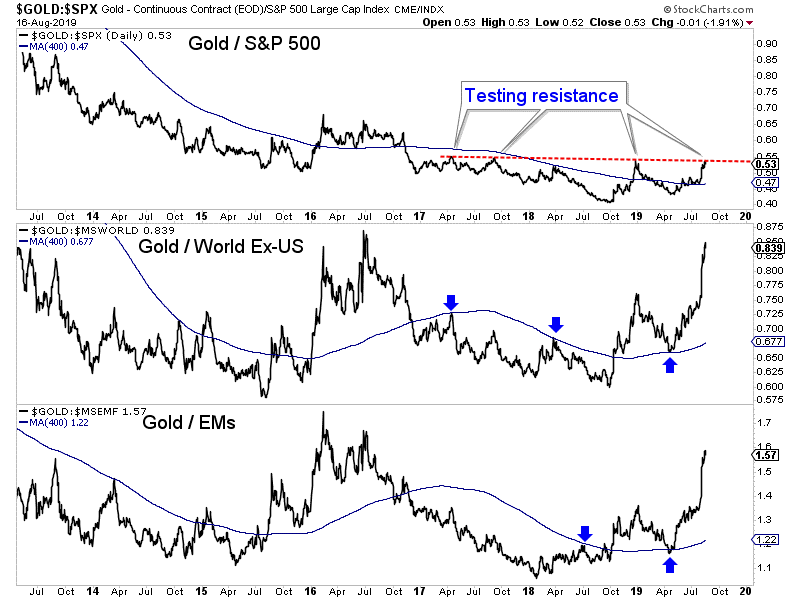
In all of these charts, including Gold against the S&P 500, the market is well above long-term moving averages and support. We do expect Gold to correct soon in both nominal and real terms but it does have plenty of breathing room.
Unlike in 2016, Gold against foreign currencies is at an all time high and the Federal Reserve has started a new cycle of rate cuts.
However, be advised that even within primary uptrends Gold and gold stocks have often consolidated and corrected for several months.
If you missed the recent run, then it is best to be patient, buy value and wait for weakness in the high quality juniors that appear extended. The best time to buy the leaders is during a correction. New opportunities will also emerge. To learn the stocks we own and intend to buy during this weakness that have 3x to 5x potential, consider learning more about our premium service.
The major gold miners’ stocks have soared in recent months, fueled by gold’s decisive breakout to new bull-market highs. Nothing motivates traders like performance, so interest in this long-neglected sector has exploded. While gold stocks’ technicals and sentiment have greatly strengthened, their just-reported Q2’19 results reveal whether their underlying fundamentals support their powerful surge and further upside.
Four times a year publicly-traded companies release treasure troves of valuable information in the form of quarterly reports. Required by the US Securities and Exchange Commission, these 10-Qs and 10-Ks contain the best fundamental data available to traders. They dispel all the sentiment distortions inevitably surrounding prevailing stock-price levels, revealing corporations’ underlying hard fundamental realities.
The definitive list of major gold-mining stocks to analyze comes from the world’s most-popular gold-stock investment vehicle, the GDX VanEck Vectors Gold Miners ETF. Launched way back in May 2006, it has an insurmountable first-mover lead. GDX’s net assets running $11.8b this week were a staggering 44.0x larger than the next-biggest 1x-long major-gold-miners ETF! GDX is effectively this sector’s blue-chip index.
It currently includes 44 component stocks, which are weighted in proportion to their market capitalizations. This list is dominated by the world’s largest gold miners, and their collective importance to this industry cannot be overstated. Every quarter I dive into the latest operating and financial results from GDX’s top 34 companies. That’s simply an arbitrary number that fits neatly into the tables below, but a commanding sample.
As of this week these elite gold miners accounted for fully 94.5% of GDX’s total weighting. Last quarter they combined to mine 297.6 metric tons of gold. That was 33.7% of the aggregate world total in Q2’19 according to the World Gold Council, which publishes comprehensive global gold supply-and-demand data quarterly. So for anyone deploying capital in gold or its miners’ stocks, watching GDX miners is essential.
The major gold miners dominating GDX’s ranks are scattered around the world. 20 of the top 34 mainly trade in US stock markets, 6 in Australia, 5 in Canada, 2 in China, and 1 in the United Kingdom. GDX’s geopolitical diversity is excellent for investors, but makes it more difficult to analyze and compare the larger gold miners’ results. Financial-reporting requirements vary considerably from country to country.
In Australia, South Africa, and the UK, companies report in half-year increments instead of quarterly. The big gold miners often publish quarterly updates, but their data is limited. In cases where half-year data is all that was made available, I split it in half for a Q2 approximation. While Canada has quarterly reporting, the deadlines are looser than in the States. Some Canadian gold miners drag their feet in getting results out.
While it is challenging bringing all the quarterly data together for the diverse GDX-top-34 gold miners, analyzing it in the aggregate is essential to see how they are doing. So each quarter I wade through all available operational and financial reports and dump the data into a big spreadsheet for analysis. The highlights make it into these tables. Blank fields mean a company hadn’t reported that data as of this Wednesday.
The first couple columns of these tables show each GDX component’s symbol and weighting within this ETF as of this week. While most of these stocks trade on US exchanges, some symbols are listings from companies’ primary foreign stock exchanges. That’s followed by each gold miner’s Q2’19 production in ounces, which is mostly in pure-gold terms. That excludes byproduct metals often present in gold ore.
Those are usually silver and base metals like copper, which are valuable. They are sold to offset some of the considerable expenses of gold mining, lowering per-ounce costs and thus raising overall profitability. In cases where companies didn’t separate out gold but lumped all production into gold-equivalent ounces, those GEOs are included instead. Then production’s absolute year-over-year change from Q2’18 is shown.
Next comes gold miners’ most-important fundamental data for investors, cash costs and all-in sustaining costs per ounce mined. The latter directly drives profitability which ultimately determines stock prices. These key costs are also followed by YoY changes. Last but not least the annual changes are shown in operating cash flows generated, hard GAAP earnings, revenues, and cash on hand with a couple exceptions.
Percentage changes aren’t relevant or meaningful if data shifted from positive to negative or vice versa, or if derived from two negative numbers. So in those cases I included raw underlying data rather than weird or misleading percentage changes. Companies with symbols highlighted in light-blue have newly climbed into the elite ranks of GDX’s top 34 over this past year. This entire dataset together is quite valuable.
It offers a fantastic high-level read on how the major gold miners are faring fundamentally as an industry. In Q2’19 the world’s larger gold miners continued their longstanding struggle against declining production. Last quarter was another major transition one with this past year’s gold-stock mega-mergers finally settled out. They’ve considerably altered major gold miners’ global landscape, ramping concentration risks in GDX.
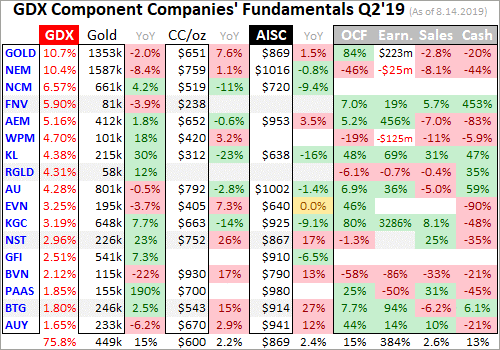
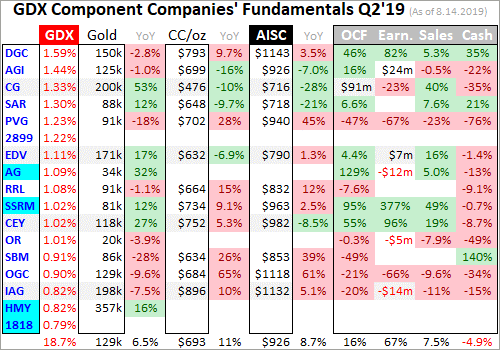
Since Q2’19 was effectively the first quarter with those gold-stock mega-mergers complete, we have to start with them. In late September 2018, the world’s second-largest gold miner Barrick Gold rocked this small contrarian sector. It declared it was buying competitor Randgold in an all-stock acquisition worth $6.5b! That deal was to make Barrick the world’s largest gold miner, and was finalized in early January 2019.
But Barrick’s arch-rival Newmont wasn’t willing to lose the pole position, so within weeks it responded with a bigger salvo. In mid-January it announced it was buying its own major gold miner Goldcorp, which was about twice as large as Randgold in gold-output terms! Size does matter for elite gold-mining executives. This massive $10.0b all-stock deal wasn’t consummated until mid-April, encompassing most of Q2’19.
So last quarter was the first one where these new bigger and badder gold-mining behemoths dominated this sector and therefore GDX. Understanding these mega-mergers and their implications is essential for gold-stock traders. Back in mid-February I wrote a comprehensive essay explaining these deals and why they were done. They were desperate and expensive attempts to mask flagging production at both giants.
By the end of 2018, Barrick had suffered colossal annual production declines in 7 of the last 9 quarters averaging 12.4% year-over-year! It had proven incapable of growing its own operations organically, and thus had to resort to buying more. While Newmont had done a far-better job of maintaining its massive gold output, that too shrunk by an average of 5.9% YoY in 2018’s first three quarters. That trend was concerning.
I doubt Newmont’s managers would’ve bought Goldcorp if Barrick hadn’t forced their hand. But seeing their largest competitor gobble up a major gold miner was a shrill wake-up call. New gold deposits that are large enough to support operations at these giants’ huge scales are almost impossible to find, and take over a decade to develop. So buying production is the only way they can maintain their mining tempos.
But sadly for Barrick and Newmont shareholders, these mega-mergers look like an epic boondoggle! Both Randgold and Goldcorp were also suffering shrinking production as I outlined in that mega-merger essay. Combining two sets of major gold miners where all four already struggled to maintain their outputs wouldn’t fix this intractable problem. The mergers just mask it, and only for the first four quarters post-deals.
Narrowly the world’s largest gold miner by market cap, Barrick Gold reported its Q2’19 results on August 12th. Its mega-merger was trumpeted as “building a business that would be a model of value creation for the mining industry.” Barrick’s Q2 gold production rocketed 26.8% higher YoY. But if Randgold’s from Q2’18 is added in to those comparable results, the combined giant actually saw a 2.0% YoY decline in output!
The inexorable depletion-driven shrinkage continues, which will become glaringly apparent when Q1’20 rolls around after 2019’s four quarters of pre-merger to post-merger comparisons. Barrick sure looks to have squandered $6.5b of shareholders’ capital on four quarters of production growth! They should have been furious. If Barrick failed to grow its own output for years, how can it grow that from Randgold’s mines?
So in these tables the year-over-year comparisons show the new post-merger Barrick versus the smaller pre-merger Barrick and Randgold combined in Q2’18. I did the same thing for Newmont and Goldcorp, comparing the newly-merged giant’s Q2’19 results with the total of both its predecessors in Q2’18. It is really important investors and speculators understand that these gold-mining behemoths are not growing.
The new Newmont Goldcorp released its Q2 results on July 25, touting its mega-merger as having “positioned Newmont Goldcorp as the world’s leading gold business for decades to come.” And not surprisingly Newmont’s quarterly gold production soaring 36.6% YoY looked amazing. With gold stocks surging with gold in the month or so before that release, the financial media celebrated Newmont’s huge growth.
Yet shockingly when this post-merger giant’s Q2’19 production is compared to both its predecessors’ from Q2’18, it actually plunged 8.4% YoY! One-upping Barrick, Newmont’s managers apparently blew $10.0b of their investors’ holdings to show four quarters of big trans-merger production growth through Q1’20. But once Q2’20 arrives, all the comparisons will be post-merger and the shrinkage will again become apparent.
These new gold-mining giants are dominating and really distorting their sector. This week Newmont and Barrick commanded a total market capitalization of $63.4b, or 28.7% of the GDX top 34’s total! In terms of GDX weighting, they now account for 21.2% together. That compares to 16.4% in Q2’18 for just the two acquiring companies, and 26.1% for all four major gold miners. GDX is very concentrated in these giants.
Together Barrick and Newmont controlled 30.7% of the total Q2’19 gold production of the GDX top 34. If either of these colossi stumble in coming quarters hurting their stock prices, GDX will get dragged down with them. Traders need to realize GDX is more risky and less diversified than it was before these gold-stock mega-mergers. If you have doubts that Barrick and Newmont can grow, be wary of owning GDX!
Prior to last quarter, the primary theme of the major gold miners was inexorably declining production. I’ve discussed it extensively in earlier essays in this series, including the ones on Q1’19’s and Q4’18’s results from the GDX top 34. The gist of their core problem is large economically-viable gold deposits are getting ever-harder to find, and increasingly-expensive and time-consuming to exploit. Gold’s scarcity is mounting.
The world has been scoured for gold for centuries, with the low-hanging fruit long since picked. Really compounding these challenges, the low gold-stock prices in recent years left these companies largely starved of capital. So their exploration budgets cratered, further pinching their pipelines of new deposits to develop into new mines to replace current depleting ones. Thus Q2’s production growth looked amazing.
Together these elite top-34 GDX majors reported mining 9.6m ounces in Q2’19, which was up a big 5.6% YoY! If we could celebrate this as the potential start of a new production-growth trend, these latest results would have a very different tone. Unfortunately this higher collective gold output is another distortion from the mega-mergers. They combined four Q2’18 GDX component stocks into two, making room for two more.
One of the replacement GDX-top-34 components that climbed into these ranks is Harmony Gold, South Africa’s third-largest gold miner. It shot from being GDX’s 44th-largest holding a year earlier to 33rd this week. Harmony produced 357k ozs of gold in Q2’19 now included in the GDX-top-34 total, while none of its was in Q2’18’s. Excluding it alone collapses the GDX top 34’s output growth to 1.7% YoY, relatively flat.
The silver miners First Majestic Silver and SSR Mining were also newly included, producing 34k and 81k ozs of gold in Q2’19. Another traditional major silver miner Pan American Silver diversified heavily into gold over this past year, buying Tahoe Resources. So Tahoe’s former gold output not included in the GDX top 34’s in Q2’18 was added to Pan American’s in Q2’19, which nearly tripled it to 155k ozs last quarter.
Adjust for these new inclusions into GDX’s top-34 ranks, and their total Q2’19 gold production among the comparable companies actually shrunk a modest 0.7% YoY! The major gold miners’ long-vexing growth problems certainly haven’t gone away. And gold-stock investors have long prized production growth above everything else, as it is inexorably linked to company growth and thus stock-price-appreciation potential.
Sooner or later global peak-gold production will be reached, after which it starts declining on balance as major gold miners fail to find enough new deposits to replace depleting ones. That will leave smaller mid-tier gold miners able to consistently grow their output far more attractive for investors than the stagnating larger majors. So the major-dominated GDX isn’t the best way to deploy investment capital in this sector.
The production-cost front in Q2’19 highlighted the majors’ challenges. Gold-mining costs are mostly fixed quarter after quarter, with production generally requiring the same levels of infrastructure, equipment, and employees. These big fixed costs are largely determined during mine-planning stages, when engineers and geologists decide which gold-bearing ores to mine, how to dig to them, and how to recover their gold.
Because these ongoing mining costs are spread across quarterly production, gold output and unit costs are usually inversely proportional. The richer the gold ores fed through fixed-capacity mills, the more gold produced. The more gold produced, the more ounces to bear mining costs which lowers per-ounce costs and thus increases profitability. Q2’19’s slightly-lower gold output should’ve led to slightly-higher costs.
There are two major ways to measure gold-mining costs, classic cash costs per ounce and the superior all-in sustaining costs per ounce. Both are useful metrics. Cash costs are the acid test of gold-miner survivability in lower-gold-price environments, revealing the worst-case gold levels necessary to keep the mines running. All-in sustaining costs show where gold needs to trade to maintain current mining tempos indefinitely.
Cash costs naturally encompass all cash expenses necessary to produce each ounce of gold, including all direct production costs, mine-level administration, smelting, refining, transport, regulatory, royalty, and tax expenses. In Q2’19 these top-34-GDX-component gold miners that reported cash costs averaged $641 per ounce. Bucking the production trend, this was actually up a sharp 5.2% YoY from Q2’18’s read!
Neither of the new mega-miners helped, with Barrick and Newmont seeing cash costs climb by 7.6% and 1.1% YoY to $651 and $759 respectively. Dragging the average higher was Peru’s Buenaventura, which continues to struggle with production issues. Its gold mined in Q2’19 plunged 22.0% YoY, forcing cash costs up 16.7% to an extreme $930! Excluding that wild outlier, the rest of GDX’s top 34 averaged $630.
Way more important than cash costs are the far-superior all-in sustaining costs. They were introduced by the World Gold Council in June 2013 to give investors a much-better understanding of what it really costs to maintain gold mines as ongoing concerns. AISCs include all direct cash costs, but then add on everything else that is necessary to maintain and replenish operations at current gold-production levels.
These additional expenses include exploration for new gold to mine to replace depleting deposits, mine-development and construction expenses, remediation, and mine reclamation. They also include the corporate-level administration expenses necessary to oversee gold mines. All-in sustaining costs are the most-important gold-mining cost metric by far for investors, revealing gold miners’ true operating profitability.
These GDX-top-34 gold miners reported average AISCs of $895 per ounce in Q2’19, surging 4.6% higher YoY despite slightly-lower production! Those were relatively high absolutely too, the highest seen out of all 13 quarters since Q2’16 when I started this deep-quarterly-results research thread. Plenty of major gold miners are seeing their own costs rise as their production declines, ratcheting up the industry average.
$895 certainly isn’t a problem with gold prices averaging $1309 in Q2’19, enabling hefty profit margins around $414 per ounce. But the trend of rising production costs among the majors leaves them relatively less attractive going forward compared to their smaller peers gradually lowering their costs through higher outputs. This rising-cost trend needs to be watched, as it will retard the majors’ profits growth if it persists.
With gold rocketing back over $1500 in the last couple weeks to hit 6.3-year secular highs, it is easy to assume the gold miners must be thriving fundamentally. And they likely are. But realize the lion’s share of the recent huge gold gains didn’t start until late June when gold decisively broke out to new bull-market highs. So these Q2 results don’t yet reflect these new higher gold prices. That will come in Q3’s results.
Gold’s lofty $1436 average price so far this quarter is a whopping 9.7% higher quarter-on-quarter than Q2’s! So the current potential profitability of the gold miners post-gold-breakout is far higher than seen last quarter. Assuming the GDX top 34’s average all-in sustaining costs hold flat near $895 this quarter, that implies Q3 profits running $541 per ounce. That’s up a massive 30.7% QoQ from what was seen in Q2!
This incredible profits leverage to gold is what makes gold stocks so alluring during major gold uplegs. Their earnings grow so darned fast, 3.2x gold’s advance in this example, that big stock-price gains are usually fundamentally-justified. In Q2’19, GDX averaged $22.03 per share. That’s when you should’ve been buying gold stocks, when they were low and out of favor. I explained their bullish outlook in early April.
So far in Q3’19 which is about half over, GDX has averaged $27.32 which is 24.0% higher QoQ. That is right in line with expected profits growth among the major gold miners this quarter given the much-higher prevailing gold prices. So gold stocks’ strong gains in recent months are likely fundamentally-righteous, supported by underlying earnings growth and sustainable as long as gold holds over $1436 into quarter-end.
The GDX top 34’s accounting results in Q2’19 didn’t match their slight production decline when adjusted for the mega-mergers. Interestingly their total revenues of $11.0b were dead flat compared to Q2’18’s, despite average gold prices being 0.2% better. A material factor in the relatively-weak sales was silver, with the GDX top 34 mining 11.3% less than they did in Q2’18. Miners are increasingly diversifying out of silver.
With its price languishing at miserable lows compared to gold for years now, it has been nowhere near as profitable to mine as gold. Silver recently started outperforming again after gold’s bull-market breakout, which began to improve precious-metals sentiment. But silver’s upside will have to exceed gold’s on balance for years to convince gold miners to invest in gold deposits with significant silver byproducts again.
Those $11.0b of sales the GDX-top-34 gold miners did yielded hard GAAP earnings of $621m in Q2, for a pathetic 5.7% profits margin. Some impairment charges contributed, led by Wheaton Precious Metals writing down $166m on a streaming agreement it overpaid for. Hedging was also a factor, as some of these major gold miners lock in future selling prices. That’s going to kill their profits in Q3 after gold’s surge.
The new monster gold miners had divergent earnings pictures last quarter. Barrick reported $223m in net profits, 35.9% of the entire GDX top 34’s! That was without any unusual gains either, clean operating results after its second merged quarter. Its $869 AISCs contributed, which were a long way below the average gold price in Q2. That was a vast improvement from Q2’18, when Barrick and Randgold lost $18m.
The newly-merged Newmont on the other hand reported a $25m loss last quarter, which was also clean with no unusual charges. Probably thanks to that $10.0b buyout of Goldcorp, expenses skyrocketed 55.1% YoY despite the flat gold prices! Shareholders should be getting out the torches and pitchforks. In Q2’18, together Newmont and Goldcorp reported decent profits of $161m. Did the merger impair that potential?
The operating-cash-flow front looked much better, with the GDX top 34’s total climbing 10.5% YoY to $3.2b in Q2’19. Strong OCF generation is essential to funding future growth, both expanding existing gold mines and adding new ones. Every single GDX-top-34 component reporting OCFs had positive ones, with 18 of those 29 seeing growth despite the flat gold prices. That’s an encouraging sign for the majors.
These elite gold miners collectively reported $10.1b of cash in their coffers at the end of Q2. While that was down 20.0% YoY, it is still a healthy treasury. The gold miners tap into their cash hoards when they are building or buying mines, so declines in overall cash balances suggest more investment in growing future production. They desperately need to do that to slow their depletion inexorably shrinking their output.
Overall the major gold miners of GDX reported a solid Q2’19, which again was mostly before gold surged in its powerful breakout rally of recent months. Unless gold collapses in the next 6 weeks, Q3’19 results should prove radically better. While the risks of a normal healthy short-term gold correction are high due to gold-futures speculators’ excessively-bullish positioning, gold-stock fundamentals support higher prices.
A quarter ago when I published my GDX Q1’19 results essay, GDX had slumped 1.6% year-to-date and no one wanted to buy gold stocks low despite their huge opportunities. That has sure changed as I forecast it would, with GDX soaring to 34.7% YTD gains as of the middle of this week! Since traders love chasing winners, gold stocks are way more popular. GDX definitely isn’t the best way to own this sector though.
This ETF’s potential upside is really retarded by large gold miners struggling to grow their production. So the smart investment capital will seek out the smaller mid-tier and junior gold miners actually able to increase their outputs. Investing in excellent individual miners with superior fundamentals has far-greater upside potential. While some are included in GDX, their relatively-low weightings seriously dilute their gains.
To multiply your capital in the markets, you have to trade like a contrarian. That means buying low when few others are willing, so you can later sell high when few others can. In the first half of 2019 well before gold’s breakout, we recommended buying many fundamentally-superior gold and silver miners in our popular weekly and monthly newsletters. We’ve recently realized big gains including 109.7%, 105.8%, and 103.0%!
To profitably trade high-potential gold stocks, you need to stay informed about the broader market cycles that drive gold. Our newsletters are a great way, easy to read and affordable. They draw on my vast experience, knowledge, wisdom, and ongoing research to explain what’s going on in the markets, why, and how to trade them with specific stocks. Subscribe today and take advantage of our 20%-off summer-doldrums sale! The biggest gains are won by traders diligently staying abreast so they can ride entire uplegs.
The bottom line is the major gold miners’ just-reported Q2’19 earnings season was solid. Gold didn’t take off until late June, so they hadn’t yet materially benefitted from its breakout surge. With the recent mega-mergers finally settling out, gold stocks saw slightly-lower production at materially-higher costs. That hit accounting profits, but operating-cash-flow generation was strong. Higher gold will greatly improve Q3 results.
That being said, the major gold miners are still struggling to grow their production. The mega-mergers will help mask that for one year, but the intractable underlying problem persists. That leaves smaller mid-tier gold miners with superior fundamentals much more attractive for future upside potential. That is where investors should focus their capital allocations to gold stocks, which should approach 10% in all portfolios.
Adam Hamilton, CPA
August 19, 2019
Copyright 2000 – 2019 Zeal LLC (www.ZealLLC.com)
Corrections are inevitable, but current conditions support a prolonged rally in the gold market, TD Securities says in an equity research report.
“Before we restate our bullish thesis for precious metals, we should acknowledge that positioning in the gold market is at extreme levels, with Comex net longs near all-time highs and trading volumes at near double the averages of last year,” the report says.
This type of market posture, with everyone enthusiastically lined up in one direction, often precedes a reversal and a gold correction now could be exacerbated by the magnitude of the move required to restore normalcy to the market, TD says.
Of course, the macro picture is anything but normal. TD notes that there is now broad consensus around the idea that the deteriorating U.S. and global economic outlook will mean that Fed Chair Powell’s ‘mid-cycle adjustment’ in July will turn into an extended cutting cycle, with the bond market pricing in 25-50 bps of cuts by year-end.
TD Global Rates, which called for cuts ahead of the market, is calling for 50 bps of additional easing in 2019, followed by an additional 75 bps of easing in 2020. In many countries, real rates are already negative, and the discussion is around tiering (allowing more deeply-negative yields), QE, and the potential for competitive currency devaluation, TD says,
Despite Rally, Gold Equities Undervalued vs. Gold
The GDX (large-cap) index has rallied around 35% YTD, while the GDXJ (small-cap) is up only about 31% despite having outperformed its larger brother since the beginning of June. Gold, for reference, is up around 19% YTD.
Despite this, gold equities as measured by the S&P/TSX Gold Index are lagging their historical relationship to gold, both when compared with the most recent peak in 2016 and with the peak of the last bull market in 2011, TD notes.
Rotations Key to Maximizing Returns in Prolonged Rally
In a note published in June, TD called the technical breakouts of both gold and silver from their downtrends (corrections within the bull market that began in early 2016). Both metals rallied strongly from that point, with gold up 15% and silver up 16% since then.
TD had also forecast at that time that silver will lag and then outperform gold on a continuation of the rally. Indeed, we saw the gold/silver ratio climb to multi-decade highs above 93 in mid-July before falling to 86 and since then partially retracing that move.
TD’s preferred name for high beta and liquidity, which was highlighted in the June note, was First Majestic Silver, which has rallied approximately 59% since then, strongly outperforming its peers.
TD will publish more on the gold/silver ratio when the retracement/consolidation pattern is complete as TD analysts ultimately expect much stronger gains in silver before the precious metals bull market is over.
- Please click here now. Double-click to enlarge this chart.
- Another glorious day for gold investors is underway.
- Please click here now. Double-click to enlarge.
- The only better-looking chart than gold right now is… silver!
- Years ago, I coined the term “flagification” to describe the formation of multiple flags on the gold and silver charts.
- This technical action is rare and outrageously bullish.
- Because it happens with technical indicators overbought and the commercial traders adding seemingly overwhelming short positions on the COMEX, even the best top callers need to use caution in this type of market.
- I’ve described the current events in America as resembling a hybrid of what occurred in 1929, 1937, 1968, and 2008.
- Stagflation, tariff taxes, US-China empire transition, populist worship of debt-obsessed politicians, and a peaking global business cycle all appear to be in play… at the same time.
- Please click here now. Double-click to enlarge this horrifying US stock market chart.
- Flagification may soon be in play, but not in a good way! A huge bear flag has already formed on this short-term hourly chart.
- I always recommend that US stock market investors go to the sidelines at the start of August with some of their capital. As the business cycle matures, the danger of a crash in September or October increases exponentially.
- Please click here now. Double-click to enlarge. The weekly chart action of the Dow is ominous, while gold and silver accelerate their upside action.
- What’s happening now in both gold and the stock market is reminiscent of the late 1960s when American stagflation began.
- Please click here now. Double-click to enlarge.
- The gold stocks versus gold monthly ratio chart probably is the best illustration of the emerging stagflation theme.
- In 2007 gold stocks were at a high price in relation to gold. Now they are very low and basing.
- Mainstream analysts have suggested different interest rates that would represent “normalization”. Likewise, some gold stock analysts have suggested that GDX would be “normalized” at a price of about $40.
- I would agree with that number if deflation was still the theme rather than emerging stagflation and empire transition. Looking at the long-term ratio chart, a case can be made that GDX would now only be “normalized” at a price somewhere between $100 and $300 a share.
- Even after the huge rally in 2019, GDX is still trading below its 2008 lows on the GDX versus gold ratio chart. The bottom line:
- In a stagflationary environment, the upside potential for gold is fabulous and for gold stocks versus gold it is mind boggling.
- Please click here now. Double-click to enlarge this key GDX daily chart.
- The stoploss is set at $28 but if GDX moves above $30 (and it could happen today) eager accumulators can add to positions and raise the stop to about $27.70.
- In a powerful market featuring such events as “flagification” and a US President who engages in regular QE worship, there’s no point in setting any target price at this early stage in the upside game. My suggestion is just to move stoplosses higher and higher as GDX makes one fresh and glorious minor trend high after another!
Special Offer For Website Readers: Please send me an Email to freereports4@gracelandupdates.com and I’ll send you my free “Get Jacked With Gold!” report. I focus on key miners trading in the $2-$5 price range. I include key buy and sell action points in a video that can be viewed on a smart phone!
Thanks,
Cheers
Stewart Thomson
Graceland Updates
Email:
Stewart Thomson is a retired Merrill Lynch broker. Stewart writes the Graceland Updates daily between 4am-7am. They are sent out around 8am-9am. The newsletter is attractively priced and the format is a unique numbered point form. Giving clarity of each point and saving valuable reading time.
Risks, Disclaimers, Legal
Stewart Thomson is no longer an investment advisor. The information provided by Stewart and Graceland Updates is for general information purposes only. Before taking any action on any investment, it is imperative that you consult with multiple properly licensed, experienced and qualified investment advisors and get numerous opinions before taking any action. Your minimum risk on any investment in the world is: 100% loss of all your money. You may be taking or preparing to take leveraged positions in investments and not know it, exposing yourself to unlimited risks. This is highly concerning if you are an investor in any derivatives products. There is an approx $700 trillion OTC Derivatives Iceberg with a tiny portion written off officially. The bottom line:
Are You Prepared?
Last week was another strong one for the precious metals sector.
Gold gained a whopping $51/oz or 3.5%. The gold stocks (GDX, GDXJ) advanced by roughly 6%. Silver gained 4%.
Momentum in the sector began to build once Gold surpassed resistance at $1420-$1425/oz. We had noted the lack of resistance from $1425 to $1525-$1550/oz.
Gold has not reached $1550/oz yet but as it inches higher, some technical and sentiment indicators are urging caution.
Gold’s net speculative position of 54% is very close to the peaks of 55% to 60% seen since 2000. It’s possible the commercial hedgers will start covering at some point like they did in 2006 and 2010 but for now we have to assume they won’t if $1550/oz holds as resistance.
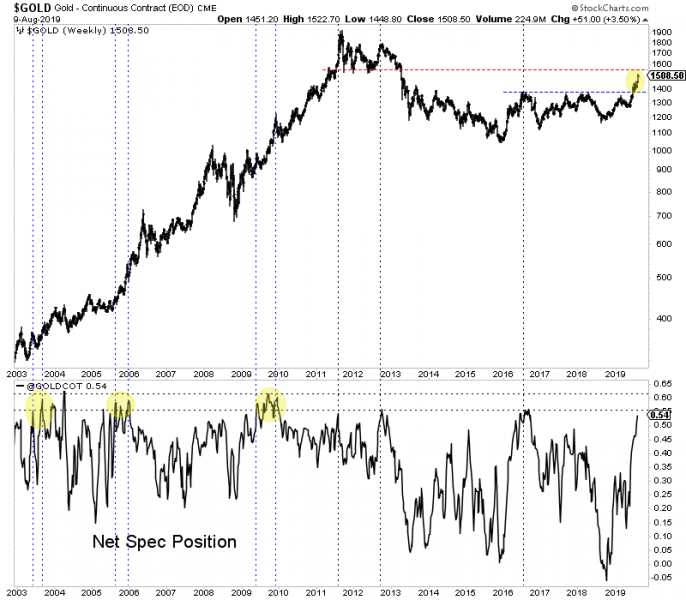
In the next chart we plot Gold’s net speculative position (51%) and the 21-day average of the daily sentiment index (DSI) from 2002 to 2011 (84%).
During that strong 10-year period, those figures of 51% and 84% were reached seven times. Five of those seven times Gold corrected or consolidated for at least a few months.
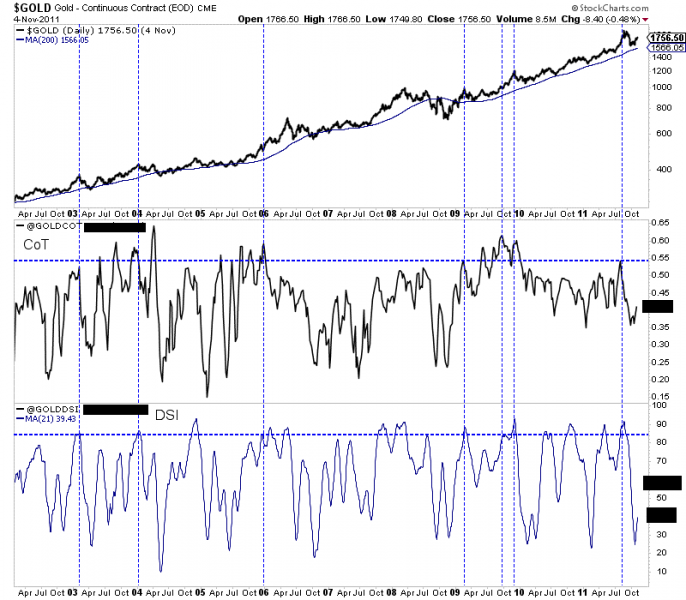
Turning to the gold stocks (and GDX specifically), we find a fairly overbought condition while the market approaches multi-year resistance at $31-$32.
The bullish percentage index (BPGDM) and a 20-day moving average of new highs in GDX are approaching the levels they peaked at in July 2016.
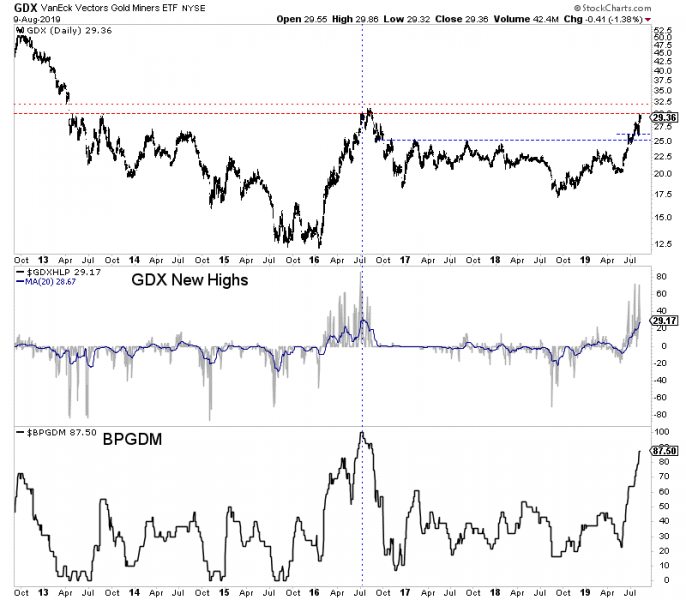
The trend in precious metals is strong and the fundamentals are bullish but there can obviously be corrections and consolidations within strong trends.
Sentiment indicators are becoming a concern and Gold and gold stocks (GDX) are approaching obvious resistance levels at $1550/oz and $31-$32.
This is not the time to be placing aggressive bets on Gold or the senior gold stocks. If there is a sector correction, those areas figure to be hit harder than Silver or junior mining stocks which are not as extended.
If you missed the recent run then it is best to be patient, buy value and wait for weakness in anything that is strong but too extended. New opportunities will emerge. To learn the stocks we own and intend to buy during the next correction that have 3x to 5x potential, consider learning more about our premium service.
By Jordan Roy-Byrne CMT, MFTA
August 14, 2019
The precious metals sector appears to have started a correction.
It was roaring higher until natural resistance kicked in and the U.S. Dollar grinded its way higher, towards its 2019 high. Factor in the Fed decision this week and it has created a natural “buy the rumor, sell the news” event.
We cannot know for certain what the Federal Reserve will do or even more importantly, how the market will react. But we can take note of key levels in these markets.
Gold has held above $1400/oz but has been unable to break past resistance at $1420-$1425/oz. A retest of $1385/oz is quite possible and so is a test of $1365/oz.
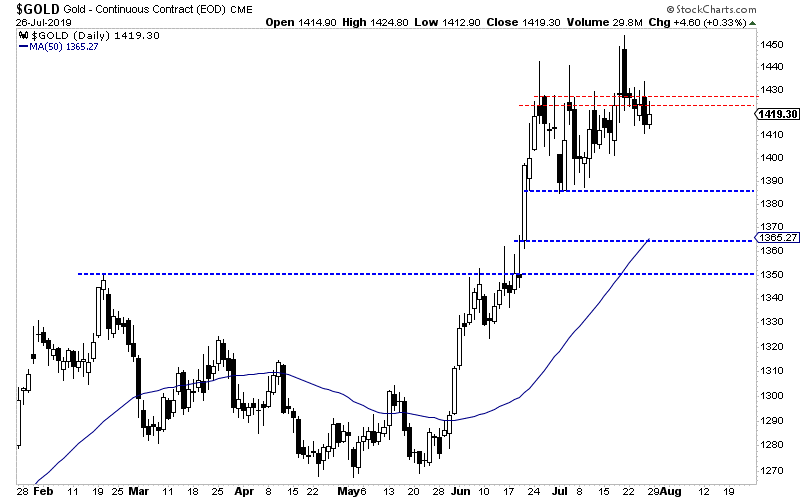
Silver has outperformed Gold since it broke above its 400-day moving average, which provided strong resistance dating back to the end of 2017.
Silver encountered resistance at $16.60-$16.70/oz and could test initial support at $16.20/oz. Below that is strong support at $15.95/oz.
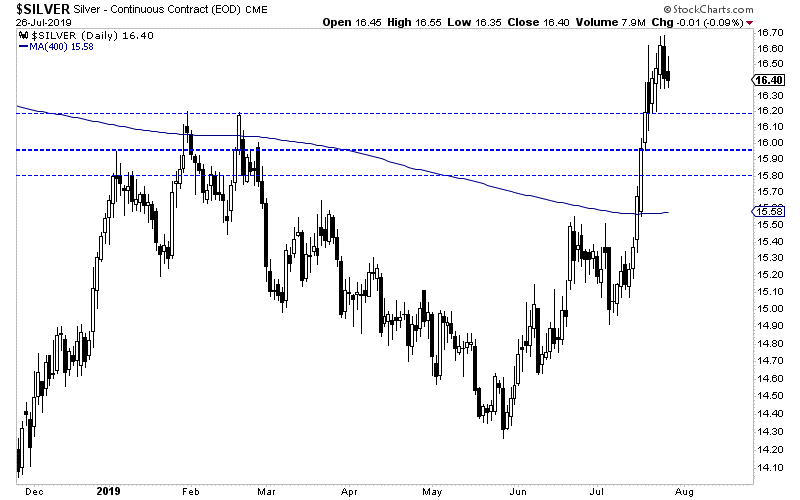
Turning to the gold stocks, we find a clear setup between support and resistance.
GDX, the ETF for large gold producers has resistance at $28 but good support above $25.00, which was previous resistance for nearly three years. Look for initial support around $26.00.
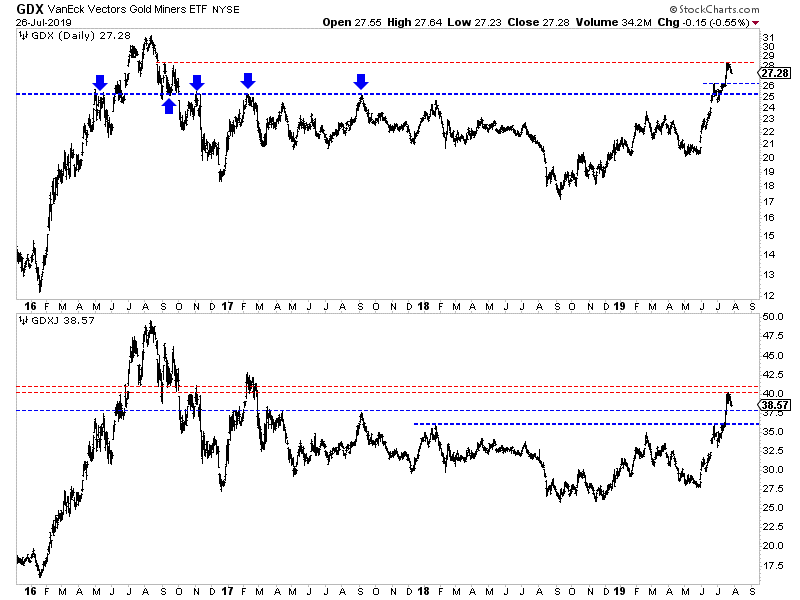
GDXJ, the ETF for the “senior” junior companies, faces resistance at $40-$41. It has initial support around $37.50 with strong support at $36.00.
Regardless of what the Fed does or says, my expectation is precious metals will test these levels and ultimately hold them. The Fed and global central banks want to ease policy and this figures to be more than a one-off.
Precious metals became overbought and a correction is in order.
Investors who smartly positioned in recent months should continue to hold their winners. If the sector continues to correct then look to be a buyer at the aforementioned support levels.
Look to focus your capital on fresh opportunities and value plays that are not very overbought or extended. To learn the stocks we own and intend to buy on this weakness that have 3x to 5x potential, consider learning more about our premium service.
Jordan Roy-Byrne CMT, MFTA
July 30, 2019
It was a huge week for the gold stocks. GDX gained nearly 7% while GDXJ surged over 10%.
Gold hit $1450/oz after Thursday before selling off Friday. Silver met the same fate on Friday but managed to close the week up over 6% and at a new 52-week high.
Let’s take a look at the current technicals.
Gold closed the week just below $1427/oz. If it remains above $1420-$1425, then it is likely to trend towards $1475/oz, which is the only resistance between $1425 and $1525.
If Gold trades back below $1420 then there is a risk it could test $1380 again.
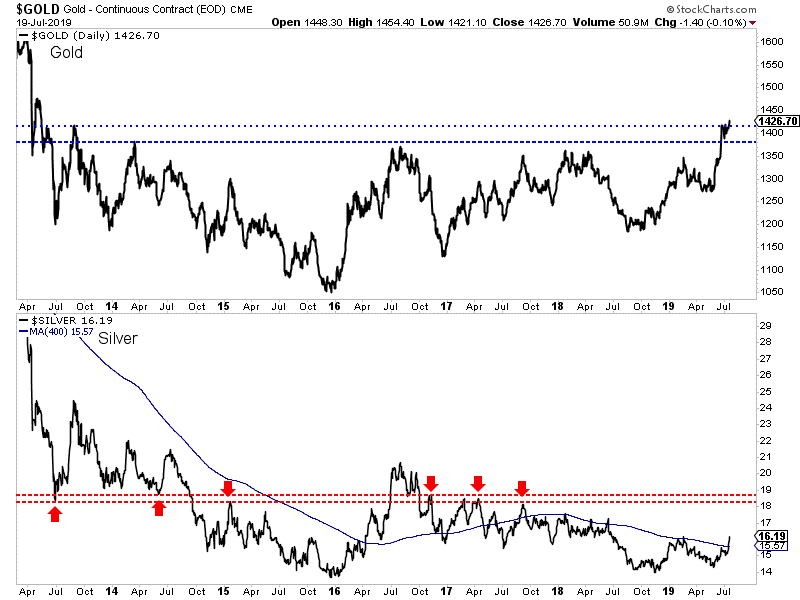
Silver has taken out resistance at its 400-day moving average in convincing fashion but needs to surpass its February 2019 high. Its next major resistance target is the mid $18s.
Turning to the stocks, we start with GDX which is closing in on its 2016 high. Should Gold trend towards $1475/oz then GDX would likely retest that 2016 high at $31.
Breadth remains strong and so too is GDX’ relative strength. GDX relative to the S&P made a 21-month high and relative to Gold made a 2-year high.
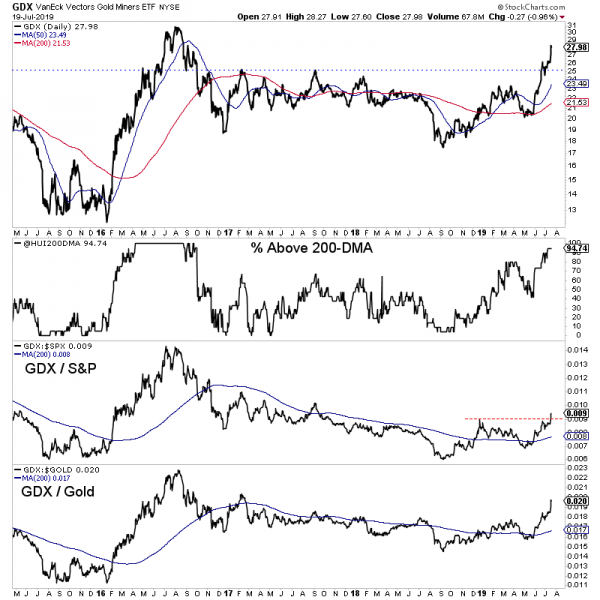
Both GDXJ (juniors) and the HUI (miners only) still have room to go before reaching their 2016 highs.
In fact, both are facing some immediate overhead resistance. For GDXJ which closed at $39.50, that resistance is at $40-$41. For HUI which closed at 211, that resistance is at 220.
The support levels are $36 for GDXJ and 195 for the HUI.
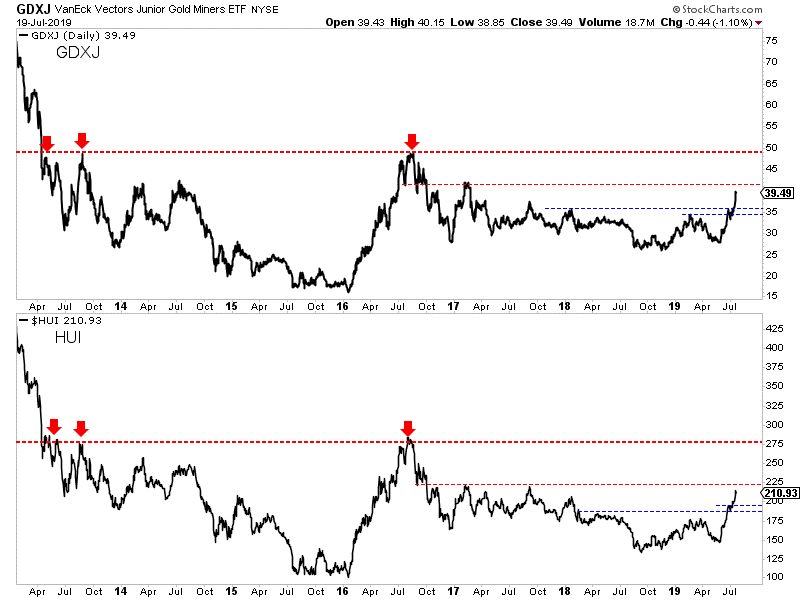
If Gold and Silver maintain current levels, then the immediate bias remains higher and GDX could soon test its 2016 high.
GDXJ and HUI have roughly 30% upside to their 2016 highs. Such a move probably requires a move in Gold to at least $1525/oz.
However, if Friday was the start of a correction then GDX could test $26 and GDXJ could test $36.
For investors in the juniors and seniors, continue to hold winners. If the sector corrects, then look to take advantage of that weakness. If metals and shares maintain these levels then focus your capital on fresh opportunities and value plays that are not overbought or extended. To learn the stocks we own and intend to buy that have 3x to 5x potential, consider learning more about our premium service.
By Jordan Roy-Byrne CMT, MFTA
July 23, 2019
Gold and gold stocks especially continue to shrug off bits and pieces of bad news.
No escalation in the trade war? The selloff lasted one day and the sector rebounded strongly the following day.
Strong headline jobs number? Again, the weakness was a buying opportunity.
This past week there was more.
The June CPI report came in hotter than expected, which could mitigate the degree the Fed eases in the future. Also, bond yields in the US have risen the entire week.
No dice.
Gold closed the week at $1412/oz while the gold stocks closed just inches from new highs on the daily charts.
Turning to the technicals of the gold stocks, we see both underlying and relative strength.
Nearly 95% of the large miners closed above the 200-day moving average. Meanwhile GDX relative to both the S&P 500 and Gold is above a rising 200-day moving average. The GDX to Gold ratio is at a 2-year high while the GDX to S&P 500 ratio is very close to a new 52-week high.
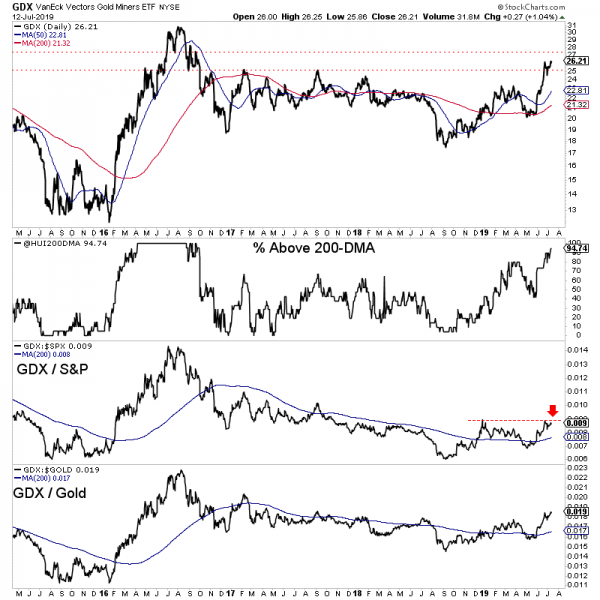
GDXJ is lagging GDX a bit but it is coming around.
90% of the ETF closed above the 200-day moving average. That is the highest reading in nearly three years.
GDXJ relative to the S&P and Gold has turned bullish and is holding above upward sloping 200-day moving averages.
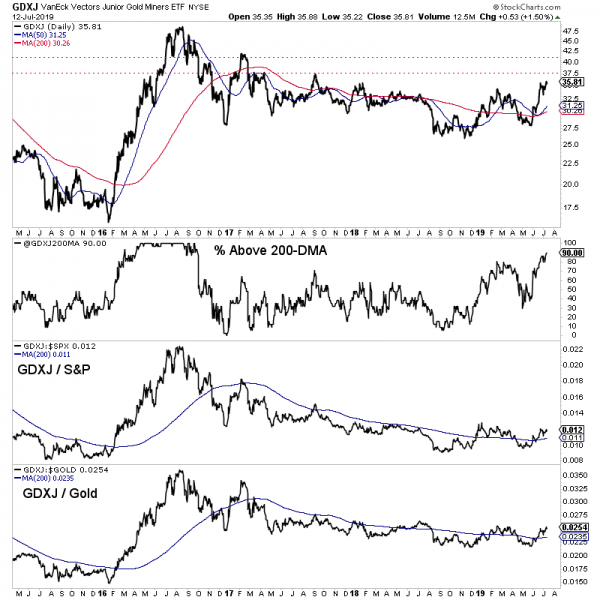
The immediate upside targets for GDX and GDXJ are GDX $27.50 and GDXJ $37.50. The next level of targets would be GDX $30 and GDXJ $41.
Gold has endured some selling in the $1420-$1425/oz range but has remained bid around $1400/oz. A daily close above $1420/oz would remove much of the resistance from here to the low $1500s.
For investors in the juniors and seniors, continue to hold your winners and focus your capital on fresh opportunities and value plays that could move with the next leg higher. To learn which stocks we own and intend to buy that have 3x to 5x potential, consider learning more about our premium service.
Gold surged dramatically in recent weeks, powering higher to a decisive bull-market breakout. Gold’s first major secular highs in years have really improved sentiment, with bullishness mounting. But gold-futures buying fuel is largely exhausted, after the colossal amount expended to catapult gold back over $1400. That leaves this metal at high risk of suffering a major selloff, a healthy correction in an ongoing bull market.
Even the most-powerful bull markets flow and ebb, taking two steps forward before one step back. Gold is certainly no exception. At best in late June, its current bull extended to modest 35.4% gains over 3.5 years. Those weren’t linear, the path to gold’s recent breakout high was quite volatile. It included a 29.9% upleg, a 17.3% correction, a 20.4% upleg, a 13.6% correction, and today’s upleg running 21.2% at best.
This alternating repeating bull-market pattern is simple, uplegs are inevitably followed by material selloffs often extending into correction territory. Periodic corrections are essential to keep bulls healthy, working off the excessive greed that builds as uplegs peak. That risks sucking in too much capital too soon, prematurely burning out bulls. Corrections rebalance sentiment, bleeding away greed to extend bulls’ longevity.
Even though they are inevitable, normal corrections stress out the majority of traders. The selling taints their psychology and clouds their perspectives of longer-terms trends in play. They fret bulls are dying, and sell out too early and too low. Instead corrections should be embraced, as they offer the greatest opportunities to buy relatively low within ongoing bulls! Entering near correction lows amplifies gains.
While gold’s current bull clocked in at 35.4% total in late June, its three major uplegs added up to much-larger 71.5% gains. Traders had the potential to more than double gold’s headline gains by attempting to buy relatively low later in corrections and sell relatively high later in uplegs! Although impossible to game bull-market swings’ major lows and highs precisely in real-time, trading near them really boosts capital growth.
The reason gold faces high risk for its next major selloff today is speculators’ current positioning in gold futures. Unfortunately spec gold-futures trading has a wildly-disproportional influence over short-term gold price levels. The dominant reason is the extreme leverage inherent in gold futures, which greatly multiplies that capital’s impact on gold prices. This unfair reality has sorely vexed the gold market for decades.
When a normal investor buys gold outright, $1 of capital exerts $1 of buying pressure on the gold price. That’s the way markets are supposed to work. That can be extended with margin in the stock markets, which has had a hard legal limit of 2.0x since 1974. $1 of capital using maximum margin to buy shares in the leading GLD SPDR Gold Shares gold ETF can exert $2 of buying pressure on gold. That’s still reasonable.
But gold-futures trading is way out in its own extreme realm. Each gold-futures contract controls 100 troy ounces of gold. At this Wednesday’s data cutoff for this essay, gold closed at $1417. So each contract wields gold worth $141,700. An investor would have to put up $141,700 to control that much gold, or $70,850 using stock-market-legal-limit leverage on GLD shares. Futures speculators only need $4,000!
That’s no typo, this week the CME Group only requires traders to have $4,000 cash in their accounts for each gold-futures contract they want to trade. That is absurd, enabling extreme maximum leverage of 35.4x! That means a fully-margined gold-futures speculator can exert $35 of buying or selling pressure on gold with each $1 deployed. That temporarily outguns investors, even though they have vastly more capital.
The Federal Reserve has capped stock-market leverage at 2.0x for 45 years because extreme leverage has extreme risks. At 35.4x, a mere 2.8% gold move against speculators’ gold-futures bets would wipe out 100% of their capital risked! This constant threat of ruin forces these traders’ focus to an ultra-myopic short-term span, days or weeks at most. All they can do is ride gold’s immediate momentum, piling on.
As if arbitrarily declaring $1 of gold-futures capital should have up to 35x the influence on gold prices as $1 invested outright isn’t ridiculous enough, it gets worse. Unscrupulous traders can wield gold futures’ extreme leverage like a weapon to manipulate gold prices at key technical and sentimental junctures. One way is spoofing, slamming the market with huge gold-futures orders that are canceled before being executed.
This is not theoretical. In late June the U.S. Department of Justice levied $25m of criminal fines on Merrill Lynch Commodities for this very behavior! And that’s just the tip of the iceberg for gold futures’ extreme leverage being abused to defraud normal investors. This seriously needs to be legally capped at vastly-lower levels. The DoJ’s actual press release did a great job explaining how gold-futures spoofing works.
“…beginning by at least 2008 and continuing through 2014, precious metals traders employed by MLCI schemed to deceive other market participants by injecting materially false and misleading information into the precious metals futures market. They did so by placing fraudulent orders for precious metals futures contracts that, at the time the traders placed the orders, they intended to cancel before execution.”
“In doing so, the traders intended to “spoof” or manipulate the market by creating the false impression of increased supply or demand and, in turn, to fraudulently induce other market participants to buy and to sell futures contracts at quantities, prices and times that they otherwise likely would not have done so. Over the relevant period, the traders placed thousands of fraudulent orders.” These crooks should be in prison!
Compounding gold futures’ gold-price impact, the American gold-futures price is gold’s global reference one. So gold-futures trading moving the gold price heavily influences and sometimes totally controls the entire gold market’s psychology! Investors are motivated to buy and sell gold outright based on what is happening in gold futures. It’s impossible to understand and game gold without closely watching futures.
I had to break my chart into two parts today, lest it get too busy to parse. These superimpose gold’s price through its current bull market over speculators’ gold-futures positioning. Reported weekly by the CFTC in its famous Commitments of Traders reports, specs’ long contracts or upside bets on gold are shown in green while their short contracts or downside bets are rendered in red. They usually dominate gold action.
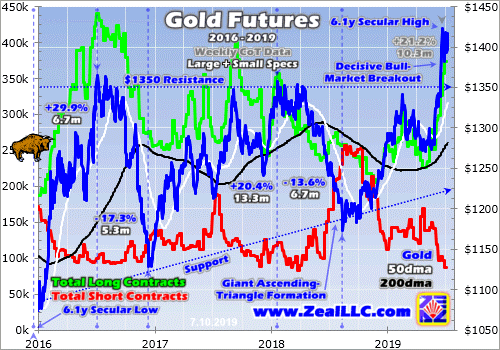
The wildly-disproportional influence on gold prices by speculators’ gold-futures trading is critical for all investors to understand. Let’s start with this gold bull itself, the cadence of its uplegs and corrections. Its maiden upleg erupted in mid-December 2015 out of deep 6.1-year secular lows in gold, and ultimately blasted up 29.9% in 6.7 months by early July 2016. Major selloffs inevitably follow major uplegs in any bull.
So gold plunged 17.3% over 5.3 months into mid-December 2016 in a severe correction. That was way bigger than normal, greatly exacerbated by Trump’s surprise election victory in early November that year. With Republicans controlling the presidency and both chambers of Congress, stock markets soared on hopes for big tax cuts soon. That crushed gold demand, as fully 5/8ths of that correction came after the election!
While ugly, gold remained in a bull market since that massive selloff didn’t cross the -20% threshold for a new bear market. Gold quickly rebounded from those deep lows and gradually powered to another nice bull-market upleg, up 20.4% over 13.3 months leading into late January 2018. This gold bull’s second major upleg was followed by its second major correction, a 13.6% drop over 6.7 months by mid-August 2018.
That birthed today’s third major upleg, which had extended to 21.2% at best over 10.3 months by late June. This past month saw gold get exciting again after decisively breaking out of its years-long giant ascending-triangle technical formation to surge to major new bull-market and secular highs. This bull’s pattern has been upleg, correction, upleg, correction, upleg. What comes next in this series is obvious.
Gold is at high risk for another major selloff, potentially a full-blown correction over 10% again, because of speculators’ gold-futures positioning. This next chart illuminates what the specs were doing during each of this gold bull’s uplegs and corrections including today’s newest one. These hyper-leveraged traders with their outsized impact on gold prices have effectively exhausted their near-term buying, threatening big selling!
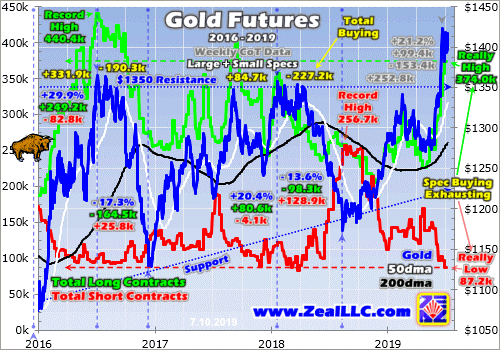
This gold bull’s initial upleg in largely the first half of 2016 was massive, the biggest in this bull so far at 29.9%. That was partially fueled by gold-futures speculators buying a staggering 249.2k long contracts and buying to cover another 82.8k short ones! There are two kinds of buying and two kinds of selling in gold futures, and each set has the same price impact on gold. Thus they can be lumped together for analysis.
Specs can buy new gold-futures contracts to establish long positions, the normal way to buy. But they also buy to cover and close previously-established short positions. The upward pressure on gold from buying longs and covering shorts is identical. On the selling side they can sell their own existing longs, or effectively borrow gold-futures contracts they don’t own to short sell them. Both types hit gold the same way.
Speculators’ total gold-futures buying in this gold bull’s first upleg ran a mind-boggling 331.9k contracts! That’s the equivalent of 1032.4 metric tons of gold. For comparison, total global gold investment demand in the first half of 2016 ran 1091.6t per the World Gold Council’s latest fundamental data. That epic spec long buying catapulted their total upside bets to an all-time-record high of 440.4k contracts as that upleg peaked!
Keep these numbers in mind. This gold bull’s greatest upleg soared 29.9% higher on 331.9k contracts of total buying by gold-futures speculators. That forced their total longs to their highest levels ever seen of 440.4k contracts. As I’ll discuss shortly, today’s latest gold upleg is skating ever closer to those extreme levels. The ice gets pretty thin in that rarefied air of likely gold-futures buying being essentially exhausted.
This gold bull’s first major correction was largely driven by specs reversing that huge long build in largely the second half of 2016. Note the green spec-longs line above collapsed symmetrically to its massive surge in the preceding upleg. Specs dumped 164.5k long contracts and short sold 25.8k more over that severe correction’s exact span. That adds up to 190.3k contracts of total selling, the equivalent of 592.0t.
During gold-bull uplegs the green spec-longs line rises while the red spec-shorts line falls. Then in following corrections that reverses, the green line falling while the red one rises. Gold-futures buying and selling is heavily driving these major bull-market cycles in gold, and that’s not going to change until regulators wake up and radically curtail gold futures’ extreme inherent leverage. Gold’s second upleg straddled 2017.
That was somewhat peculiar, as the spec gold-futures long buying of 80.6k contracts and short covering of 4.1k only totaled 84.7k. That wasn’t much considering gold’s strong 20.4% upleg gains. But realize that gold upleg effectively topped much earlier in early September 2017. Its later upleg peak was marginal. As gold challenged its $1350 bull-market resistance, total spec longs soared as high as 400.1k contracts!
This gold bull’s second correction mostly unfolded during the first half of 2018, and was a textbook-perfect example of heavy spec gold-futures selling. Their green longs line plunged by 98.3k contracts, while their red shorts line rocketed an enormous 128.9k contracts higher. That correction bottomed last August as total spec shorts soared to their own all-time-record high of 256.7k contracts! That portended the next upleg.
Back in early September, I wrote an essay on the “Record Gold/Silver Shorts!”. Published when gold still languished way down at $1196, I concluded then “gold and silver soon soared on short-covering buying following all past episodes of excessive and record short selling. There’s nothing more bullish for gold and silver than extreme shorts! … Record futures shorts are the best gold and silver buy signals available.”
Speculators’ collective gold-futures positions provide both excellent buy signals near major gold lows and excellent sell signals near major gold highs. Smart contrarians get really bullish on gold when specs are really bearish as evidenced by relatively-low longs and relatively-high shorts. And it is just as prudent to get short-term bearish on gold when specs are excessively bullish with relatively-high longs and -low shorts.
This is exactly the situation we’re in today, and it’s growing ominously extreme. This gold bull’s third upleg powered 21.2% higher at best so far as of late June, propelling this metal to a new 6.1-year secular high of $1423. This awesome decisive-bull-breakout upleg was again fueled by enormous gold-futures buying by speculators. They added 99.4k long contracts, while buying to cover a staggering 153.4k short ones!
That adds up to total buying of 252.8k contracts as of gold’s latest peak in late June, or the equivalent of 786.3 metric tons of gold! That’s relevant because it is already 76% of the total gold-futures buying that unfolded during this gold bull’s huge maiden upleg in early 2016. Back then popular gold psychology was waxing really bullish, fostering that extreme gold-futures buying. Getting that high again today is a tall order.
The current gold-futures picture is even worse. While gold hit its latest interim high in late June, the gold-futures speculators kept on buying since. The weekly CoT reports are published late Friday afternoons current to the preceding Tuesdays. So the latest data available this week is current to last Tuesday July 2nd. That saw still more big spec buying, they added another 16.5k longs and covered another 10.2k shorts.
That extends this upleg’s total spec long buying to 115.9k contracts and short covering to 163.6k, making for a larger 279.5k total. Thus today’s upleg has already seen speculators buy 84% of the gold-futures contracts that they did during early 2016’s massive maiden upleg! That doesn’t leave much room to keep on adding more longs and covering more shorts to propel gold to major news highs in the coming weeks.
As of last Tuesday, total spec longs were already way up in nosebleed territory at 374.0k contracts! Out of the last 1070 CoT weeks since early 1999, only 2.2% saw spec longs higher. And that is getting closer to their all-time-record high of 440.4k in early July 2016. While they could conceivably go higher, that’s a hard ceiling until proven otherwise. Gold-futures speculators and their capital are finite, relatively small.
Out of all the world’s traders, only a tiny fraction are willing to run extreme 35x leverage and risk ruin on being slightly wrong on gold’s near-term direction. New gold highs really don’t mint sizable numbers of new gold-futures speculators either, as the risks are so crazy. And this small pool of gold-futures traders really don’t control much capital compared to broader markets. They’d be irrelevant without their extreme leverage.
So at some point gold-futures buying pressure literally exhausts itself. All the specs who want to be long gold have already bought in, expending all their available capital firepower. We can’t know in advance if it will happen at 375k longs, 400k, 425k, or 450k, but odds are it will be somewhere around there. Once the specs are all-in, all they can do is sell to start unwinding their excessively-bullish bets. That will hammer gold.
This relatively-young gold bull has seen three prior episodes where specs liquidated high longs, as seen in the falling green line above. Those were during this bull’s two corrections and a milder pullback in late 2018. Gold fell sharply each time, and this next episode of major spec long selling won’t prove different. At their latest 374.0k levels, spec longs are really high today with little room to buy and tons of room to sell!
The near-term gold risk is compounded by the fact spec shorts are also really low, just 87.2k contracts as of the last CoT report. That’s just a hair over the lowest levels of this entire bull market, 82.5k seen in late March 2018. So spec short-covering buying isn’t likely to go much lower, and in any case has a hard limit as these downside bets get closer to zero. Like spec long buying, spec short covering is largely exhausted.
Total spec gold-futures longs approaching bull-market and all-time-record highs, coupled with total spec gold-futures shorts just over bull-market lows, is very bearish for gold over the near-term! Remember by necessity these guys are short-term momentum followers, their extreme leverage will slaughter them if they are on the wrong side of gold for long. When gold noses over, their selling will intensify and cascade.
It certainly has the potential to snowball forcing another correction-grade gold selloff over 10%, which equates to a demoralizing sub-$1281 gold price. We might get lucky, the bullish new-high psychology could retard gold-futures selling. If the normalization of specs’ gold-futures bets is very slow, gold could see a milder pullback largely consolidating high. But we can’t bet on that based on all the bull-market precedent.
The greatest hope of gold evading a big selloff on gold-futures selling is investors returning in a big way. They control vastly more capital than the gold-futures speculators, so when they are buying aggressively that can easily absorb and overpower any gold-futures selling. But while new-high psychology has spawned some investment buying, it has only been sporadic so far with euphoric US stock markets near record highs.
Meanwhile traders should prepare for the next major gold selloff, possibly this gold bull’s third correction. That means tightening trailing stop losses on existing long positions in gold and the stocks of its miners. On stoppings, cash should be accumulated and not redeployed. It is simply too risky to add material new long positions in gold and gold stocks until speculators’ extreme gold-futures positioning considerably normalizes.
To multiply your capital in the markets, you have to trade like a contrarian. That means buying low when few others are willing, so you can later sell high when few others can. In recent months well before gold’s breakout, we recommended buying many fundamentally-superior gold and silver miners in our popular weekly and monthly newsletters. This week their unrealized gains ran as high as 112.8%, 105.0%, and 95.2%!
You need to stay informed about gold cycles and gold-futures positioning to profitably trade the high-potential gold stocks. Our newsletters are a great way, easy to read and affordable. They draw on my vast experience, knowledge, wisdom, and ongoing research to explain what’s going on in the markets, why, and how to trade them with specific stocks. Subscribe today and take advantage of our 20%-off summer-doldrums sale! Then you’ll be ready to buy back in relatively low for gold’s next major upleg.
The bottom line is gold is at high risk for a major selloff today. Speculators’ gold-futures positioning has grown excessively-bullish, leaving their buying firepower largely exhausted. That leaves vast room for big selling to snowball on the right catalyst. This bull’s prior episodes where specs had similar really-high longs and really-low shorts heralded major gold corrections. Extreme bets must eventually be normalized.
Such corrections are normal and healthy within ongoing bull markets, rebalancing sentiment to ensure longer lives with greater ultimate gains. These corrections should be embraced, as they yield the very best opportunities to buy relatively low within powerful bulls. Gold’s current bull is likely to run for years yet, so gird yourself for a major selloff and be ready to buy back in aggressively once it has largely run its course.
Adam Hamilton, CPA
July 15, 2019
Copyright 2000 – 2019 Zeal LLC (www.ZealLLC.com)
- While some gold stocks (the South Africans in particular) continue to rally, bullion and most miners are staging a classic pullback after a major upside breakout.
- Please click here now. Double-click to enlarge this important monthly gold chart. The bottom line:
- Breakouts are fun. Pullbacks are not!
- My advice to investors: Wait for the pain. Wait for emotional pain to begin before pressing the buy button on a pullback.
- Please click here now. Double-click to enlarge. I’ve highlighted key support zones on this daily gold chart, and the bottom line is this:
- The current pullback could end near $1380, $1360, or it could become quite a bit deeper before finally ending in the $1330-$1250 price zone.
- I don’t believe most gold investors are really prepared to handle a deeper pullback. Nervous investors should buy put options, not so much as a financial hedge but as an emotional hedge.
- A financial hedge is not required at this point in the U.S. business cycle, but any pullback can be emotionally troublesome. Investors need to do whatever it takes to handle the change in sentiment.
- Please click here now. Double-click to enlarge. On this daily gold chart, note the large uptrend channel and Fibonacci retracement lines from the 2018 August low.
- A “power uptrend” line has snapped and gold has only corrected down to the 76% retracement line area. A deeper correction is normal and healthy after the huge surge in the price after the monthly chart bull continuation breakout.
- Please click here now. Double-click to enlarge this dollar versus yen chart.
- The gold and the yen are risk-off currencies. The upside breakout in the dollar against the yen doesn’t guarantee a deeper correction for gold, but it does make it very likely.
- What are the fundamentals behind the gold price pullback and strength in the dollar against the yen?
- For the answer to that question, please click here now. I believe that both stock market and gold investors are over-estimating the Fed’s dovishness.
- Most institutional money managers are predicting a series of rate cuts and more QE from the Fed, but that’s not what the Fed’s dot plot or its chairman are indicating lies ahead.
- Friday’s U.S. employment report was strong and Trump has seemingly finally realized that his tariff tax tantrums are doing nothing but harm to global stock markets.
- In this situation, it’s very hard to see the Fed doing anything at the July 31 meeting other than a single quarter point “insurance” cut.
- While Poland’s central bank just bought almost 100 tons of physical gold, this is likely a “one-off” purchase and India’s fresh gold import tax hike came on the same day as the strong U.S. jobs report.
- The tax hike caught bullish analysts by surprise and adds to short-term pressure on the gold price.
- Investor tactics? Well, amateur investors should generally wait for a $100/ounce gold price sale before buying gold or silver. From the $1442 area highs, that would make the $1342 area a solid entry point. There’s not much else to do on the buy side until there is a $100/ounce price sale. It’s really that simple!
- Please click here now. Double-click to enlarge this weekly GDX chart. I called the $23-$18 price zone an important accumulation zone for investors.
- Those who took my strong buy recommendation can sell a small portion of their position now, but I recommend holding at least 70% of the position for an upside journey into my first target zone of $30-$32.
- I would not do any serious selling until GDX arrives in my second target zone of $38-$40. The main driver of a rally to that target zone will be a concerning rise in inflation that occurs as US corporate earnings and GDP growth continue to soften. The bottom line: Fed doesn’t need to cut nominal rates to make real rates fall in that situation. All it needs to do is…nothing! That’s because a rise in inflation with no change in nominal rates is a cut in real rates.
- The bottom line: I expect an institutional money manager stampede into GDX and key individual miners will occur later this year as stagflation rises to essentially become… a Grim Reaper made of gold!
Special Offer For Website Readers: Please send me an Email to freereports4@gracelandupdates.com and I’ll send you my free “Junior Champions In The Pullback Zone!” report. I highlight key junior miners that seem immune to the current gold price pullback and silver price gulag. They are blasting to fresh highs and I provide investors with key tactics to play the upside action!
Stewart Thomson
Graceland Updates
Email:
Stewart Thomson is a retired Merrill Lynch broker. Stewart writes the Graceland Updates daily between 4am-7am. They are sent out around 8am-9am. The newsletter is attractively priced and the format is a unique numbered point form. Giving clarity of each point and saving valuable reading time.
Risks, Disclaimers, Legal
Stewart Thomson is no longer an investment advisor. The information provided by Stewart and Graceland Updates is for general information purposes only. Before taking any action on any investment, it is imperative that you consult with multiple properly licensed, experienced and qualified investment advisors and get numerous opinions before taking any action. Your minimum risk on any investment in the world is: 100% loss of all your money. You may be taking or preparing to take leveraged positions in investments and not know it, exposing yourself to unlimited risks. This is highly concerning if you are an investor in any derivatives products. There is an approx $700 trillion OTC Derivatives Iceberg with a tiny portion written off officially. The bottom line:
Are You Prepared?
Gold’s incredible strength this summer is very unusual, as early summers are the weakest times of the year seasonally for gold, silver, and their miners’ stocks. With traders’ attention diverted to vacations and summer fun, interest in and demand for precious metals normally wane. So this entire sector tends to suffer a seasonal lull, along with the general markets. This June’s bull-market breakout is a momentous anomaly.
This doldrums term is very apt for gold’s usual summer predicament. It describes a zone in the world’s oceans surrounding the equator. There hot air is constantly rising, creating long-lived low-pressure areas. They are often calm, with little or no prevailing winds. History is full of accounts of sailing ships getting trapped in this zone for days or weeks, unable to make headway. The doldrums were murder on ships’ morale.
Crews had no idea when the winds would pick up again, while they continued burning through their limited stores of food and drink. Without moving air, the stifling heat and humidity were suffocating on these ships long before air conditioning. Misery and boredom were extreme, leading to fights breaking out and occasional mutinies. Being trapped in the doldrums was viewed with dread, it was a very trying experience.
Gold investors can somewhat relate. Like clockwork nearly every summer, gold starts drifting listlessly sideways. It often can’t make significant progress no matter what the trends looked like heading into June, July, and August. As the days and weeks slowly pass, sentiment deteriorates markedly. Patience is gradually exhausted, supplanted with deep frustration. Plenty of traders capitulate, abandoning ship.
Thus after decades of trading gold, silver, and their miners’ stocks, I’ve come to call this time of year the summer doldrums. Junes and Julies in particular are usually desolate sentiment wastelands for precious metals, totally devoid of recurring seasonal demand surges. Unlike much of the rest of the year, these summer months simply lack any major income-cycle or cultural drivers of outsized gold investment demand.
The vast majority of the world’s investors and speculators live in the northern hemisphere, so markets take a back seat to the great joys of summer. Traders take advantage of the long sunny days and kids being out of school to go on extended vacations, hang out with friends, and enjoy life. And when they aren’t paying much attention to the markets, naturally they aren’t allocating much new capital to gold.
Given gold’s dull summer action historically, it is never wise to expect too much from it this time of year. Summer rallies can happen, but they aren’t common. So expectations need to be tempered, especially in Junes and Julies. That early-1990s Gin Blossoms song “Hey Jealousy” comes to mind, declaring “If you don’t expect too much from me, you might not be let down.” The markets are ultimately an expectations game.
Quantifying gold’s summer seasonal tendencies during bull markets requires all relevant years’ price action to be recast in perfectly-comparable percentage terms. That is accomplished by individually indexing each calendar year’s gold price to its last close before market summers, which is May’s final trading day. That is set at 100, then all gold-price action each summer is recalculated off that common indexed baseline.
So gold trading at an indexed level of 105 simply means it has rallied 5% from May’s final close, while 95 shows it is down 5%. This methodology renders all bull-market-year gold summers in like terms. That’s necessary since gold’s price range has been so vast, from $257 in April 2001 to $1894 in August 2011. That span encompassed gold’s last secular bull, which enjoyed a colossal 638.2% gain over those 10.4 years!
Obviously 2001 to 2011 were certainly bull years. 2012 was technically one too, despite gold suffering a major correction following that powerful bull run. At worst that year, gold fell 18.8% from its 2011 peak. That was not quite enough to enter formal bear territory at a 20%+ drop. But 2013 to 2015 were definitely brutal bear years, which need to be excluded since gold behaves very differently in bull and bear markets.
In early 2013 the Fed’s wildly-unprecedented open-ended QE3 campaign ramped to full speed, radically distorting the markets. Stock markets levitated on the Fed’s implied backstopping, slaughtering demand for alternative investments led by gold. So in Q2’13 alone, gold plummeted 22.8% which proved its worst quarter in an astounding 93 years! Gold’s bear continued until the Fed started hiking rates again in late 2015.
The day after that first rate hike in 9.5 years in mid-December 2015, gold plunged to a major 6.1-year secular low. Then it surged out of that irrational rate-hike scare, formally crossing the +20% new-bull threshold in early March 2016. Ever since, gold has remained in this current bull. At worst in December 2016 after gold was crushed on the post-election Trumphoria stock-market surge, it had only corrected 17.3%.
So the bull-market years for gold in modern history ran from 2001 to 2012, skipped the intervening bear-market years of 2013 to 2015, then resumed in 2016 to 2019. Thus these are the years most relevant to understanding gold’s typical summer-doldrums performance, which is necessary for managing your own expectations this time of year. This spilled-spaghetti mess of a chart is fairly simple and easy to understand.
The yellow lines show gold’s individual-year summer price action indexed from each May’s final close for all years from 2001 to 2012 and 2016 to 2017. 2018’s is rendered in light blue. Together these establish gold’s summer trading range. All those past bull-market years’ individual indexes are averaged together in the red line, revealing gold’s central summer tendency. 2019’s indexed action is superimposed in dark blue.
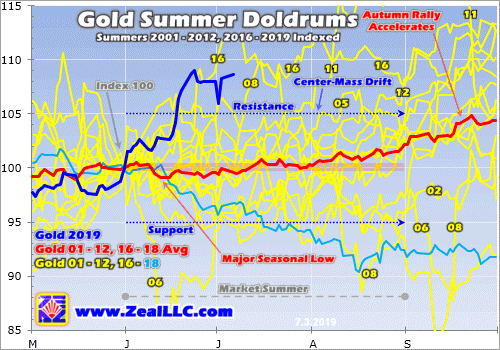
While there are outlier years, gold generally drifts listlessly in the summer doldrums much like a sailing ship trapped near the equator. The center-mass drift trend is crystal-clear in this chart. The vast majority of the time in June, July, and August, gold simply meanders between +/-5% from May’s final close. This year that equated to a probable summer range between $1240 to $1370. Gold tends to stay well within trend.
Obviously this year has proven a huge exception to that normal summer rule, with gold rocketing higher to a major bull-market breakout! Gold blasted to its best early-summer performance ever seen in all modern bull-market years. Comparing this current summer’s dark-blue line to past years’ price action certainly drives home how unique, exceptional, and special gold’s breakout surge to major new secular highs has been.
Still, understanding gold’s typical behavior this time of year is important for traders. Sentiment isn’t only determined by outcome, but by the interplay between outcome and expectations. If gold rallies 5% but you expected 10% gains, you will be disappointed and grow discouraged and bearish. But if gold rallies that same 5% and you expected no gains, you’ll be excited and get optimistic and bullish. Expectations are key.
History has proven it is wise not to expect too much from gold in these lazy market summers, particularly Junes and Julies. Occasionally gold still manages to stage a summer rally, like this year’s monster. But most of the time gold doesn’t veer materially from its usual summer-drift trading range, where it is often adrift like a classic tall ship. With range breakouts either way uncommon, there’s often little to get excited about.
In this chart I labeled some of the outlying years where gold burst out of its usual summer-drift trend, both to the upside and downside. But these exciting summers are atypical, and can’t be expected very often. Most of the time gold grinds sideways on balance not far from its May close. Traders not armed with this critical knowledge often wax bearish during gold’s summer doldrums and exit in frustration, a real mistake.
Gold’s summer-doldrums lull marks the best time of the year seasonally to deploy capital, to buy low at a time when few others are willing. Gold enjoys powerful seasonal rallies that start in Augusts and run until the following Mays! These are fueled by outsized investment demand driven by a series of major income-cycle and cultural factors from around the world. Summer is when investors should be bullish, not bearish.
The red average indexed line above encompassing 2001 to 2012 and 2016 to 2018 reveals gold’s true underlying summer trend in bull-market years. Technically gold’s major seasonal low arrives relatively early in summers, mid-June. On average through all these modern bull-market years, gold slumped 0.9% between May’s close and that summer nadir. But seasonally that’s still on the early side to deploy capital.
Check out the yellow indexed lines in this chart. They tend to cluster closer to flatlined in mid-June than through all of July. The only reason gold’s seasonal low appears in mid-June mathematically is a single extreme-outlier year, 2006. The spring seasonal rally was epic that year, gold rocketed 33.4% higher to a dazzling new bull high of $720 in just 2.0 months between mid-March to mid-May! That was incredible.
Extreme euphoria had catapulted gold an astounding 38.9% above its 200-day moving average, radically overbought by any standard. That was way too far too fast to be sustainable, so after that gold had to pay the piper in a sharp mean-reversion overshoot. So over the next month or so into mid-June, gold’s overheated price plummeted 21.9%! That crazy outlier is the only reason gold’s major summer low isn’t later.
There were 15 bull-market years from 2001 to 2012 and 2016 to 2018. That is a big-enough sample to smooth out the trend, but not large enough to prevent extreme deviations from skewing it a bit. Gold sees a series of marginally-higher lows in late June, early July, and even late July. In this dataset they came in 0.0%, 0.3%, and 0.8% higher than mid-June’s initial low. And that last late-July one arrives over 6 weeks later.
So generally there’s no hurry to deploy capital right at that initial mid-June seasonal low. Gold tends to drift nearly flatlined over the next several weeks into early July, trying traders’ patience. Buying within a few trading days of the US Independence Day holiday seems to have the best odds of catching gold near its summer-doldrums lows. Investment capital inflows usually begin ramping back up after that as traders return.
On average in these modern bull-market years, gold slipped 0.4% in Junes before rallying 0.7% in Julies. After July’s initial lazy summer week, gold tends to gradually start clawing its way back higher again. But this is so subtle that Julies often still feel summer-doldrumsy. By the final trading day in July, gold is still only 0.3% higher than its May close kicking off summers. That’s too small to restore damaged sentiment.
Since gold exited May 2019 at $1305, an average 0.3% rally by July’s end would put it at $1309. That’s hardly enough to generate excitement after two psychologically-grating months of drifting. But the best times to deploy any investment capital are when no one else wants to so prices are low. Gold’s summer doldrums come to swift ends in Augusts, which saw hefty average gains of 1.9% in these bull-market years!
And that’s just the start of gold’s major autumn seasonal rally, which has averaged strong 5.7% gains between mid-Junes to late Septembers. That is driven by Asian gold demand coming back online, first post-harvest-surplus buying and later Indian-wedding-season buying. June is the worst of gold’s summer doldrums, and the first half of July is when to buy back in. It’s important to be fully deployed before August.
These gold summer doldrums driven by investors pulling back from the markets to enjoy their vacation season don’t exist in a vacuum. Gold’s fortunes drive the entire precious-metals complex, including both silver and the stocks of the gold and silver miners. These are effectively leveraged plays on gold, so the summer doldrums in them mirror and exaggerate gold’s own. Check out this same chart type applied to silver.
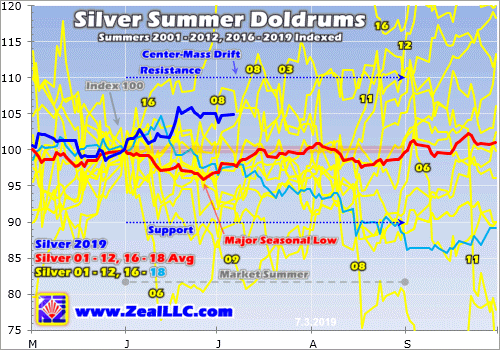
Since silver is much more volatile than gold, naturally its summer-doldrums-drift trading range is wider. The great majority of the time, silver meanders between +/-10% from its final May close. That came in at $14.56 this year, implying a summer-2019 silver trading range between $13.10 to $16.02. While silver suffered that extreme June-2006 selling anomaly too, its major seasonal low arrives a couple weeks after gold’s.
Given gold’s spectacular bull-market-breakout surge last month, silver’s summer performance this year has been utterly dismal. Normally silver amplifies gold upside by at least 2x. But silver has been bombed out and languishing for so long that investors and speculators still want nothing to do with it. Silver often acts as a gold sentiment gauge, and gold hasn’t been over $1400 long enough yet to shift psychology to bullish.
On average in these same gold-bull-market years of 2001 to 2012 and 2016 to 2018, silver dropped 4.1% between May’s close and late June. That is much deeper than gold’s 0.9% seasonal slump, which isn’t surprising given silver’s leverage to gold. Silver’s summer performances are also much lumpier than gold’s. Junes see average silver losses of 3.2%, but those are more than erased in strong rebounds in Julies.
Silver’s big 3.6% average rally in Julies amplifies gold’s gains by an impressive 5.1x! But unfortunately silver hasn’t been able to maintain that seasonal momentum, with Augusts averaging a modest decline of 0.7%. Overall from the end of May to the end of August, silver’s summer-doldrums performance tends to drift lower. Silver averaged a 0.4% full-summer loss, way behind gold’s 2.2% gain through June, July, and August.
That means silver sentiment this time of year is often worse than gold’s, which is already plenty bearish. The summer doldrums are more challenging for silver than gold. Being in the newsletter business for a couple decades now, I’ve heard from countless discouraged investors over the summers. While I haven’t tracked this, it sure feels like silver investors have been disproportionally represented in that feedback.
Since gold is silver’s primary driver, this white metal is stuck in the same dull drifting boat as gold in the market summers. Silver usually leverages whatever is happening in gold, both good and bad. But again the brunt of silver’s summer weakness is borne in Junes. Fully expecting this seasonal weakness and rolling with the punches helps prevent getting disheartened, which in turn can lead to irrationally selling low.
The gold miners’ stocks are also hostage to gold’s summer doldrums. This last chart applies this same methodology to the flagship HUI gold-stock index, which mostly closely mirrors that leading GDX VanEck Vectors Gold Miners ETF. The major gold stocks tend to amplify gold’s gains and losses by 2x to 3x, so it is not surprising that the HUI’s summer-doldrums-drift trading range is also twice as wide as gold’s own.
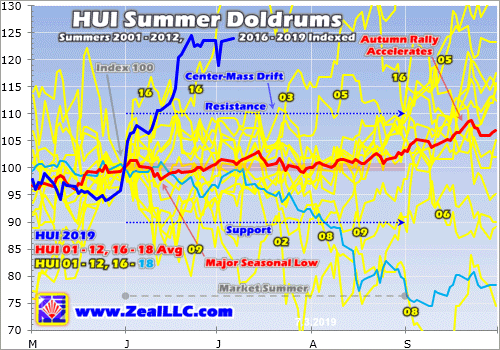
The gold miners’ stocks share silver’s center-mass summer drift running +/-10% from May’s close. This year the HUI entered the summer doldrums at 157.1, implying a June, July, and August trading range of 141.4 to 172.8. While gold stocks’ GDX ETF is too young to do long-term seasonal analysis on, in GDX terms this summer range translates to $19.43 to $23.75 this year. That’s based off a May 31st close of $21.59.
Thanks to gold’s dazzling bull-market breakout, gold stocks have defied these weak summer seasonals this year to soar to their own major decisive breakout! This high-potential contrarian sector has enjoyed its best early-summer performance ever witnessed in gold’s modern bull-market years. While I hope this incredible outperformance persists, the summer doldrums could still reassert themselves if gold retreats.
Like gold, the gold stocks’ major summer seasonal low arrives in mid-June. On average in these gold-bull-market years of 2001 to 2012 and 2016 to 2018, by then the HUI had slid 2.1% from its May close. Then gold stocks tended to more than fully rebound by the end of June, making for an average 0.6% gain that month. But there is no follow-through in July, where the gold stocks averaged a modest 0.5% loss.
Overall between the end of May and the end of July, which encompasses the dark heart of the summer doldrums, the HUI proved dead flat on average. Again two solid months of grinding sideways on balance is hard for traders to stomach, especially if they’re not aware of the summer-doldrums drift. The key to surviving it with minimum psychological angst is to fully expect it. Managing expectations in markets is essential!
But also like gold, the big payoff for weathering the gold-stock summer starts in August. With gold’s major autumn rally getting underway, the gold stocks as measured by the HUI amplify it with good average gains of 3.1% in Augusts! And that’s only the start of gold stocks’ parallel autumn rally with gold’s, which has averaged 9.3% gains from late Julies to late Septembers. Gold-stock upside resumes in late summers.
Like much in life, withstanding the precious-metals summer doldrums is less challenging if you know they’re coming. While outlying years happen, they aren’t common. So the only safe bet to make is expecting gold, silver, and the stocks of their miners to languish in Junes and Julies. Then when these drifts again come to pass, you won’t be surprised and won’t get too bearish. That will protect you from selling low.
The precious-metals sector radically bucked its seasonal-slump trend this year, surging to a record start. Gold began blasting higher on May’s final trading day, and that sharp rally carried into early June. New trade-war tariff threats were ramping up market fears, driving the US stock markets to selloff lows following late April’s all-time record highs. So traders remembered diversifying with gold and flocked back to it.
In mid-June gold’s gains accelerated after the Fed reversed its future-rate outlook from hiking back to cutting. That propelled gold to its first new bull-market highs in 3.0 years, with it surging to a 5.8-year secular high on that late-June breakout day. That momentum fed on itself and carried gold back over $1400 for the first time since early September 2013. Those awesome $1400+ levels have mostly held since.
The gold miners’ stocks naturally leveraged gold’s gains, enjoying their own epic early-summer action. The precious-metals sector is doing wildly better than last summer, when gold rolled over in mid-June on a sharp US dollar rally. Hyper-leveraged gold-futures speculators watch the dollar’s fortunes for trading cues. Hopefully gold’s huge early-summer gains can hold, and it consolidates sideways in coming weeks.
Gold’s massive and exceptional June rally was mostly fueled by speculators buying enormous quantities of gold futures. That has largely exhausted their available capital firepower, and left their collective bets on gold exceedingly bullish. These positions must be partially unwound with selling, which forces gold into a high consolidation at best and a sharp selloff at worst. So gold isn’t out of the summer-doldrums woods yet.
The inevitable coming gold-futures selling could be largely offset by investment buying. Investors are radically underinvested in gold after the second-largest and first-longest stock bull in US history, giving them big room to buy to reestablish normal portfolio allocations. Since they love chasing winners, gold’s powerful new-high psychology is starting to attract them back. Their return could dwarf gold-futures selling.
Given gold’s long-established lackluster summer-doldrums performance record, it is probably not prudent to chase this rally with gold-futures speculators effectively all-in longs and all-out shorts. But the metal and its miners’ stocks can be accumulated aggressively on any significant weakness. All portfolios need a 10% allocation in gold and gold stocks! Far-more upside is coming after recent overboughtness is worked off.
One of my core missions at Zeal is relentlessly studying the gold-stock world to uncover the stocks with superior fundamentals and upside potential. The trading books in both our popular weekly and monthly newsletters are currently full of these better gold and silver miners. Mostly added in recent months as gold stocks recovered from selloffs, their unrealized gains were already running as high as +105% this week!
If you want to multiply your capital in the markets, you have to stay informed. Our newsletters are a great way, easy to read and affordable. They draw on my vast experience, knowledge, wisdom, and ongoing research to explain what’s going on in the markets, why, and how to trade them with specific stocks. As of Q1 we’ve recommended and realized 1089 newsletter stock trades since 2001, averaging annualized realized gains of +15.8%! That’s nearly double the long-term stock-market average. Subscribe today and take advantage of our 20%-off summer-doldrums sale!
The bottom line is gold, silver, and their miners’ stocks usually drift listlessly during market summers. As investors shift their focus from markets to vacations, capital inflows wane. Junes and Julies in particular are simply devoid of the big recurring gold-investment-demand surges seen during much of the rest of the year, leaving them weak. Investors need to expect lackluster sideways action on balance this time of year.
This summer has proven an epic exception, with gold rocketing to its first major bull-market breakout in years! That has catapulted both the metal and its miners’ stocks to their best early-summer performances in gold’s modern bull-market years. But the summer doldrums could still reassert themselves as specs’ excessively-bullish gold-futures bets are bled off. So enjoy these big anomalous gains, but remain wary.
Adam Hamilton, CPA
July 8, 2019
Copyright 2000 – 2019 Zeal LLC (www.ZealLLC.com)
- Major fundamental processes and events create the large chart patterns seen on the monthly charts. It’s important for gold and stock market investors to stay focused on the big picture, both technically and fundamentally.
- To view the big technical picture for gold, please click here now. Double-click to enlarge.
- Since 2001, my proprietary weekly chart signals system has only generated five buy signals for gold bullion. Note the similarity of the latest one with the 2009 signal.
- The current signal happens with India just days away (July 5) from a possible gold tariff tax cut as part of its new budget, and the July 31 Fed meeting only a month away.
- I’ve put the odds of a gold tariff tax cut at about 50%. To view key news related to the US business cycle, please click here now. The Dow gave back most of its early morning gain yesterday, after rising on the news that Trump would temporarily halt his tariff tax bombing runs on the stock markets, corporations, and working class of America.
- Over the long term, the only way for conservative governments to compete with handouts-focused liberals at the voting polls is with working class tax cuts. By refusing to cut income taxes for America’s working class, Trump risks losing the 2020 election.
- He is now rumoured to be considering a capital gain tax cut (for stock market elitists) instead of an income tax cut for the poor. That’s going to drive more blue-collar voters towards the democrats.
- With US corporate earnings and America’s working class now looking a lot like drowning passengers on the Titanic, gold is the obvious “choice of champions”.
- To view another key big picture chart for this mighty asset, please click here now. Double-click to enlarge.
- After a major upside breakout from an enormous bullish chart pattern, a pullback is expected and normal. The bigger the chart pattern is, the bigger the pullback can be.
- Gold could easily pull back to the $1320-$1250 price zone before roaring on towards my $1550 and $2000 price targets. That shouldn’t bother investors because this type of pullback action is typical after a major breakout.
- Regardless, a shallow pullback would obviously be preferred by most gold market investors and that’s also a realistic scenario.
- Please click here now. Double-click to enlarge. There is a bull flag in play on the daily gold chart.
- A cut in India’s gold tariff tax on Friday would be the likely catalyst for an upside breakout from the flag pattern. If there is no cut, a deeper correction would likely ensue. In that scenario, gold would probably pull back to at least $1360, but more likely to $1320-$1250 by the July 31 Fed meet.
- Please click here now. There’s a lot of talk about the gold versus silver ratio right now. Silver investors should exercise caution before racing in to buy silver just based on the level of the ratio. Here’s why:
- If Trump blows the 2020 election, America could quickly become a socialist state. Stock markets would incinerate and silver (an industrial metal) could fall further against gold on the ratio chart until inflation became obvious.
- Also, the monsoon season in India isn’t going well. It’s a mini-disaster now, and it could soon become a full disaster. If the crop harvest is horrific, Indian farmers won’t have additional money to buy physical silver bullion.
- They will likely just buy the gold they need to meet their needs for religious festivals and weddings. That will put even more upside pressure on the gold/silver ratio.
- U.S. corn crops are also in trouble. The crop situation in both India and America is significant. It could produce food inflation, especially if the democrats win the U.S. election. Regardless, silver investors should wait for inflation to appear rather than try to anticipate it.
- The 80 area on the ratio chart could be support now. Silver can do well against the dollar, but investors should wait for silver to break down from the green uptrend channel I’ve highlighted on the chart before getting too excited about… silver versus gold.
- Silver and mining stocks should be part of an overall allocation to the gold asset class. Amateur stock market investors need to be careful about trying to outperform the Dow with their own growth stocks portfolio. Growth stocks should be part of a US stock market portfolio. They are not a replacement for the Dow.
- Likewise, gold market investors should be careful about owning only silver or mining stocks with the belief they will outperform gold bullion over the long run. That’s unlikely to happen. A well-diversified gold asset class portfolio includes bullion, ETFs, and individual miners. Simply put, to stand tall, own it all!
- Please click here now. Double-click to enlarge this spectacular GDX chart. Note the bullish pennant formation in play. GDX has barely retraced any of its recent near-vertical blast to the upside. The 50% Fibonacci line sits at about $23.20. Gold stock accumulators need to get toes in the water as this pullback plays out. Why? Well, perhaps because history favours the bold!
- America could descend into a permanent socialist and stagflationary quagmire after the next election. This, while India’s first “semi-sane” finance minister in years could cut the gold import tax within just days. She is highly unlikely to unveil any new policy that is negative for gold. It’s obvious that for the world’s greatest asset and the companies that mine it, all major fundamental and technical lights are green!
Special Offer For Website Readers: Please send me an Email to freereports4@gracelandupdates.com and I’ll send you my free “The Bold Go For The Gold!” report. I highlight outperforming miners in the gold price pullback zone, with key buy and sell points for eight of them!
Stewart Thomson
Graceland Updates
Stewart Thomson is a retired Merrill Lynch broker. Stewart writes the Graceland Updates daily between 4am-7am. They are sent out around 8am-9am. The newsletter is attractively priced and the format is a unique numbered point form. Giving clarity of each point and saving valuable reading time.
Risks, Disclaimers, Legal
Stewart Thomson is no longer an investment advisor. The information provided by Stewart and Graceland Updates is for general information purposes only. Before taking any action on any investment, it is imperative that you consult with multiple properly licensed, experienced and qualified investment advisors and get numerous opinions before taking any action. Your minimum risk on any investment in the world is: 100% loss of all your money. You may be taking or preparing to take leveraged positions in investments and not know it, exposing yourself to unlimited risks. This is highly concerning if you are an investor in any derivatives products. There is an approx $700 trillion OTC Derivatives Iceberg with a tiny portion written off officially. The bottom line:
Are You Prepared?
Gold closed the month of June and the quarter above $1400/oz, holding the majority of its recent gains. That does not necessitate continued strength but it is a good sign.
The technicals and fundamentals are finally in place for Gold.
It is outperforming all major currencies and the Federal Reserve is weeks away from beginning a new cycle of rate cuts. The U.S. Dollar has lost its uptrend.
The near-term outlook is very strong but if the Federal Reserve cuts rates three or four times and Gold strongly outperforms the stock market then this move can go to $1900/oz.
But let’s focus and the here and now.
This breakout in Gold potentially has quite a bit of room to run.
The weekly chart below shows how there is very little resistance from $1420/oz to the low $1500s. Moreover, there are strong measured upside targets of $1600/oz to $1700/oz.
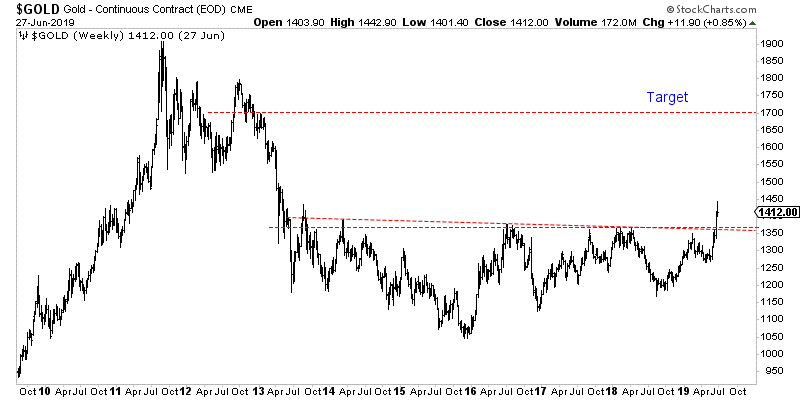
If Gold is going to trend higher towards $1600-$1700/oz, then the gold stocks are going to run much higher.
GDX is trading below $26. A break past $30-$31, would trigger a measured upside target of almost $50.
GDXJ is lagging both Gold and GDX but we know it can catch up quite quickly. First is needs to reach resistance at $50. A clean break past $50 triggers an upside target of ~$83.
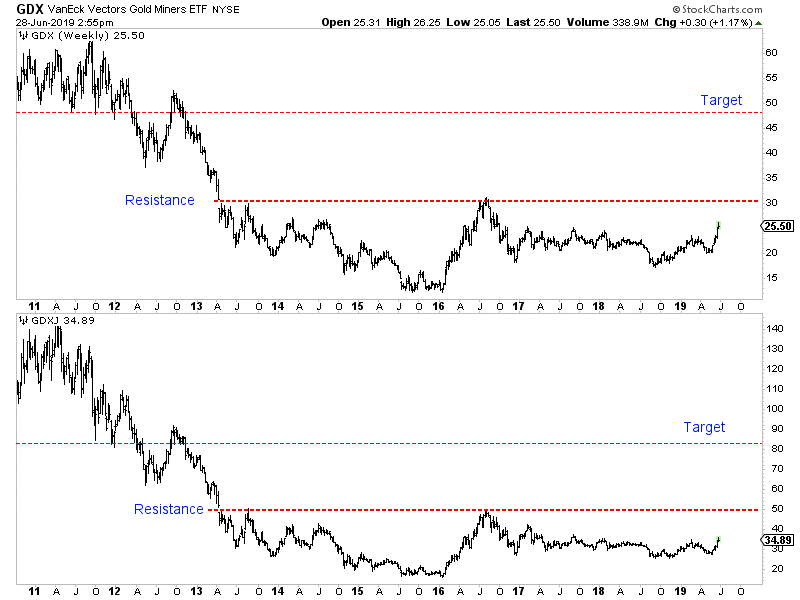
If the Fed does cut rates three or four times and either the greenback cracks more or Gold outperforms the stock market then Gold should be able to reach the $1700/oz target. If only one of those things happen then it still has a good shot to hit $1550/oz.
If the breakout gains traction then the gold stocks, which have strongly outperformed in recent weeks will continue to outperform. That is how these type of moves work.
As we noted last week, be wary of over anticipating a correction. Bull moves tend to remain overbought with overly bullish sentiment. The perfect entry point is behind us.
That being said if Gold does snap back to $1370-$1380/oz for a retest then that would be the time to put more capital work and aggressively so if you missed the last move. To learn which stocks we own and intend to buy that have 3x to 5x potential, consider learning more about our premium service.
Jordan Roy-Byrne CMT, MFTA
July 2, 2019
The gold miners’ stocks just blasted higher to a major decisive breakout this week! Driven by gold’s own huge bull-market breakout, the gold stocks surged well above vexing years-old upper resistance. The resulting new multi-year highs are a game changer, starting to shift long-apathetic sector sentiment back towards bullish. This will increasingly attract back traders, with their buying unleashing a virtuous circle of gains.
Traders usually track gold-stock fortunes with this sector’s most-popular exchange-traded fund, the GDX VanEck Vectors Gold Miners ETF. Launched in May 2006, this was the original gold-stock ETF. That big first-mover advantage has helped propel GDX to sector dominance. This week its net assets of $10.5b ran 44.6x larger than the next-biggest 1x-long major-gold-miners ETF! GDX is this sector’s leading benchmark.
And as recently as late May, neither speculators nor investors wanted anything to do with gold stocks. GDX slumped to $20.42 on May 29th, down 3.2% year-to-date. That was much worse than gold’s own slight 0.2% YTD decline then warranted. The gold stocks were really out of favor, largely ignored by apathetic traders. What a difference a month makes though, as their fortunes changed radically in June.
The gold miners started reanimating on May 31st, after Trump unleashed a bombshell warning to Mexico the evening before. He said tariffs would be imposed on all of its exports to the US if it didn’t seriously clamp down on illegal immigration across the US southern border. While Trump subsequently suspended those tariffs on Mexico’s promises to take action, that was the catalyzing event that awoke gold from its slumber.
A couple weeks ago I wrote an essay on the resulting mounting gold-stock upleg, explaining what was going on. But the developments since have been stunning, a colossal bullish surprise. Long neglected, GDX kept on marching higher mid-month leading into last week’s highly-anticipated Federal Open Market Committee decision. GDX closed at $23.67 the day before, already 15.9% higher in only several weeks.
The Fed kowtowed to stock traders’ hyper-dovish expectations and shifted its future rate bias from tightening to cutting, lighting a fire under gold. In last week’s essay I analyzed the gold bull breaking out, which was a momentous sea-change event. Gold rallied 1.0% to $1360 that day with top Fed officials forecasting a new rate cut next year. Gold-stock traders just shrugged at gold’s best close in 2.9 years.
They only bid GDX 1.4% higher to $24.00 after the Fed’s dovish shift. That only amplified gold’s gains by 1.4x, far short of the major gold stocks’ normal upside leverage to gold of 2x to 3x. While gold was high, it had tried and failed for years to break out above its $1350 resistance zone. And gold stocks suffered big and sharp selloffs after those previous forays proved unsuccessful. Traders didn’t expect this time to be different.
That Fed-Day evening New York time, Asian markets reopened as their Thursday morning rolled around. The Asian cultures have a deep cultural affinity for gold, and aggressively piled on in early trading. All that buying catapulted gold from $1358 to $1383 in about an hour! Partially thanks to Iran shooting down a big and sophisticated US surveillance drone overnight, gold’s Asia gains held in last Thursday’s U.S. trading.
Gold closed 2.1% higher that day at $1389, a decisive breakout 1%+ beyond its previous bull-market high of $1365 from way back in early July 2016! That also happened to be a 5.8-year closing high, so gold-stock traders realized big changes were afoot. They poured capital into gold stocks with a vengeance, catapulting GDX 4.4% higher on 3.5x its 3-month-average daily volume! That propelled it to $25.05 on close.
That was a critical technical level, as this GDX chart shows. It looks at the gold-stock price action of the last several years or so during gold’s own parallel bull market. GDX is rendered in blue, its key 50-day and 200-day moving averages in white and black, and 2.5-standard-deviation bands in light yellow. This leading gold-stock ETF had to decisively best years-old upper resistance at $25 to prove this time is different.
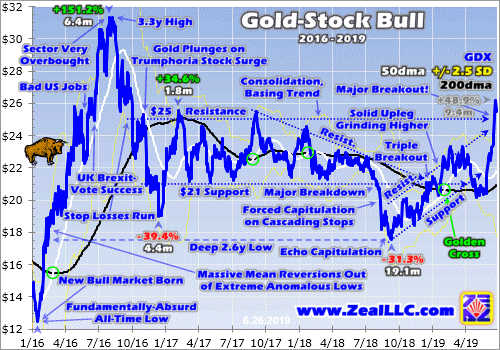
Since late 2016, GDX has largely been trapped in a giant consolidation basing trend running from $21 support to $25 resistance. $25 had proven a graveyard in the sky for gold stocks since November 2016, and needed to be overcome to change bearish psychology. GDX’s $25.05 close last Thursday on that new secular gold high was right there. But $25 resistance had to be broken decisively to impress traders.
Last Friday gold climbed another 0.7% to $1399 on pure momentum, yet gold-stock traders were worrying again. So GDX’s resulting 0.6% rally was pathetic, actually lagging gold. While not a decisive breakout over $25.25, or 1% above that long-vexing resistance line, GDX’s $25.21 close was darned close. The major gold stocks as measured by this ETF hadn’t been higher in 21.4 months. That was certainly bullish.
Last Friday and this Monday it was becoming evident that new-high psychology was taking root in gold. That is a powerful force motivating speculators and investors to buy. GDX $25 finally being materially surpassed has long been the key to unleashing this self-reinforcing sentiment in gold stocks. A couple weeks ago when GDX had merely climbed to $23.33 at best, I wrote about this coming critical breakout.
“The higher gold stocks climb, the more traders will want to buy them to ride that momentum. The more capital they deploy, the more gold stocks will rally. This normal virtuous circle of improving psychology and buying will become even more exaggerated as GDX $25 is surpassed. Seeing the highest gold-stock levels in several years will work wonders to improve sector sentiment, unleashing widespread bullishness.”
“This gold-stock upleg’s potential gains are massive spanning such a major upside breakout. Remember speculators and investors love chasing winners, so the higher gold stocks rally the more attractive they’ll look.” Nothing drives trader interest and thus capital inflows like major new highs. And GDX was right on the verge of entering that excitement-fueling zone decisively over $25 as markets opened for trading this week.
This Monday gold surged another 1.4% higher to a dazzling $1419 close! That new 6.1-year high was fueled by sheer momentum, there was little gold-moving news that day. Gold’s new-high psychology was already feeding on itself. And that enthusiasm spilled into gold stocks, with traders bidding GDX another 3.8% higher to $26.17. That was the long-awaited decisive $25 breakout, with GDX blasting 4.7% beyond!
The importance of gold stocks powering through to new 2.7-year highs cannot be overstated. Major new highs act like magnets attracting traders’ attention, interest, and capital. They prove that the long-ignored gold stocks are in bull-market-rallying mode again, portending massive gains to come. They also garner media coverage, which greatly increases the number of traders looking to ride the breakout momentum.
Since late May’s depressing low, GDX had rocketed a huge 28.2% higher in just 18 trading days! Stock traders would kill for those kinds of fast gains. And the major gold stocks’ upleg-to-date advance per this ETF had grown to 48.9% over 9.4 months. That would be impressive for any sector, but is actually still on the smaller side for the high-potential gold stocks. Their uplegs have tended to grow much larger in the past.
The last time gold was hitting new bull-market highs was in the first half of 2016. That was the maiden upleg of this bull, where gold soared 29.9% higher in just 6.7 months. The resulting excitement fueled a deluge of capital roaring into gold stocks, which skyrocketed GDX an incredible 151.2% higher in roughly that same span! While that upleg was exceptionally large, the last major gold-stock bull’s uplegs were big.
Before GDX came along, the primary gold-stock benchmark was the classic HUI NYSE Arca Gold BUGS Index. Like GDX it tracks most of the same major gold stocks, so HUI and GDX price action are usually indistinguishable. The last gold-stock bull straddling GDX’s birth saw the HUI soar 1664.4% higher over 10.8 years between November 2000 to September 2011! Those gains accrued over 12 separate uplegs.
One was an anomaly, the epic mean-reversion rebound after late 2008’s first-in-a-century stock panic. Excluding it, the other 11 normal gold-stock uplegs in that last bull averaged 80.7% gains over 7.9 months per the HUI! So GDX’s 48.9% upleg-to-date advance as of early this week remains well below precedent to be mature. Odds are it will grow much larger in line with past major uplegs before giving up its ghost.
Gold stocks paid a terrible price as gold drifted sideways over the last several years, trapped under that $1350 resistance zone which masked its in-progress bull. That’s why GDX mostly meandered between those $21 support and $25 resistance lines since late 2016. That chronic inability to break out to new highs gradually scared away the great majority of traders, leaving gold stocks incredibly undervalued.
Gold-stock prices are ultimately determined by gold, because it overwhelmingly drives their earnings. So one way to measure gold-stock “valuations” is looking at them relative to gold. This can be done using the GDX/GLD Ratio, the leading gold-stock ETF’s price divided by the flagship gold ETF’s price. That of course is the GLD SPDR Gold Shares. I last wrote about and analyzed the GGR in an early-February essay.
This Monday as GDX finally decisively broke above $25 to close at $26.17, GLD’s shares closed way up at $133.94. That made for a GGR of just 0.195x at the best gold-stock levels in several years. Yet that was still really low by historical standards. The last normal years for the gold market were arguably 2009 to 2012. That stretch was sandwiched between 2008’s stock panic and the Fed’s QE3 stock-market levitation.
The resulting extreme and irrational stock euphoria had a devastating impact on gold. But from 2009 to 2012 before markets became wildly central-bank-distorted and fake, the GDX/GLD ratio averaged 0.381x. That encompassed all kinds of gold environments, from strong bull to budding bear. So there’s no better recent span to approximate gold stocks’ “fair value” relative to gold. Applying that today is super-bullish.
At Monday’s $133.94 GLD close, that historical-average fair-value GGR would put GDX at $51.03. That is a whopping 95.0% higher than its actual close that day! Gold stocks are literally trading at just half of where they ought to be at today’s gold prices, meaning they still need to double just to catch up. And that doesn’t account for higher future gold prices or the GGR overshooting proportionally higher after mean reverting!
At best GDX has powered 151.2% higher within gold’s current bull. But during gold’s last secular bull, the HUI skyrocketed an astounding 1664.4% higher over 10.8 years! Gold stocks are one of the highest-potential sectors in the entire stock markets. When they really start running the resulting gains can truly generate life-changing wealth. That’s why contrarians are willing to suffer between their mighty bull runs.
This week’s long-awaited GDX $25 breakout is a critical technical milestone that is likely signaling much-bigger gains to come. The gold-stock surge this month is really special, actually the strongest early-summer performance for this sector in modern gold-bull history! Normally this time of year I’d be updating my gold-summer-doldrums research, highlighting the weakest time of the year seasonally for gold stocks.
Hopefully I can find time next week. This chart looks at the HUI’s average summer performances in all modern gold-bull-market years. Each summer is individually indexed to its final close in May, keeping gold-stock price action perfectly comparable regardless of prevailing gold levels. The yellow lines show 2001 to 2012 and 2016 to 2017. Last year’s summer gold-stock action is rendered in light blue for comparison.
All these lines averaged together form the red one, revealing the center-mass drift trend of gold stocks in market summers. Gold stocks’ current 2019 summer action is superimposed over all that in dark blue. As you can see, this past month’s action is the best summer start gold stocks have seen since at least 2001! They are even tracking better than the summer of 2016 in this gold bull’s mighty maiden upleg.
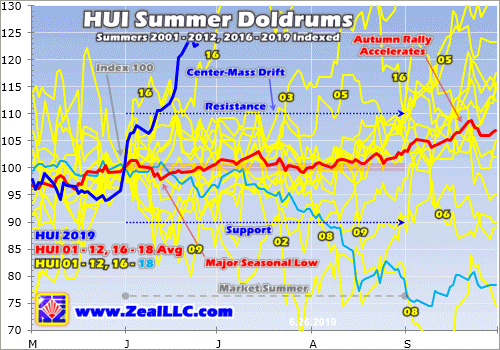
This chart really illuminates how unique gold stocks’ powerful June rally has been. This is more evidence that a sea-change sentiment shift is underway in this long-neglected sector. That sure implies the gains to come will be much larger than traders expect, driving GDX towards its own new bull highs on balance. In early August 2016, GDX hit its bull-to-date high of $31.32. That’s 19.7% higher than Monday’s breakout close.
The major gold miners’ fundamentals remain strong and bullish too, supporting much-higher stock prices. After every quarterly earnings season, I dig deep into the GDX gold miners’ fundamentals. They finished reporting their latest Q1’19 results about 6 weeks ago, and I wrote a comprehensive essay analyzing them. At that point GDX was still really out of favor, languishing under its $21 multi-year support line.
Stock prices are ultimately determined by underlying corporate earnings, and for the gold miners that is totally dependent on prevailing gold prices. Gold-mining costs are best measured in all-in-sustaining-cost terms. In Q1’19 the GDX gold miners’ AISCs averaged $893 per ounce. That’s right in line with the prior four quarters’ trend of $884, $856, $877, and $889. Gold-mining profits are going to soar with higher gold.
Gold averaged $1303 in Q1 when the major gold miners were producing it for $893. That implies they were earning $410 per ounce mined. $1400 and $1500 gold are only 7.4% and 15.1% higher from there. As the GDX gold miners’ AISCs reveal, gold-mining costs are largely fixed from quarter to quarter and don’t follow gold higher. So assuming flat AISCs, gold-mining profits surge to $507 at $1400 and $607 at $1500.
That’s 23.7% and 48.0% higher from Q1’19 levels on mere 7.4% and 15.1% gold gains from that quarter’s average price! And as of earlier this week, gold had already climbed 9.2% of that. The major gold miners’ fundamentals are already bullish, but improve greatly at higher prevailing gold prices. With earnings growth hard to come by in general stock markets this year, the gold stocks will be even more alluring.
All the stars are aligning for big gold-stock gains in coming months, with their technicals, sentiment, and fundamentals all looking very bullish. This breaking-out gold-stock upleg has excellent potential to grow much larger later this year, greatly rewarding contrarians buying in early. More and more traders are becoming aware of this sector’s huge potential, and their buying will push the gold stocks much higher.
This is not the summer to check out, but to do your homework and get deployed in great gold stocks. All portfolios need a 10% allocation in gold and its miners’ stocks! Many smaller mid-tier and junior miners have superior fundamentals and upside potential to the majors of GDX. And by the time gold stocks get really exciting again hitting their own new bull highs, much of the easy gains will have already been won.
One of my core missions at Zeal is relentlessly studying the gold-stock world to uncover the stocks with superior fundamentals and upside potential. The trading books in both our popular weekly and monthly newsletters are currently full of these better gold and silver miners. Mostly added in recent months as gold stocks recovered from selloffs, their unrealized gains were already running as high as +109% this week!
If you want to multiply your capital in the markets, you have to stay informed. Our newsletters are a great way, easy to read and affordable. They draw on my vast experience, knowledge, wisdom, and ongoing research to explain what’s going on in the markets, why, and how to trade them with specific stocks. As of Q1 we’ve recommended and realized 1089 newsletter stock trades since 2001, averaging annualized realized gains of +15.8%! That’s nearly double the long-term stock-market average. Subscribe today and take advantage of our 20%-off summer-doldrums sale!
The bottom line is gold stocks have joined gold with their own decisive breakout! GDX finally burst back above its long-oppressing $25 upper-resistance line this week. These multi-year highs are a game changer for gold stocks, ushering back long-absent bullish psychology enticing traders to return. They’ve been gone for so long that this entire gold-mining sector is deeply undervalued relative to prevailing gold prices.
That portends huge upside potential as gold and its miners’ stocks return to the limelight on their major breakouts. Traders love chasing winners to ride their upside momentum, and buying begets buying. Of course gold-stock uplegs don’t power higher in straight lines, periodic selloffs to rebalance sentiment are normal and healthy. So any material gold-stock weakness should be used to accumulate sizable positions.
Adam Hamilton, CPA
June 28, 2019
Copyright 2000 – 2019 Zeal LLC (www.ZealLLC.com
- To view what may be the most important chart in the history of markets, please click here now. Double-click to enlarge. Gold is breaking out of a massive inverse H&S bull continuation pattern, and that pattern itself may be the head of an even more massive pattern that targets the $3000 price area.
- Please click here now. Double-click to enlarge this fabulous GDX chart.
- At my https://guswinger.com swing trade service, traders are sitting on a veritable mountain of profits, having entered NUGT at about $20 barely a week ago. It’s $30 now!
- NUGT is a triple-leveraged ETF that tracks GDX. We are also long Barrick and Agnico Eagle stock, and we hold Kirkland Lake call options. If the market turns lower, we’ll not only have the profits locked in… we’ll short the market too, via DUST and JDST.
- Having said that, long-term investors should not try to top call this market. Gold is staging a major upside breakout on the charts, and the fear trade is the main price driver now. Hedges should be reduced, and aggressive speculators should hold call options on quality miners.
- Almost all major US money managers and analysts are predicting a major dovish pivot for the Fed at the upcoming July 31 meeting.
- Unfortunately for members of the Trump administration “fan club”, these analysts are basing their outlook on a peaking business cycle and the horrifying (and potentially inflationary) effects of the tariff taxes tantrum currently being thrown by the administration.
- Tariffs are a global GDP growth wrecking ball, and I’m predicting there are going to be more tariff taxes, more corporate earnings disappointments, and no tax cuts for the working class of America.
- The million-dollar question is this: What does the Fed do when the tariffs begin creating visible inflation as corporate earnings continue to fade?
- If the Fed hikes to fight the inflation, the stock market implodes and gold rallies strongly. If the Fed does nothing, the stock market likely goes nowhere and gold rallies.
- If the Fed cuts (and three big bank analysts are predicting a half point cut at the July meet), the stock market would stagger higher, and gold would probably stage a “moon shot” higher.
- Trump put more sanctions in place against Iran yesterday. Iranian government spokesmen suggested that marks the end of diplomacy. War isn’t guaranteed, but it’s certainly possible. The bottom line: Gold is the obvious place for investors to be!
- Please click here now. Double-click to enlarge. While gold stocks continue to soar, the US stock market is struggling.
- I’m long TQQQ as a swing trade. I do still have buy signals in play on the weekly charts for most of the US stock market, but my recommendation as any business cycle matures is to reduce position size on core positions. Concentrate on short-term trading to reduce risk and relieve stress.
- That’s hard for investors to do, especially when their favourite politician, Donald Trump, is the president of the United States. Like Trump, Herb Hoover was an incredibly successful businessman. When he was elected, many of America’s business leaders predicted that the business cycle was “defeated”, and America would never have a recession ever again.
- The stock market promptly fell 90% and the nation voted in socialist and war mongering madman Roosevelt. He gave the citizens food stamps, took their gold, and the banks bought stocks as the ravaged citizens sold.
- The US stock market moves higher or lower mainly on interest rate decisions from the Fed (which includes QE/QT) and on earnings growth, or lack of it.
- If the Fed cuts rates and earnings don’t start improving, money managers will begin to sell stock market rallies and rate cut decisions. The gold price rally will intensify in that situation.
- Please click here now. Double-click to enlarge. The price action on this USD vs yen chart is quite concerning, and it fits with current calls from major bank analysts for rate cuts to stop the economic slowdown from worsening.
- When the US stock market rises while the dollar falls against the yen, it suggests the rally is not based on economic growth, and risks are rising. That’s exactly what is happening now.
- Please click here now. Double-click to enlarge. Is bitcoin a safe haven? I call it an asset that makes investors richer, but whether it’s a safe haven or not is debatable.
- What is clear though, is that gold, T-bonds, yen, and bitcoin are all rallying… as money managers grow more concerned about peaking US growth in this business cycle.
- Please click here now. Double-click to enlarge this weekly GDX chart. A major breakout occurred yesterday, and a flagpole pattern has formed on the chart. A bull flag on a weekly chart in any market is very rare and carries powerful upside implications. I think a bull flag may start forming on GDX and many component stocks. When will the breakout happen?
- Well, I’ll predict that the breakout happens around the July 31 Fed meet, as an institutional money manager stampede into gold stocks is unleashed!
Special Offer For Website Readers: Please send me an Email to freereports4@gracelandupdates.com and I’ll send you my free “Junior Miners On Golden Steroids!” report. I highlight key GDXJ junior and intermediate miners that are becoming must-own stocks for the rest of 2019! I include key buy and sell levels for each stock.
Thewanks!!
Cheers
Stewart Thomson
Graceland Updates
Written between 4am-7am. 5-6 issues per week. Emailed at approx 9am daily.
Email:
Updates daily between 4am-7am. They are sent out around 8am-9am. The newsletter is attractively priced and the format is a unique numbered point form. Giving clarity of each point and saving valuable reading time.
Risks, Disclaimers, Legal
Stewart Thomson is no longer an investment advisor. The information provided by Stewart and Graceland Updates is for general information purposes only. Before taking any action on any investment, it is imperative that you consult with multiple properly licensed, experienced and qualified investment advisors and get numerous opinions before taking any action. Your minimum risk on any investment in the world is: 100% loss of all your money. You may be taking or preparing to take leveraged positions in investments and not know it, exposing yourself to unlimited risks. This is highly concerning if you are an investor in any derivatives products. There is an approx $700 trillion OTC Derivatives Iceberg with a tiny portion written off officially. The bottom line:
Are You Prepared?
Gold is finally surging to new bull-market highs! Several years after its last bull high, gold punched through vexing resistance after the Fed continued capitulating on ever normalizing. This huge milestone changes everything for gold and its miners’ stocks, unleashing new-high psychology fueling self-feeding buying. With speculators not yet all-in and investors wildly underdeployed, gold has room to power much higher.
Gold momentum has certainly been building for a major upside breakout. Back in mid-April with gold still near $1300, I wrote an essay describing the “Gold-Bull Breakout Potential” and why it was finally coming. Then a couple weeks ago with gold in the $1330s, I published another one analyzing “Gold Surges Near Breakout”. For several years higher lows had slowly compressed gold ever closer to surging over resistance.
Today’s gold bull was first born back in mid-December 2015 the day after the Fed’s initial rate hike in its just-abandoned tightening cycle. Gold’s maiden upleg was massive, rocketing 29.9% higher in just 6.7 months to $1365 in early July 2016! But that first high-water mark has proven impregnable over the 3.0 years since. Gold tried and failed to break out in 2017, 2018, and 2019, repelled near a $1350 Maginot Line.
While gold mostly climbed on balance, the lack of higher highs really impaired traders’ view on this asset. New bull highs generate enthusiasm, enticing capital inflows. When prices fail to achieve new bull bests from time to time, traders’ interest wanes. Gold was largely forgotten, even though it technically remained in a bull market since there had been no 20%+ selloff. Psychology needed new bull highs decisively over $1365.
While they were inevitable sooner or later here, I sure didn’t expect them this week. June is peak summer doldrums, the weakest time of the year seasonally for gold. And U.S. stock markets remain way up near recent all-time record highs, steeped in euphoria. That has really stunted gold demand in recent years. So the odds favored gold’s long-overdue bull-market breakout getting pushed later into July or August.
But this metal was defying weak seasonals to inch inexorably closer. It closed at $1340 on June 7th, $1342 on the 13th, and $1346 ton June 18. That was the day before the latest Fed decision. The Federal Open Market Committee had really painted itself into a corner. It had shifted dovish so hard in recent months that traders’ expectations for a new rate-cut cycle starting seemed impossible to meet.
Had the Fed not been dovish enough, the U.S. dollar would’ve surged unleashing sizable-to-serious gold-futures selling. But amazingly the FOMC managed to neither cut rates nor tease a rate cut at its next meeting in late July, yet still convince traders it was ready to cut. That masterful sleight of hand came in the quarterly dot plot, the collective future federal-funds-rate forecasts of top Fed officials. They were dovish.
Back in late September before the flagship S&P 500 stock index plunged 19.8% in a severe near-bear correction, the dots predicted 5 more rate hikes including 3 in 2019 and 1 in 2020. After December’s 9th hike of this cycle, the mid-December dot plot only moderated to 2 in 2019 and 1 in 2020. In the next dot plot in late March, this year’s hikes were struck but 2020’s lone 1 remained. That led into this week’s dot plot.
Traders were expecting almost 4 rate cuts over the next year heading into this FOMC decision, which seemed like a bridge too far. And it was! Top Fed officials’ neutral 2019 outlook of no rate hikes stayed unchanged, no cuts were added. I’m surprised the U.S. dollar didn’t surge on that, indirectly hitting gold. But the dot plot did eliminate 2020’s lone hike and pencil in 2 cuts instead, which was a major dovish shift.
So improbably in mid-June with the S&P 500 just 0.7% off late April’s all-time-record peak, gold caught a bid. Even before Wednesday’s 2pm release of the FOMC statement and dot plot, gold held steady near $1345. When the Fed headlines hit and currency traders interpreted them as dollar-bearish and sold, gold shot up to $1354. It gradually climbed from there to challenge $1360 by the end of that U.S. trading day.
Gold’s full reaction after major FOMC decisions often isn’t apparent until the next trading day though, after Asian traders can react. Their markets are closed when the Fed makes its announcements. As Asian markets opened Thursday morning which was late evening Wednesday U.S. time, gold rocketed from $1358 to $1385 in about an hour! Being a markets junkie, I always check overseas action last thing before bed.
I could hardly believe my eyes that night, and verified gold’s price in multiple trading accounts. This gold bull was breaking out! A decisive breakout is 1%+ beyond an old key level. That translated into $1379 off July 2016’s seemingly-ancient $1365 bull-to-date peak. If those gains could hold into the US close on Thursday, a decisive breakout would be confirmed. In early summer with euphoric U.S. stock markets no less!
These charts are current to Wednesday’s Fed-Day closes. In order to write and proof these essays on Thursdays, Wednesdays are the data cutoff. But as I pen these words on midday Thursday, gold is still trading at $1385 in U.S. markets (and has climbed over $1400 on June 24 – ed). This breakout looks like the real deal, the answer to contrarian investors’ prayers. And speculators’ gold-futures positioning shows room for more buying!
Because of the extreme leverage inherent in gold futures, their traders wield outsized influence over the short-term gold price. At $1350 gold, each 100-ounce contract controls $135,000 worth. Yet traders are now only required to hold $3400 cash in their account per contract. That equates to absurd maximum leverage of 39.7x. Each gold-futures dollar has up to 40x the gold-price impact as a dollar invested outright!
This chart superimposes gold in blue over speculators’ total gold-futures positions, with long upside bets in green and short downside bets in red. Note that while gold has spent several years struggling with that $1350 overhead resistance, it has carved major higher lows. That has coiled gold into a giant tightening ascending-triangle technical formation. These patterns are usually resolved with strong upside breakouts.
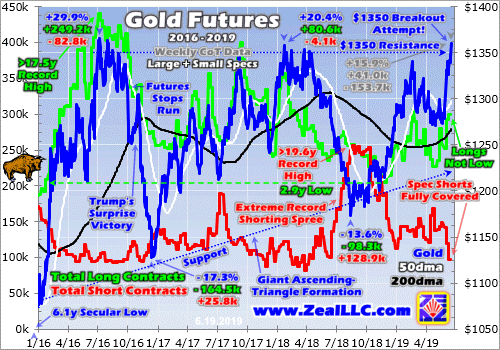
Speculators’ collective gold-futures bets are reported weekly late each Friday afternoon, current to the preceding Tuesday. So the latest data available when this essay was published was as of June 11, 6 trading days before the Fed’s shift into forecasting rate cuts coming. Gold did rally 1.5% over the next Commitments-of-Traders-report week ending this Tuesday the 18th, so specs had to be buying gold futures.
But this latest-available data still offers some great insights. Total spec longs and shorts were running 299.1k and 97.1k gold-futures contracts nearing the FOMC decision. Those shorts were actually at a 14.3-month low, leaving big room for aggressive short selling. I was worried heading into this week’s Fed meeting that it would disappoint by not being dovish enough, igniting a dollar rally triggering gold-futures shorting.
With shorts so low, the risk of a short-term gold selloff remains high. But high gold prices really stamp out any zeal traders have for short selling gold futures at extreme leverage. At 39.7x, a mere 2.5% gold rally would wipe out 100% of the capital risked by short sellers! So in the several months following recent years’ major $1350 breakout attempts, spec shorts stayed low. They didn’t climb until gold started falling.
Major gold uplegs have three stages. They are initially triggered by gold-futures short covering which quickly exhausts itself after a couple months or so. Note above that gold’s 15.9% upleg as of Wednesday was largely fueled by a massive 153.7k contracts of short covering! That was necessary after spec short selling soared to all-time-record highs late last August, forcing gold to the lows which birthed this upleg.
After first-stage short covering, the second stage is fueled by gold-futures long buying. So far that has been relatively minor, just 41.0k contracts as of the latest CoT data. Again heading into the FOMC, the specs were only long 299.1k contracts. That is much lower than at past $1350-breakout attempts, which implies much more room to keep buying from here. This is very bullish for gold unless short selling flares up.
Back in early July 2016 when gold rocketed to this bull’s initial $1365 peak, it was fueled by spec longs soaring to 440.4k contracts! That was a whopping 141.3k or 47.2% higher than the latest read. The next major $1350 breakout attempt came in early September 2017, driven by total spec longs surging way back up to 400.1k contracts. That too was 101.0k or 33.8% higher than recent levels leading into the Fed.
In late January 2018 that vexing upper resistance repelled another valiant gold breakout attempt. Total spec longs crested at 356.4k then. That was 57.3k or 19.2% higher than the latest data. So assuming there wasn’t massive gold-futures long buying leading into this Tuesday, there’s still room for gold-futures speculators to buy another 57k to 141k contracts! Such big long buying would propel gold well higher from here.
But far more bullish than that is the potential stage-three investment buying. While speculators have the leverage, investors control vastly-larger pools of capital. All the stage-one gold-futures short covering and stage-two gold-futures long buying is just an ignition mechanism to entice investors to return. Once they do, their big capital inflows can ignite strong virtuous circles of buying that persist for months or even years.
The higher gold climbs, the more investors want to own it. The more they buy, the higher gold rallies. As investors love chasing winners, nothing drives buying like new highs. New-high psychology is easily the most-powerful motivator fueling big investment buying. And gold investment remains very low even this week as gold’s bull-market breakout neared. This is evident in the leading gold ETF’s gold-bullion holdings.
The American GLD SPDR Gold Shares dominates the gold-ETF world, acting as the primary conduit for American stock-market capital to flow into and out of gold. I discussed this in depth a couple months ago in another essay on stock euphoria and gold. As of this Wednesday as gold surged back to $1360 on that Fed capitulation from tightening, GLD held 764.1 metric tons of physical gold bullion for its shareholders.
In early July 2016 when gold first hit $1365, GLD’s holdings ran far higher at 981.3t. That was 217.2t or 28.4% higher than this week’s levels! At that next major $1350 breakout attempt in early September 2017, GLD’s holdings were 836.9t or 9.5% above today’s levels. And at January 2018’s attempt this key metric for gold investment hit 849.3t, or 11.2% higher than this week. There’s lots of room for investors to buy!
GLD’s holdings haven’t really soared since the first half of 2016 when gold rocketed 29.9% higher in this bull’s maiden upleg. That was the last time new bull highs made investors excited about gold. So their potential buying from here is much bigger than the GLD holdings near $1350 breakout attempts suggest. The total GLD build in that huge H1’16 gold upleg was 351.1t or 55.7%. Consider that from recent lows.
In early October GLD’s holdings sunk to a deep 2.6-year secular low of 730.2t. That was before the US stock markets started plunging in Q4’s severe near-bear correction, so gold was deeply out of favor with stock euphoria extreme. A similar total build of 350t from there as gold returns to favor among investors would push GLD’s holdings over 1080 metric tons. That would represent a 47.9% total upleg build, not extreme.
And American stock investors pouring enough capital into GLD to force it to grow its physical-gold-bullion holdings to 1080t isn’t a stretch. Back in early December 2012 fully 15.6 months after gold’s last secular bull peaked, GLD’s holdings hit their all-time high of 1353.3 metric tons. That’s 77% higher than this week’s levels, proving investors have vast room to shift capital back into gold given their current low allocations.
One way of inferring gold investment is looking at the ratio of the value of GLD’s gold holdings to the total market capitalization of all 500 elite S&P 500 companies. From 2009 to 2012 that averaged 0.475%, for an implied gold portfolio allocation near 0.5% for American stock investors. That’s terrible, as every investor needs a 10% allocation in gold and its miners’ stocks! But 0.5% is still far higher than today’s levels.
When the SPX recently peaked at the end of April, this ratio was running around 0.12%. That’s only a quarter of that average from recent years before gold fell deeply out of favor. Today investors are so radically underinvested in gold that their portfolio allocations need to quadruple from here to merely return to quasi-normal levels! So there’s room for great amounts of capital to return to gold, driving it much higher.
Again my data cutoff for this essay was Wednesday’s close, before gold started breaking out. At that point its gold bull to date was 29.9% higher at best as of several years earlier. The last secular gold bull ran between April 2001 to August 2011. Over that 10.4-year span, gold powered a massive 638.2% higher! So gold ultimately doubling or tripling from this bull’s birthing low of $1051 certainly isn’t a stretch at all.
With this gold bull finally breaking out after several years of vexing failures, there are dozens of charts I’d like to share today. But I’m settling with three so you don’t have to read a book. Again June happens to be gold’s weakest time of the year seasonally, which gold’s breakout surge is bucking. But despite the wonderful emerging new-high psychology, gold’s advance isn’t particularly outsized even for summer doldrums.
This chart looks at gold’s average summer performances in all modern bull-market years. Each summer is individually indexed to its final close in May, keeping gold price action perfectly comparable regardless of prevailing levels. The yellow lines show 2001 to 2012 and 2016 to 2017. Last year’s summer action is rendered in light blue for easier comparison. All these lines are then averaged together into the red one.
That reveals the center-mass drift trend of gold in market summers, which include June, July, and August proper. Gold’s current 2019 summer action is superimposed over all that history in dark blue. At least as of gold’s $1360 Wednesday close following the FOMC, it was only up 4.2% summer-to-date. That is still within the typical gold summer trend of +/-5% from May’s close. This gold summer rally is big, but not extreme.
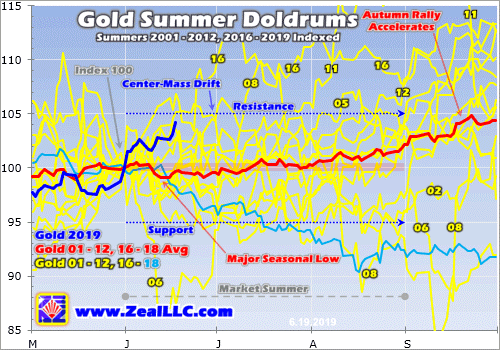
As I continue writing this essay early Thursday afternoon, gold is trading near $1386. That is up 6.2% since the end of May. In the summer of 2016 the last time gold was in favor and enjoying that new-high psychology, it rocketed as high as +12.3% summer-to-date by early July. So while early summers tend to be weak, gold can still power higher in the right conditions. And a major bull-market breakout is definitely it!
The main beneficiary of higher gold prices is the gold miners. They enjoy big profits leverage to gold as its price rallies higher. Last week I wrote a whole essay on this “Gold-Stock Upleg Mounting” where I went into leverage. The leading gold-stock benchmark is the GDX VanEck Vectors Gold Miners ETF. In mid-May I dug into its component gold miners’ latest Q1’19 results, revealing their current fundamentals.
The GDX gold miners’ average all-in sustaining costs last quarter were $893 per ounce mined. When compared to Q1’s average gold price near $1300, at $1400 and $1500 gold the major gold miners’ profits would soar 25% and 49% higher! So naturally gold-stock prices are surging with gold’s awesome bull-market breakout this week. Here’s the latest chart of gold-stock performance per GDX as of Wednesday.
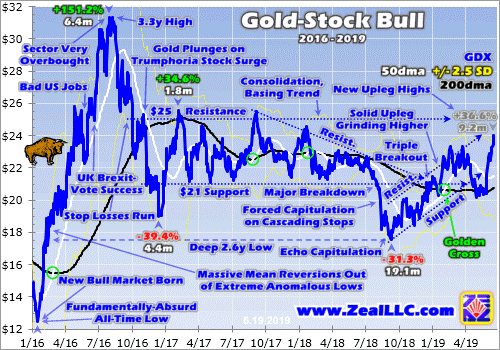
Since late 2016 the gold stocks have been trapped in a giant consolidation by gold remaining mostly out of favor with investors. That manifested in GDX terms in a major trading range running from $21 lower support to $25 upper resistance. On Fed Day as gold rallied to $1360, GDX’s price climbed to $24.00 on close. That was a 16.7-month high for this leading gold-stock benchmark, and nearing its own breakout.
Early Thursday afternoon as I pen this essay, GDX has surged again to $25. That’s right at that major resistance line of recent years. A decisive breakout from here would portend gold stocks finally being off to the races again. And that means enormous gains for contrarian speculators and investors. In essentially the first half of 2016 as gold blasted 29.9% higher, GDX skyrocketed 151.2% for huge 5.1x leverage!
As of Wednesday this current gold-stock upleg per GDX only had 36.6% gains. As gold’s own new-high psychology makes gold stocks alluring again, they should soar dramatically from here. We haven’t seen a real gold-stock upleg in several years. Just like gold, when its miners’ stocks are powering to new highs buying begets buying. Traders love chasing their gains which fuels a glorious virtuous circle of capital inflows.
For years traders have told me they were avoiding gold stocks until something big changed. And there is nothing bigger for this high-potential sector than new gold-bull highs. All the stars are aligning for big gold-stock gains in the coming months, with their technicals, sentiment, and fundamentals all looking very bullish. This is not the summer to check out, but to do your homework and get deployed in great gold stocks.
Unfortunately the major gold miners dominating GDX are failing to grow their production. That along with their large market caps means smaller mid-tier and junior gold miners with superior fundamentals will enjoy far-better upside as gold climbs higher. While GDX should amplify gold’s gains by 2x to 3x, that will be dwarfed by the epic gains in better smaller miners. Major gold uplegs are a gold-stock pickers’ market!
One of my core missions at Zeal is relentlessly studying the gold-stock world to uncover the stocks with superior fundamentals and upside potential. The trading books in both our popular weekly and monthly newsletters are currently full of these better gold and silver miners. Mostly added in recent months as gold stocks recovered from selloffs, their unrealized gains were already running as high as +108% on Wednesday!
If you want to multiply your capital in the markets, you have to stay informed. Our newsletters are a great way, easy to read and affordable. They draw on my vast experience, knowledge, wisdom, and ongoing research to explain what’s going on in the markets, why, and how to trade them with specific stocks. As of Q1 we’ve recommended and realized 1089 newsletter stock trades since 2001, averaging annualized realized gains of +15.8%! That’s nearly double the long-term stock-market average. Subscribe today and take advantage of our 20%-off summer-doldrums sale!
The bottom line is gold is finally breaking out to new bull-market highs! Somehow the FOMC managed to be dovish enough in its rate-cut outlook this week to drive US-dollar selling, which unleashed major gold buying. So gold blasted back over its bull-to-date peak from several years earlier that had oppressed it for so long. Gold hasn’t enjoyed new-high psychology since then, which is a powerfully-bullish motivating force.
New bull highs bring gold back into the limelight, making it attractive again. Traders love chasing winners to ride their upside momentum, and buying begets buying. Gold coming back into favor portends much more upside to come, with room for big buying by both gold-futures speculators and far-more-important investors. As their capital inflows push gold to new bull-market heights, the gold stocks are going to soar!
Adam Hamilton, CPA
June 24, 2019
Copyright 2000 – 2019 Zeal LLC (www.ZealLLC.com)
Gold has finally broken out to the upside.
In Asia trading on Thursday, Gold exploded through the $1360 to $1370 resistance zone and was able to hold the gains throughout the day, closing above $1395/oz.
As we pen this article, Gold has to chance to break $1400/oz by the weekend. The close of the month (and quarter) next week will provide an additional clue as to the sustainability of this strength.
The gold stocks meanwhile have been on an absolute tear. GDX is up 16 of the past 17 trading days and has gained 23% over that period. GDXJ is up 13 of the past 17 sessions and has also gained 23% during that period.
GDX closed right at resistance at $25. It could blow through it and reach a multi-year high at $27 or it could first correct and consolidate around $25.
GDX’s various indicators are very encouraging but not quite at confirmed bull market levels.
Roughly a third of GDX made new highs, which is the highest amount since August 2016. Also, 79% of miners closed above the 200-day moving average. Surpassing 90% would be quite bullish.
The GDX to S&P ratio needs to close above its recent peak to signal sustainable relative strength.
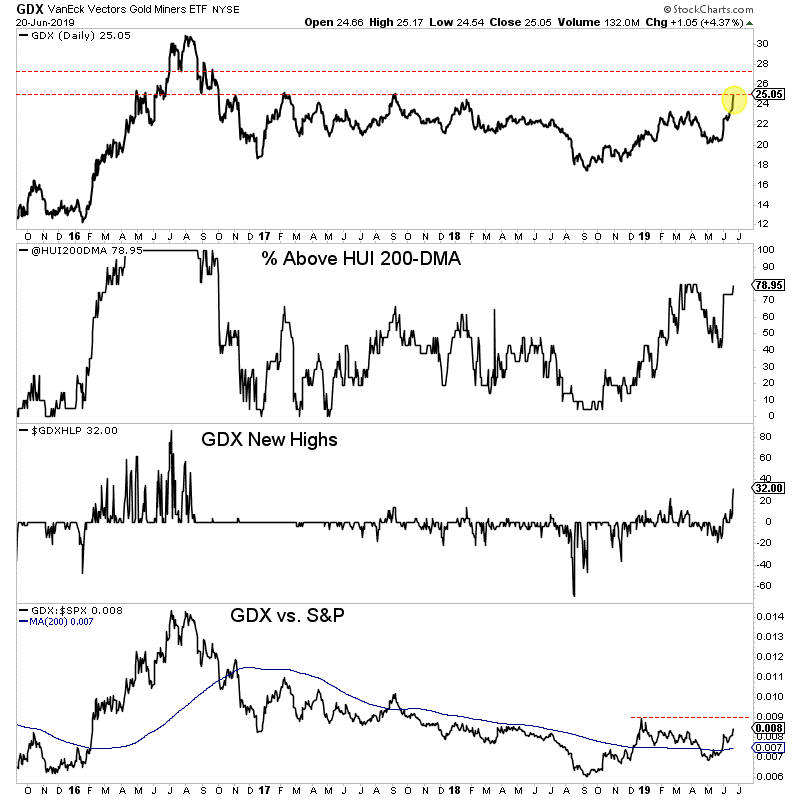
Turning to GDXJ, we see that it is slightly behind GDX in nominal and relative terms. It faces a bit of resistance here around $35 but more resistance at $37.
The percentage of GDXJ stocks above the 200-day moving average and at new highs are at very encouraging levels but need to advance higher to confirm a new bull market.
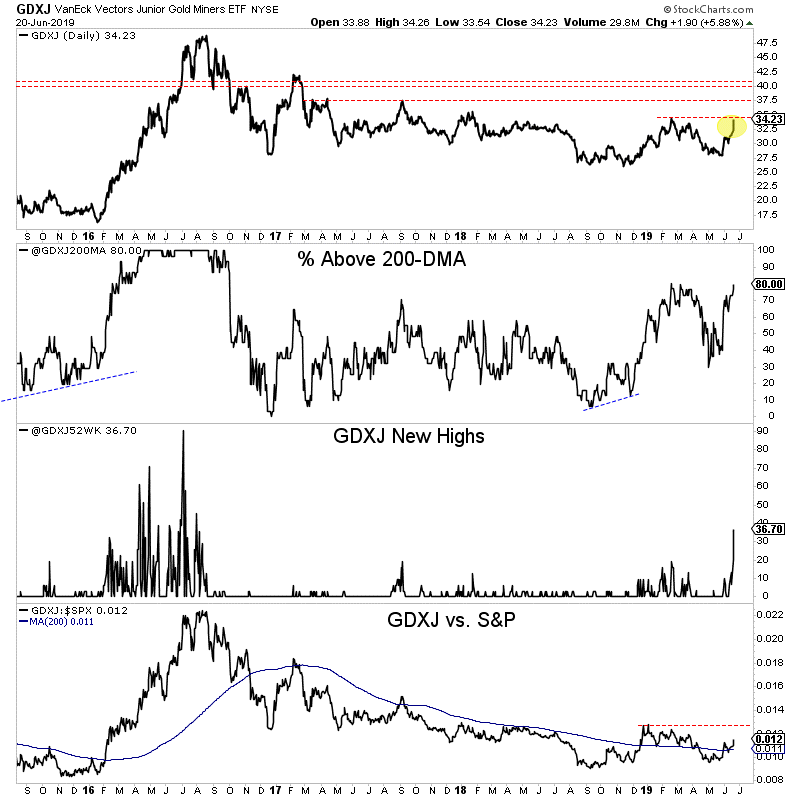
Assuming Gold maintains current strength without more than a minor retest of previous resistance then we should look for GDX and GDXJ to approach the aforementioned resistance targets. Initially, that means GDX $27 and GDXJ $37.
If the miners were to reach those targets then these various indicators should reach bull market levels at the same time.
The fundamentals are finally in place for precious metals (as we’ve mentioned in recent articles) and that, along with bullish technicians is why we should remain bullish.
Unless Gold loses the breakout gains into the end of the quarter, then I would not anticipate too much of a pullback. Bull moves tend to remain overbought with overly bullish sentiment.
As we noted last week, the gold stocks, junior gold stocks and Silver are ready to explode higher once the breakout move in Gold is confirmed. To learn which stocks we own and intend to buy that have 3x to 5x potential, consider learning more about our premium service.
By Jordan Roy-Byrne CMT, MFTA
June 21, 2019
- The powerful sell signals I have in play for U.S. stock markets at my guswinger.com trading service show no signs of abating.
- Please click here now. Double-click to enlarge this Nasdaq ETF chart.
- U.S. President Trump unleashed a huge corporate tax cut early in his presidency, and that was very positive news for the stock market. Since early 2018 though, he clearly reversed course on taxes and has donned a ghoulish “Super Tariff Taxes Man” cape.
- Trump now seems emotionally obsessed with tariff taxes, QE, rate cuts, and appears to have made no effort to reverse the massive growth in government size and debt.
- U.S. population demographics are not good. An aging population is now trying to wall in an entitlements-oriented political system that depends on the dollar as reserve currency to keep it solvent.
- Trump’s calls for more QE at the peak of the business cycle are something out of a “Twilight Zone” episode.
- QE is supposed to be an emergency policy tool reserved for severe economic crisis, not for launch at the peak of the business cycle to empower ever-more government spending and debt!
- Institutional investors are becoming very concerned (and rightly so) that Trump’s tariff taxes will push the U.S. economy into recession before the business cycle naturally does so.
- For those of us who shorted the stock market as my QQQ-NYSE signals flashed though, Trump’s actions are “making us great”.
- Please click here now. Double-click to enlarge this spectacular GDX daily chart.
- In the summer of 2018 a lot of analysts predicted a stock market crash that would drag down gold stocks (like 2008). In contrast, I suggested a stock market crash was likely, but it would be accompanied by a surge in the price of GDX.
- That’s what happened last fall, and it’s happening again now. GDX is surging higher as the US stock market nose dives!
- Note my $25-$26 target zone for GDX on this daily chart.
- Please click here now. Double-click to enlarge. My $25-$26 target zone is based partly on the weekly chart resistance in that price zone.
- A Friday NYSE close above $23 for GDX, $36 for Newmont, $46 for Agnico Eagle, and $14 for Barrick are what I’m looking for to launch a major run higher for most gold stocks. That may or may not be accompanied by a move above $1370 for gold bullion and a fresh leg down for the tariffs-infested stock market.
- Please click here now. Double-click to enlarge. That’s a look at my swing trade signals for GDX.
- There are multiple gaps in play on the daily chart. That’s very rare in any market. In time, this GDX price action may be viewed as “legendary” in the face of the stock market rout….
- If the rally continues and makes it to my target prices!
- I issued a general gold stocks profit booking call for investors and traders yesterday, but not for JNUG, which I suggest investors hold for more glorious potential gains until I get a full signal for the sector.
- Please click here now. On Sunday the Chinese government issued a white paper stating that Trump has backtracked in tariff tax negotiations. Now a travel warning has been also issued. This is going to generate additional concern for Chinese citizens who are invested in America. They pay close attention to official statements from their government.
- SPDR (GLD-NYSE) tonnage surged to the 159 level yesterday. This is clear evidence that U.S. money managers are also going for the gold! Chinese investors are reporting buying additional gold because they believe Trump cannot be trusted in negotiations.
- I predicted that Chinese investors would begin buying gold instead of investing in stock markets as the trust issue reared its ugly head, and now it’s happening. The bottom line: It really doesn’t matter whether Trump can be trusted or not.
- What matters is what U.S. and Chinese investors believe, and they clearly believe that it’s time to go for the gold!
- Please click here now. Double-click to enlarge what I believe is the most majestic-looking chart in the history of markets. All the price action taking place now is exactly what investors should expect to happen in the final right shoulder rally of a H&S bull continuation pattern. Gold’s fear trade in America and the love trade in China and India are in perfect sync, both technically and fundamentally. Investors need do only one thing now, and that is to bask in the golden glory of this historic moment in bull era time!
Special Offer For Website Readers: Please send me an Email to free reports4@gracelandupdates.com and I’ll send you my free “Golden Rockets To Pluto!” report. I highlight eight gold miners trading under $10/share that are poised for stage “multi-bagger” gains as gold breaks above $1370! I include key tactics to buy and sell each stock.
Stewart Thomson
Graceland Updates
Written between 4am-7am. 5-6 issues per week. Emailed at approx 9am daily.
Email:
Stewart Thomson is a retired Merrill Lynch broker. Stewart writes the Graceland Updates daily between 4am-7am. They are sent out around 8am-9am. The newsletter is attractively priced and the format is a unique numbered point form. Giving clarity of each point and saving valuable reading time.
Risks, Disclaimers, Legal
Stewart Thomson is no longer an investment advisor. The information provided by Stewart and Graceland Updates is for general information purposes only. Before taking any action on any investment, it is imperative that you consult with multiple properly licensed, experienced and qualified investment advisors and get numerous opinions before taking any action. Your minimum risk on any investment in the world is: 100% loss of all your money. You may be taking or preparing to take leveraged positions in investments and not know it, exposing yourself to unlimited risks. This is highly concerning if you are an investor in any derivatives products. There is an approx $700 trillion OTC Derivatives Iceberg with a tiny portion written off officially. The bottom line:
Are You Prepared?
We have written for over a year about the historical importance of the shift in Federal Reserve policy. We’ve noted that over the past 65 years in 11 of 13 rate cut cycles the gold stocks have enjoyed tremendous gains. The historical data shows an average gain of over 170% and median gain of almost 150%.
As of last Tuesday morning, the market showed an 84% chance of a rate cut by the Fed meeting in January 2020. That’s only 8 months away!
With that said, it appears odd that the gold stocks are struggling. The market tends to anticipate and discount potential news in advance. One would expect the gold stocks to begin to “price in” a rate cut, given that the market is nearly convinced a rate cut is on the horizon.
However, the historical data argues otherwise. The median and average bottom around the first rate cut is typically one and two months before that first rate cut.
The likely months for the first rate cut figure to be either September or December. If the Fed cuts rates in September, then the data argues for a bottom in August or late July. If the Fed were to cut in December, then its possible we could see a bottom earlier than a month before.
The timeline for a potential bottom in the gold stocks could line up well with the current technical outlook.
In the chart below we plot GDX along with the percentage of stocks that closed above the 200-day moving average (in the HUI) and the GDX advance decline (AD) line.
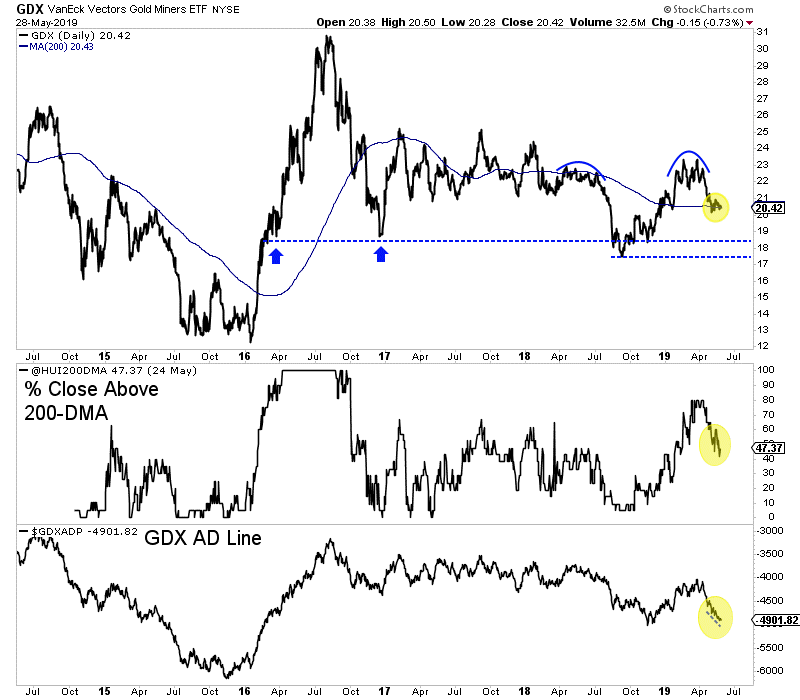
GDX is oversold on a short-term basis but remains weak. It’s AD line (an important breadth indicator) is showing a negative divergence.
Gold stocks are not oversold on a 200-day basis. As you can see, 47% of the HUI (GDX sans royalty companies) closed above the 200-day moving average.
Ultimately, I’d love to see GDX bottom around $18 in August with that aforementioned percentage below 20%. A double bottom prior to a Fed rate cut in September would trigger a strong run into year end.
In any case, the gold stocks could be setting up for a mid summer bottom and one that would be really significant if the Fed cuts rates in September. We continue to look at individual companies that are trading at excellent values and have important upcoming summer catalysts. To learn what stocks we own and intend to buy that have 3x to 5x potential, consider learning more about our premium service.
Jordan Roy-Byrne, CMT, MFTA
June 3, 2019
1. The fear trade for gold continues to gain fundamental strength. The technical picture is also solid. Please click here now. Double-click to enlarge. Gold is poised for significant upside action in the second half of this year.
2. A large bull wedge is in play as institutional investors become more concerned about the slowing global economy.
3. Please click here now. Double-click to enlarge. This Nasdaq ETF chart (QQQ-NYSE) looks particularly concerning. A break under the $177.50 price zone could be followed by a significant decline.
4. The recent peaks and troughs for the stock market are in sync with the peaks and troughs for the price of oil. If oil can’t rise with Iran being pounded by US government sanctions, something is wrong.
5. Oil could crash if there’s a softening of the sanctions and that could cause a stock market crash.
6. Please click here now. Double-click to enlarge this oil price chart. Low priced oil helps consumers, but it hurts stock market earnings. An ominous bear flag has appeared on the chart.
7. US frackers need $60 oil on a consistent basis. They help provide the stock market with the earnings growth it needs to satisfy institutional investors.
8. $60 oil on a sustained basis is just not happening right now, and I don’t expect it will happen without a major upturn in the global economy.
9. Please click here now. Institutional analysts are beginning to view the tariff taxes as a growth-inhibiting quagmire that won’t go away for a long time.
10. They are also beginning to talk about the inflationary implications of the tariffs. What happens if inflation picks up and Trump successfully pressures the Fed into leaving rates alone?
11. That could cause much greater concern about inflation amongst economists and money managers would likely turn to gold to protect their portfolios.
12. The second of half of 2019 is likely to see gold get significant investor interest… particularly if the stock market continues to weaken while inflationary pressures rise.
13. Both my short-term and medium-term stock market trade signals have moved to a “ sell ”. The long-term buy signal is still holding but it looks shaky.
14. Please click here now. Double-click to enlarge this dollar versus yen chart. The dollar looks terrible and a new leg lower seems imminent.
15. The dollar’s softness relates to lack of interest in US risk-on markets by investors. They are more interested in safety now than risk-related opportunity. That’s good news for gold!
16. The US government has referred to the tariff taxes issue as a war. In the short-term, it’s producing higher prices for US consumers and dragging down global GDP growth.
17. In the medium-term, China’s government could restrict rare earth exports to America. That would probably cause a stock market crash. If the US economy keeps softening as China begins to handle the tariffs issue more aggressively, US democrats could get elected.
18. In turn, that would put the dollar front and centre in the next economic downturn.
19. My big focus for the long-term asset allocation is the Indian stock market and gold. That’s because Indian GDP growth will almost certainly rise to 10%+ and stay there for decades.
20. This, while America probably grows at 3%-4% in a good year and averages 1%-2%. There’s only so much upside “ blood ” that the Fed can squeeze out of a QE “ stone ” for US stock market investors with that kind of growth. The demographics just aren’t there, and the entitlements are too big of a drag on the economy.
21. I’m vastly more focused on short-term trading for the US stock market now than long-term investment. I do that at www.guswinger.com where I also trade NUGT and DUST for gold stock trading enthusiasts.
22. Please click here now. Double-click to enlarge. I don’t expect much action from GDX and gold stocks until gold bursts out of the bull wedge formation and the US stock market begins another leg down.
23. That likely happens as institutional investors accept the tariff talks as an unresolvable quagmire and begin to wonder how the Fed will deal with emerging stagflation.
24. A Friday close of $23 for GDX, $14 for Barrick (GOLD-NYSE), $36 for Newmont (NEM-NYSE) and $46 for Agnico (AEM-NYSE) are the “ launchpad ” numbers for gold stock investors to focus on. When those numbers are hit, basis a Friday close, gold, silver, and the miners will be ready for a major bull run!
Special Offer For Website Readers: Please send me an Email to freereports4@gracelandupdates.com and I’ll send you my free “Gold Stock Fresh Buy & Sell Signals!” report. I highlight key signals for stocks like Kirkland Lake that offer lucrative profits for both traders and investors!
Cheers
Stewart Thomson
Graceland Updates
Written between 4am-7am. 5-6 issues per week. Emailed at approx 9am daily.
www.gracelandupdates.com
gracelandjuniors.com
www.guswinger.com
Email:
stewart@gracelandupdates.com
stewart@gracelandjuniors.com
stewart@guswinger.com
Stewart Thomson is a retired Merrill Lynch broker. Stewart writes the Graceland Updates daily between 4am-7am. They are sent out around 8am-9am. The newsletter is attractively priced and the format is a unique numbered point form. Giving clarity of each point and saving valuable reading time.
Risks, Disclaimers, Legal
Stewart Thomson is no longer an investment advisor. The information provided by Stewart and Graceland Updates is for general information purposes only. Before taking any action on any investment, it is imperative that you consult with multiple properly licensed, experienced and qualified investment advisors and get numerous opinions before taking any action. Your minimum risk on any investment in the world is: 100% loss of all your money. You may be taking or preparing to take leveraged positions in investments and not know it, exposing yourself to unlimited risks. This is highly concerning if you are an investor in any derivatives products. There is an approx $700 trillion OTC Derivatives Iceberg with a tiny portion written off officially. The bottom line:
Are You Prepared?
The mid-tier gold miners’ stocks in the sweet spot for price-appreciation potential have been struggling in recent months, grinding lower with gold. Their strong early-year momentum has been sapped by recent stock-market euphoria. But gold-mining stocks are more important than ever for prudently diversifying portfolios. The mid-tiers’ recently-reported Q1’19 results reveal their fundamentals remain sound and bullish.
The wild market action in Q4’18 emphasized why investors shouldn’t overlook gold stocks. All portfolios need a 10% allocation in gold and its miners’ stocks! As the flagship S&P 500 broad-market stock index plunged 9.2% in December alone, nearly entering a new bear market, the leading mid-tier gold-stock ETF surged 13.7% higher that month. That was a warning shot across the bow that these markets are changing.
Four times a year publicly-traded companies release treasure troves of valuable information in the form of quarterly reports. Required by the U.S. Securities and Exchange Commission, these 10-Qs and 10-Ks contain the best fundamental data available to traders. They dispel all the sentiment distortions inevitably surrounding prevailing stock-price levels, revealing corporations’ underlying hard fundamental realities.
The global nature of the gold-mining industry complicates efforts to gather this important data. Many mid-tier gold miners trade in Australia, Canada, South Africa, the United Kingdom, and other countries with quite-different reporting requirements. These include half-year reporting rather than quarterly, long 90-day filing deadlines after year-ends, and very-dissimilar presentations of operating and financial results.
The definitive list of mid-tier gold miners to analyze comes from the GDXJ VanEck Vectors Junior Gold Miners ETF. Despite its misleading name, GDXJ is largely dominated by mid-tier gold miners and not juniors. GDXJ is the world’s second-largest gold-stock ETF, with $3.6b of net assets this week. That is only behind its big-brother GDX VanEck Vectors Gold Miners ETF that includes the major gold miners.
Major gold miners are those that produce over 1m ounces of gold annually. The mid-tier gold miners are smaller, producing between 300k to 1m ounces each year. Below 300k is the junior realm. Translated into quarterly terms, majors mine 250k+ ounces, mid-tiers 75k to 250k, and juniors less than 75k. GDXJ was originally launched as a real junior-gold-stock ETF as its name implies, but it was forced to change its mission.
Gold stocks soared in price and popularity in the first half of 2016, ignited by a new bull market in gold. The metal itself awoke from deep secular lows and surged 29.9% higher in just 6.7 months. GDXJ and GDX skyrocketed 202.5% and 151.2% higher in roughly that same span, greatly leveraging gold’s gains. As capital flooded into GDXJ to own junior miners, this ETF risked running afoul of Canadian securities laws.
Canada is the center of the junior-gold universe, where most juniors trade. Once any investor including an ETF buys up a 20%+ stake in a Canadian stock, it is legally deemed a takeover offer. This may have been relevant to a single corporate buyer amassing 20%+, but GDXJ’s legions of investors certainly weren’t trying to take over small gold miners. GDXJ diversified away from juniors to comply with that archaic rule.
Smaller juniors by market capitalization were abandoned entirely, cutting them off from the sizable flows of ETF capital. Larger juniors were kept, but with their weightings within GDXJ greatly demoted. Most of its ranks were filled with mid-tier gold miners, as well as a handful of smaller majors. That was frustrating, but ultimately beneficial. Mid-tier gold miners are in the sweet spot for stock-price-appreciation potential!
For years major gold miners have struggled with declining production, they can’t find or buy enough new gold to offset their depletion. And the stock-price inertia from their large market capitalizations is hard to overcome. The mid-tiers can and are boosting their gold output, which fuels growth in operating cash flows and profitability. With much-lower market caps, capital inflows drive their stock prices higher much faster.
Every quarter I dive into the latest results from the top 34 GDXJ components. That’s simply an arbitrary number that fits neatly into the tables below, but a commanding sample. These companies represented 82.7% of GDXJ’s total weighting this week, even though it contained a whopping 72 stocks! 3 of the top 34 were majors mining 250k+ ounces, 21 mid-tiers at 75k to 250k, 7 “juniors” under 75k, and 3 explorers with zero.
These majors accounted for 13.0% of GDXJ’s total weighting, and really have no place in a “Junior Gold Miners ETF” when they could instead be exclusively in GDX. These mid-tiers weighed in at 57.6% of GDXJ. The “juniors” among the top 34 represented just 8.9% of GDXJ’s total. But only 4 of them at a mere 4.4% of GDXJ are true juniors, meaning they derive over half their revenues from actually mining gold.
The rest include a primary silver miner, gold-royalty company, and gold streamer. GDXJ has become a full-on mid-tier gold miners ETF, with modest major and tiny junior exposure. Traders need to realize it is not a junior-gold investment vehicle as advertised. GDXJ also has major overlap with GDX. Fully 29 of these top 34 GDXJ gold miners are included in GDX too, with 23 of them also among GDX’s top 34 stocks.
The GDXJ top 34 accounting for 82.7% of its total weighting also represent 37.4% of GDX’s own total weighting! The GDXJ top 34 mostly clustered between the 10th- to 40th-highest weightings in GDX. Thus over 3/4ths of GDXJ is made up by almost 3/8ths of GDX. But GDXJ is far superior, excluding the large gold majors struggling with production growth. GDXJ gives much-higher weightings to better mid-tier miners.
The average Q1’19 gold production among GDXJ’s top 34 was 149k ounces, a bit over half as big as the GDX top 34’s 267k average. Despite these two ETFs’ extensive common holdings, GDXJ is increasingly outperforming GDX. GDXJ holds many of the world’s best mid-tier gold miners with big upside potential as gold’s own bull resumes powering higher. Thus it is important to analyze GDXJ miners’ latest results.
So after every quarterly earnings season I wade through all available operational and financial results and dump key data into a big spreadsheet for analysis. Some highlights make it into these tables. Any blank fields mean a company hadn’t reported that data as of this Wednesday. The first couple columns show each GDXJ component’s symbol and weighting within this ETF as of this week. Not all are US symbols.
18 of the GDXJ top 34 primarily trade in the U.S., 5 in Australia, 8 in Canada, and 3 in the U.K. So some symbols are listings from companies’ main foreign stock exchanges. That’s followed by each gold miner’s Q1’19 production in ounces, which is mostly in pure-gold terms excluding byproducts often found in gold ore like silver and base metals. Then production’s absolute year-over-year change from Q1’18 is shown.
Next comes gold miners’ most-important fundamental data for investors, cash costs and all-in sustaining costs per ounce mined. The latter directly drives profitability which ultimately determines stock prices. These key costs are also followed by YoY changes. Last but not least the annual changes are shown in operating cash flows generated, hard GAAP earnings, revenues, and cash on hand with a couple exceptions.
Percentage changes aren’t relevant or meaningful if data shifted from positive to negative or vice versa, or if derived from two negative numbers. So in those cases I included raw underlying data rather than weird or misleading percentage changes. In cases where foreign GDXJ components only released half-year data, I used that and split it in half where appropriate. That offers a decent approximation of Q1’19 results.
Symbols highlighted in light blue newly climbed into the ranks of GDXJ’s top 34 over this past year. And symbols highlighted in yellow show the rare GDXJ-top-34 components that aren’t also in GDX. If both conditions are true blue-yellow checkerboarding is used. Production bold-faced in blue shows the handful of junior gold miners in GDXJ’s higher ranks, under 75k ounces quarterly with over half of sales from gold.
This whole dataset together compared with past quarters offers a fantastic high-level read on how mid-tier gold miners as an industry are faring fundamentally. While slightly-lower gold prices made Q1 somewhat challenging, the GDXJ miners generally fared quite well. They mostly kept costs in check, paving the way for profits to soar and really amplify gold’s overdue-to-resume bull market. That’s very bullish for their stocks.
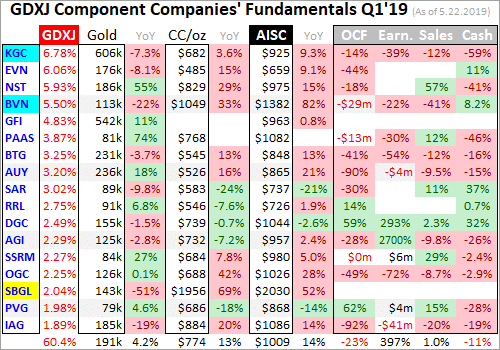
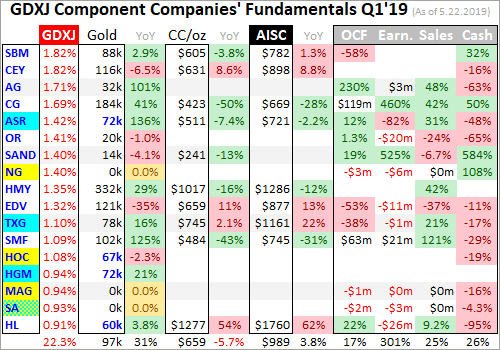
GDXJ’s managers have continued to fine-tune its ranks over this past year, making some good changes. For some inexplicable reason, one of the world’s largest gold miners AngloGold Ashanti was one of this ETF’s top holdings as discussed in Q3’18. AU was finally kicked out and replaced with a smaller major gold miner Kinross and a mid-tier Buenaventura. Together they now account for 12.3% of GDXJ’s weighting.
Reshuffling at the top makes year-over-year changes less comparable, particularly given KGC’s larger size relative to most of the rest of GDXJ’s stocks. 4 other smaller stocks also climbed into this ETF’s top-34 ranks. As GDXJ is largely market-cap weighted, it is normal for companies to rise into and fall out of the top 34’s lower end. All these year-over-year comparisons are across somewhat-different top-34 stocks.
Production has always been the lifeblood of the gold-mining industry. Gold miners have no control over prevailing gold prices, their product sells for whatever the markets offer. Thus growing production is the only manageable way to boost revenues, leading to amplified gains in operating cash flows and profits. Higher production generates more capital to invest in expanding existing mines and building or buying new ones.
Gold-stock investors have long prized production growth above everything else, as it is inexorably linked to company growth and thus stock-price-appreciation potential. The top 34 GDXJ gold miners excelled in that department, growing their aggregate Q1 output by a big 15.6% YoY to 4.6m ounces! That’s impressive, trouncing both the major gold miners dominating GDX as well as the entire world’s gold-mining industry.
Last week I analyzed the GDX majors’ Q1’19 results, showing they are still struggling to replace depleting production. The GDX top 34’s total output plunged a sharp 6.3% YoY to 8.8m ounces, but if adjusted for a recent in-process mega-merger that decline moderates to 0.2% YoY. That’s still much worse than the world gold-mining industry as a whole, as reflected in the World Gold Council’s comprehensive quarterly data.
Total global gold production in Q1’19 climbed 1.1% YoY to 27.4m ounces, which the majors still fell well short of. The GDXJ mid-tiers were able to enjoy very-strong growth because this ETF isn’t burdened by the struggling majors. Again GDXJ’s components start at the 10th-highest weighting in GDX. The 9 above that averaged huge Q1 production of 537k ounces, which is fully 3.6x bigger than the GDXJ-top-34 average!
The more gold miners produce, the harder it is to even keep up with relentless depletion let alone grow their output consistently. Large economically-viable gold deposits are getting increasingly difficult to find and ever-more-expensive to develop, with low-hanging fruit long since exploited. But with much-smaller production bases, mine expansions and new mine builds generate big output growth for mid-tier golds.
Their awesome Q1 production surge wasn’t just from the new components climbing into the ranks of the top 34 over this past year. The average growth rate of all these companies producing weighed in at 16.1% YoY, right in line with the 15.6% total growth. The law-of-large-numbers growth limitations also apply to gold miners’ market capitalizations. The GDXJ top 34 averaged just $1.7b in the middle of this week.
Last week the GDX top 34 sported a far-higher average of $5.2b. With the mid-tiers generally less than a third as big as the majors, their stock prices have much-less inertia. Capital inflows as gold stocks return to favor on gold rallying propel mid-tier stocks to much-higher levels faster than majors. They truly are the sweet spot of the gold-stock realm, not bogged down like the majors with way less risk than the juniors.
Also interesting on the GDXJ production front last quarter was silver. This “Junior Gold Miners ETF” also includes major silver miners, both primary and byproduct ones. The GDXJ top 34’s silver mined surged 13.8% higher YoY to 26.5m ounces! For comparison the GDX top 34’s total reported silver output of 27.3m actually plunged 25.2% YoY. Even mega-merger-adjusted their silver production still fell 8.0% YoY.
The mid-tier gold miners continue to prove all-important production growth is achievable off smaller bases. With a handful of mines or less to operate, mid-tiers can focus on expanding them or building a new mine to boost their output beyond depletion. But the majors are increasingly failing to do this from the already-high production bases they operate at. As long as majors are struggling, it is prudent to avoid them.
GDXJ investors would be better served if this ETF contained no major gold miners producing over 250k ounces a quarter on average. They still command over 1/8th of its weighting, which could be far better reallocated in mid-tiers and juniors. If VanEck kept the major gold miners in GDX where they belong, it would give GDXJ much-better upside potential. That would make this ETF more popular and successful.
In gold mining, production and costs are generally inversely related. Gold-mining costs are largely fixed quarter after quarter, with actual mining requiring about the same levels of infrastructure, equipment, and employees. So the higher production, the more ounces to spread mining’s big fixed costs across. Thus with sharply-higher YoY production in Q1’19, the GDXJ top 34 should’ve seen proportionally-lower costs.
There are two major ways to measure gold-mining costs, classic cash costs per ounce and the superior all-in sustaining costs per ounce. Both are useful metrics. Cash costs are the acid test of gold-miner survivability in lower-gold-price environments, revealing the worst-case gold levels necessary to keep the mines running. All-in sustaining costs show where gold needs to trade to maintain current mining tempos indefinitely.
Cash costs naturally encompass all cash expenses necessary to produce each ounce of gold, including all direct production costs, mine-level administration, smelting, refining, transport, regulatory, royalty, and tax expenses. In Q1’19 these top-34-GDXJ-component gold miners that reported cash costs averaged $730 per ounce. That was up a sizable 5.4% YoY, and much worse than the GDX top 34’s $616 average.
These were the highest average mid-tier cash costs seen in the 12 quarters I’ve been doing this research, which was potentially concerning. Thankfully that was heavily skewed by some extreme outliers relative to this sector and their own history. Peru’s Buenaventura saw cash costs soar 33% YoY to $1049! That was a one-off anomaly driven by the company halting one of its key mines in January to centralize operations.
Two major South African miners saw really-high cash costs too, Sibanye’s eye-popping $1956 per ounce and Harmony’s $1017. South Africa’s former gold juggernaut has been struggling for years, facing endless government corruption and very-deep and expensive mines. Sibanye in particular really needs to get kicked out of GDXJ, as it is now a primary platinum-group-metals miner at well over 5/8ths of Q1 revenues.
Finally Hecla’s cash costs skyrocketed 54% YoY to $1277 in Q1, mainly due to ongoing problems at its Nevada operations. It actually suspended 2019 production and cost guidance on these, which certainly isn’t a good sign! None of these 4 gold miners represent mid-tiers as a whole. Excluding them, the rest of the GDXJ top 34 averaged excellent cash costs of just $622 last quarter. That’s on the low end of the range.
Way more important than cash costs are the far-superior all-in sustaining costs. They were introduced by the World Gold Council in June 2013 to give investors a much-better understanding of what it really costs to maintain gold mines as ongoing concerns. AISCs include all direct cash costs, but then add on everything else that is necessary to maintain and replenish operations at current gold-production levels.
These additional expenses include exploration for new gold to mine to replace depleting deposits, mine-development and construction expenses, remediation, and mine reclamation. They also include the corporate-level administration expenses necessary to oversee gold mines. All-in sustaining costs are the most-important gold-mining cost metric by far for investors, revealing gold miners’ true operating profitability.
The GDXJ-top-34 AISC picture in Q1’19 looked much like the cash-cost one. Average AISCs defied much-higher production to surge 6.0% higher YoY to $1002 per ounce! While still far below Q1’s average gold price of $1303, those were the highest AISCs seen by far since at least Q2’16 when I started this thread of research. But again that was heavily skewed by those same 4 gold miners struggling with sky-high costs.
Excluding BVN’s $1382, SBGL’s insane $2030, HMY’s $1286, and HL’s extreme $1760, the rest of the GDXJ top 34 averaged a far-better $891 per ounce. That was 5.8% lower than Q1’18’s average, indeed reflecting fast-growing output. It was also right in line with the 2017-and-2018 quarterly average of $903, as well as the top 34 GDX majors’ Q1’19 average of $893. Most mid-tier golds are keeping costs under control.
Interestingly gold-mining costs tend to peak in Q1s before drifting lower in subsequent quarters. That’s because gold miners often make capital improvements and sequence mining in such a way that Q1s see the lowest ore grades and thus lowest production. I discussed this in some depth last week in my GDX Q1’19 essay. Odds are the GDXJ mid-tiers’ costs will decline significantly in coming quarters as output ramps.
Yet even at that distorted artificially-high Q1 average AISC of $1002, the elite GDXJ gold miners have great potential to enjoy surging profits and hence stock prices as gold recovers. The average gold price in Q1’19 drifted 1.9% lower YoY to $1303. That implies the mid-tier miners were averaging profits around $301 per ounce. Gold is due to head far higher as these bubble-valued stock markets face an overdue bear.
That will rekindle gold investment demand like usual, those new capital inflows fueling a major gold upleg. A mere 7.7% advance from $1300 would carry gold to $1400, and just 15.4% would hit $1500. Those are modest and easily-achievable gains by past-gold-upleg standards. During essentially the first half of 2016 after major stock-market selloffs, gold blasted 29.9% higher in 6.7 months! Gold can rapidly return to favor.
At $1300 and Q1’s $1002 average AISCs, the major gold miners are still earning a very-healthy $298 per ounce. But at $1400 and $1500 gold, those profits soar to $398 and $498. That’s 33.6% and 67.1% higher on relatively-small 7.7% and 15.4% gold uplegs from here! And if the mid-tiers’ average AISCs retreat back near $900 without the outliers, that profits growth rockets to 67.8% at $1400 and 101.3% at $1500!
The gold miners’ awesome inherent profits leverage to gold is why this beaten-down forsaken sector is so darned attractive. The major gold stocks of GDX tend to amplify gold uplegs by 2x to 3x, and the mid-tier miners of GDXJ usually do much better. As gold rallies on renewed investment demand as stock markets weaken, better mid-tier gold stocks soar dramatically multiplying investors’ wealth. This is a must-own sector.
While investors continue to harbor serious apathy for gold stocks, the mid-tier miners’ costs remain well-positioned to fuel monster profits growth in a higher-gold-price environment. This is a stark contrast to the rest of the markets, where rising earnings are looking to be scarce. Investors love higher profits, and few if any sectors will rival the gold miners’ earnings growth. It was already underway in Q1 on higher production.
In terms of hard accounting numbers, the GDXJ top 34’s total sales grew 5.0% YoY to $4.9b in Q1’19. That was the result of 15.6%-higher gold output easily offsetting the 1.9%-lower average gold price last quarter. Again the mid-tiers just trounced the majors, with the GDX top 34’s sales dropping a sharp 5.2% YoY when adjusted for the in-progress mega-merger between elite gold majors Newmont and Goldcorp.
The higher sales among the top 34 GDXJ stocks also drove impressive 22.2% YoY GAAP profits growth to a total of $197m in Q1! That again reveals the rising-cost problems are isolated in a handful of GDXJ components, not mid-tier miners as a whole. The majors of GDX again fared much worse last quarter, seeing earnings fall 7.2% YoY when accounting for that mega-merger. Mid-tiers are really outperforming.
The one blemish on the accounting front was operating cash flows generated, which fell 17.7% YoY in total among the GDXJ-top-34-component stocks to $1.1b. There were no individual-company disasters which stood out, just weaker cash flows across the board. Still the mid-tier miners were producing healthy amounts of cash as the big profits gap between their AISCs and prevailing gold prices last quarter implied.
The GDXJ top 34’s overall cash treasuries fell a similar 20.4% YoY in Q1 to $5.1b, reflecting lower OCFs. But less cash isn’t necessarily negative, as gold miners tap their cash hoards when they are building or buying expansions or mines. So declining cash balances suggest more investment to grow production in future quarters, which is always good news in this sector. The mid-tier golds’ Q1’19 results were bullish.
GDXJ’s mostly-mid-tier component list of great gold miners is really faring well, especially compared to the struggling large gold miners. Investors looking to ride this gold-stock bull should avoid the world’s biggest gold producers and instead deploy their capital in the mid-tier realm. The best gains will be won in individual smaller gold miners with superior fundamentals, plenty of which are included within GDXJ.
Despite being the world’s leading gold-stock ETF, GDX needs to be avoided. The major gold miners that dominate its weightings are struggling too much fundamentally, unable to grow their production. Capital will instead flow into the mid-tiers, juniors, and maybe a few smaller majors still able to boost their output and thus earnings going forward. None of this is new, but the major and mid-tier disconnect continues to worsen.
Again back in essentially the first half of 2016, GDXJ skyrocketed 202.5% higher on a 29.9% gold upleg in roughly the same span! While GDX somewhat kept pace then at +151.2%, it is lagging GDXJ more and more as its weightings are more concentrated in stagnant gold mega-miners. The recent big mergers are going to worsen that investor-hostile trend. Investors should buy better individual gold stocks, or GDXJ.
One of my core missions at Zeal is relentlessly studying the gold-stock world to uncover the stocks with superior fundamentals and upside potential. The trading books in both our popular weekly and monthly newsletters are currently full of these better gold and silver miners. Mostly added in recent months as gold stocks recovered from deep lows, their prices remain relatively low with big upside potential as gold rallies!
If you want to multiply your capital in the markets, you have to stay informed. Our newsletters are a great way, easy to read and affordable. They draw on my vast experience, knowledge, wisdom, and ongoing research to explain what’s going on in the markets, why, and how to trade them with specific stocks. As of Q1 we’ve recommended and realized 1089 newsletter stock trades since 2001, averaging annualized realized gains of +15.8%! That’s nearly double the long-term stock-market average. Subscribe today for just $12 per issue!
The bottom line is the mid-tier gold miners are thriving fundamentally. They are still rapidly growing their production while majors suffer chronic output declines. Most mid-tiers are holding the line on costs, which portends strong leveraged profits growth as gold continues grinding higher on balance. The performance gap between the smaller mid-tier and junior gold miners and larger major ones is big and still mounting.
Investors and speculators really need to pay attention to this intra-sector disconnect. Gold and its miners’ stocks should power far higher in coming years as the lofty general stock markets roll over. But the vast majority of the gains will be concentrated in growing gold miners, not shrinking ones. This means the mid-tier and junior gold miners will far outperform the majors as gold powers higher on weaker stock markets.
Adam Hamilton, CPA
May 27, 2019
Copyright 2000 – 2019 Zeal LLC (www.ZealLLC.com)
If you would like to receive our free newsletter via email, simply enter your email address below & click subscribe.
CONNECT WITH US
Tweets
Tweet with hash tag #miningfeeds or @miningfeeds and your tweets will be displayed across this site.
MOST ACTIVE MINING STOCKS
Daily Gainers
 |
CMB.V | +900.00% |
      |
RLC.AX | +100.00% |
      |
NSE.V | +76.19% |
      |
FEX.V | +50.00% |
      |
CRB.AX | +50.00% |
      |
MRQ.AX | +33.33% |
      |
CRD.V | +33.33% |
      |
KGD.AX | +33.33% |
      |
UCU.V | +32.41% |
      |
AGD.AX | +30.00% |

 Follow us on Twitter
Follow us on Twitter Become our facebook fan
Become our facebook fan







